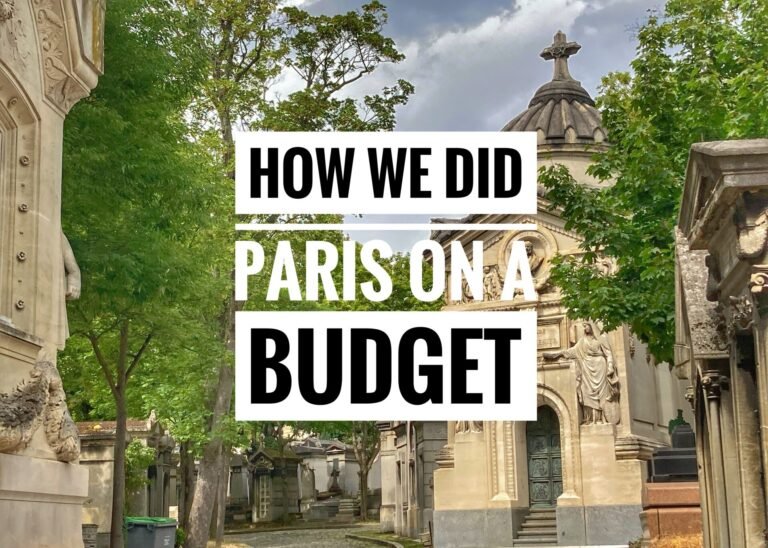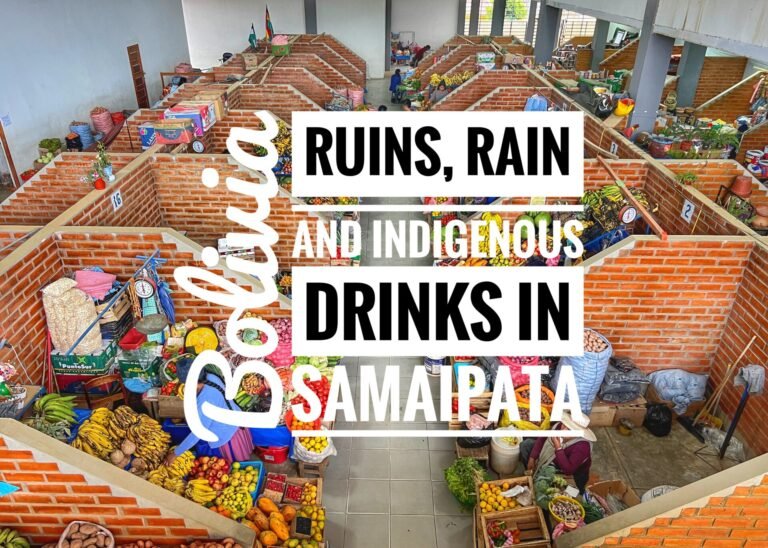
The UNESCO World Heritage city of Arequipa is Peru’s second biggest city, but a mere 1/10th the size of Lima. However, it’s very competitive and packs a big punch in terms of architectural splendor, historical significance and culinary gifts. In fact, it’s a culinary powerhouse on par with Lima. All types of Peruvian cuisine are represented here, as well as multiple international and vegan/vegetarian options. Furthermore, it has a climate that rivals San Diego and it is shielded by three dramatic snow-capped volcanoes.
And finally, its white Baroque architecture drapes the city in a facade that is unlike any other place we’ve been in Latin America and one that for us, was surprisingly a bit reminiscent of Italy. According to our free walking tour guide, “La Ciudad Blanca,” or “White City,” was named so for two reasons…the evident color of the buildings, and the color of the people, who during colonial times were 70% Spaniards. It seemed like a perfect place to plop down for nine days.
Getting There
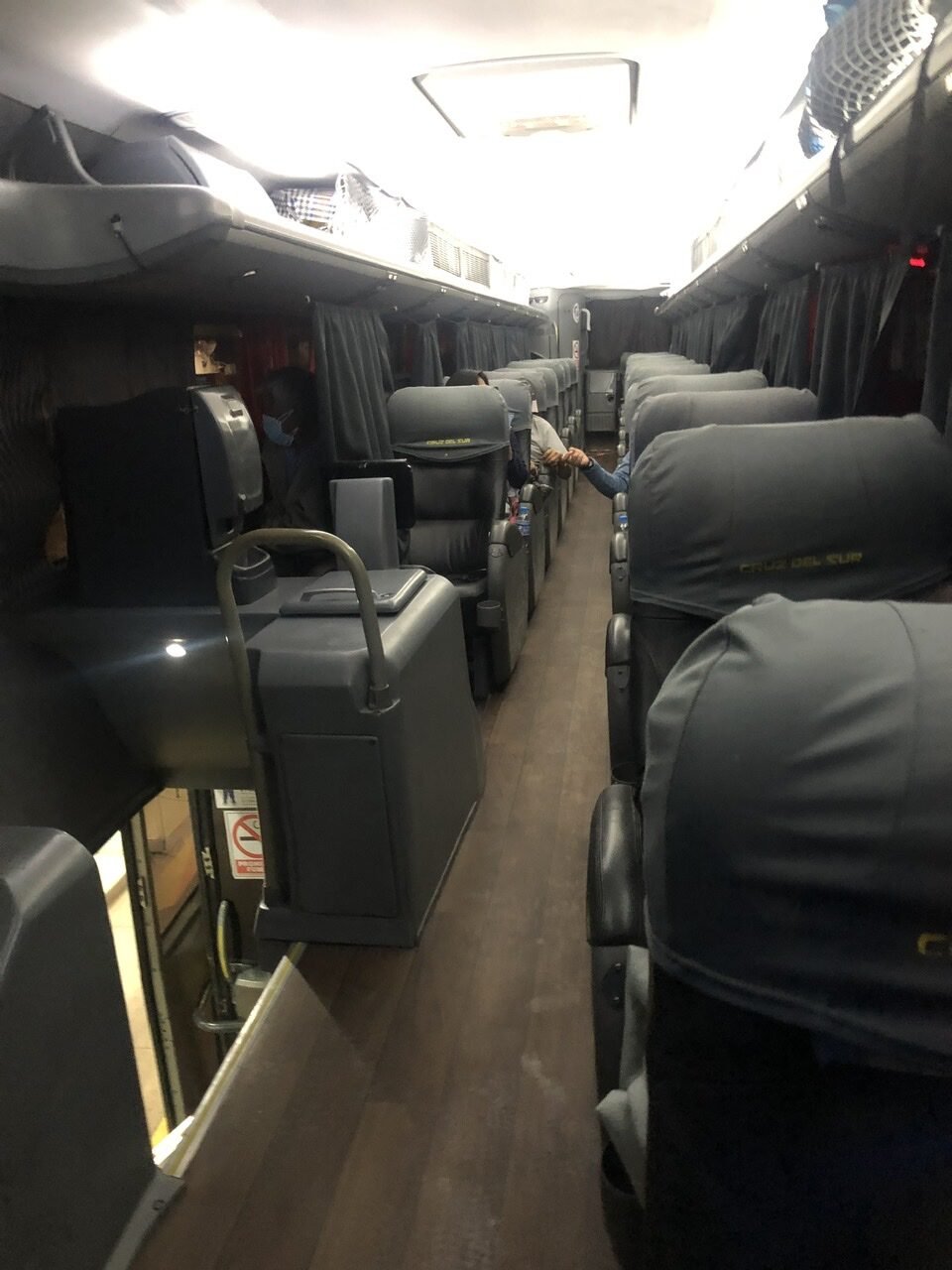
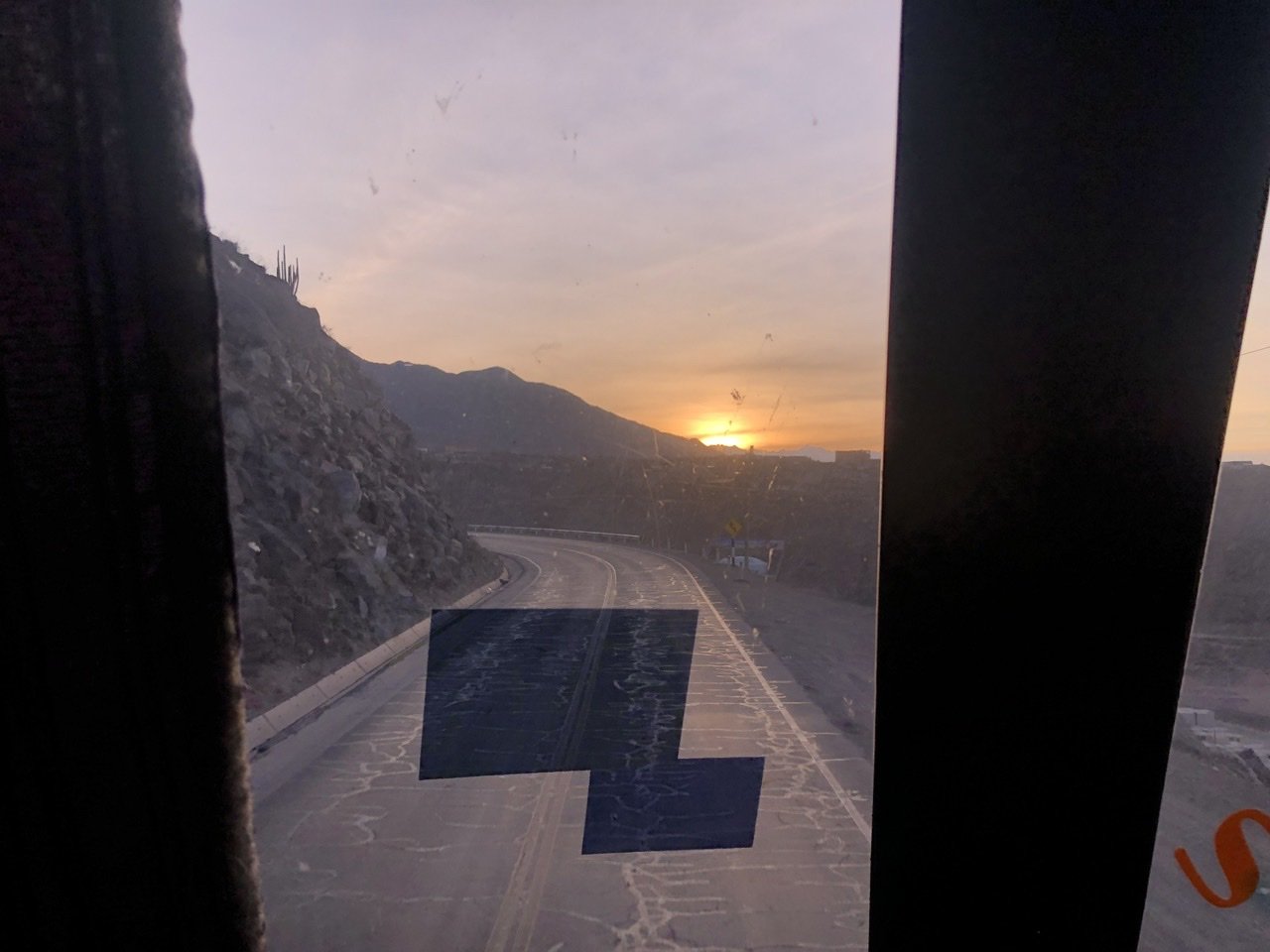
We arrived to Arequipa by a 10 1/2 hour overnight bus from Cusco. We took the “luxury” bus line Cruz del Sur, which is highly rated and safe, although a bit more expensive at S70 sols or $18/ticket than local bus lines. The bus, as is typical is Latin America, blasted the AC all night despite chilly temperatures outside. Fortunately, we’ve learned that lesson and were dressed like eskimos. The seats reclined 140 degrees with foot rests and individual TVs so pretty manageable, even overnight. Not that we slept much. Still, we were in the best seats (top floor, front seats) so in our groggy stupor, we got to admire views of the Andes as we rolled into Arequipa at sunrise.
Our Accommodation
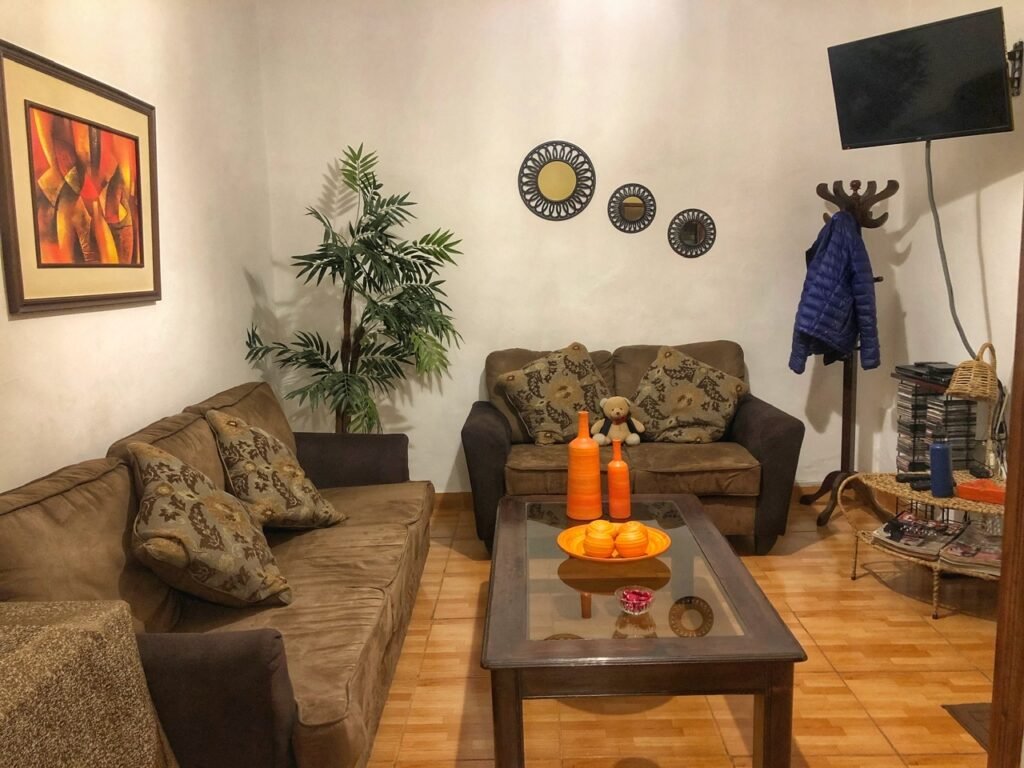
Our wonderful Airbnb hosts, Rosita and Frederico, allowed us to stumble in at 6:30 am so we could crash immediately. This was after we got ripped off by a taxi driver, also in our sleepless daze. Our living room was also furnished complete with teddy bears and other cute touches to greet us. We had a full space of our own for $20/night and it was a 15-minute walk to the historic center.

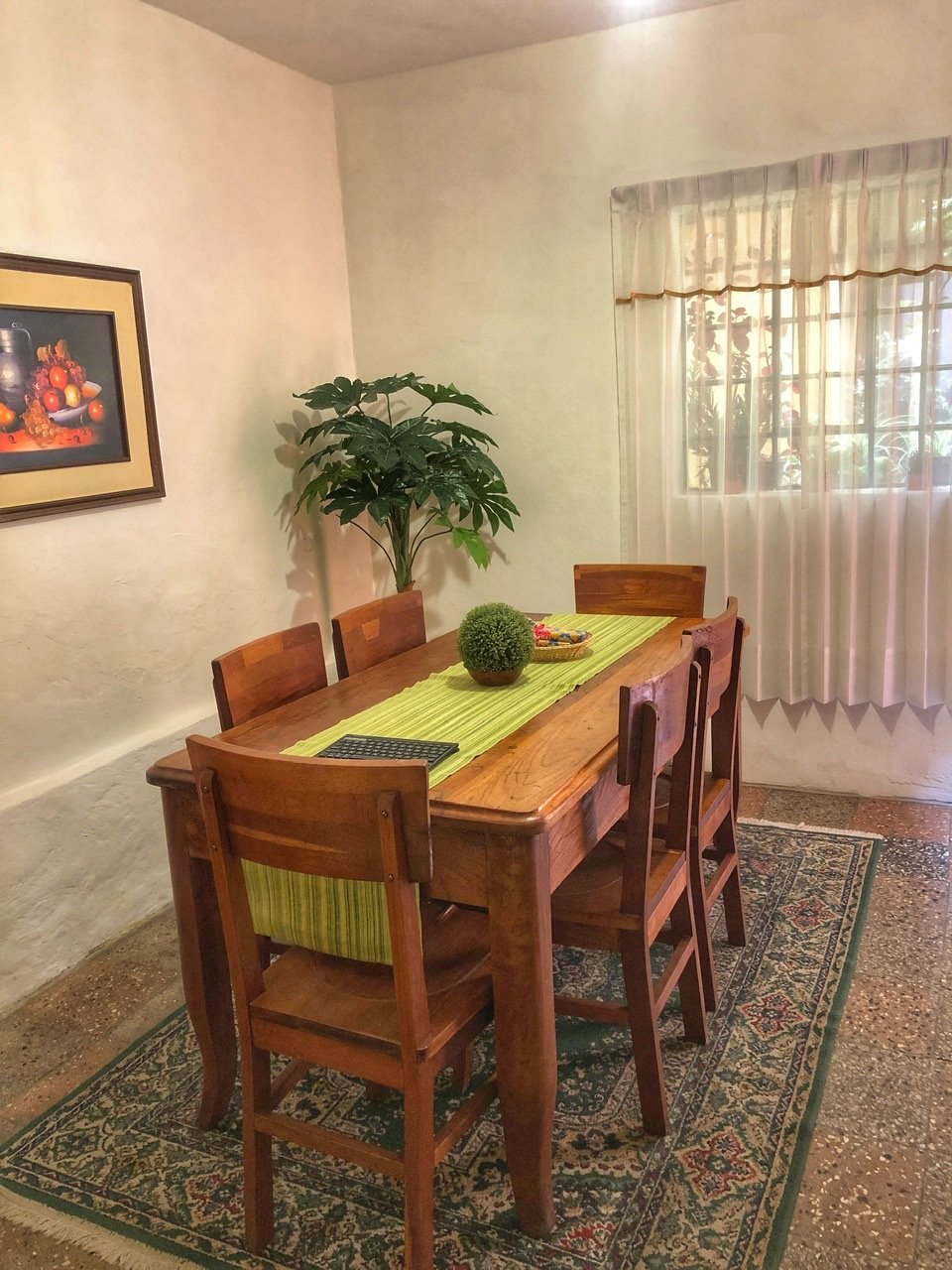
The bedroom was simple, but the bed and pillows were super comfy. Just what we needed at 7 am. Also, Rosita sweetly provided us with coffee, tea, chocolate and waters. Because unfortunately, we had returned to a country where you couldn’t drink the tap water. Quite a change after enjoying this luxury in Colombia.
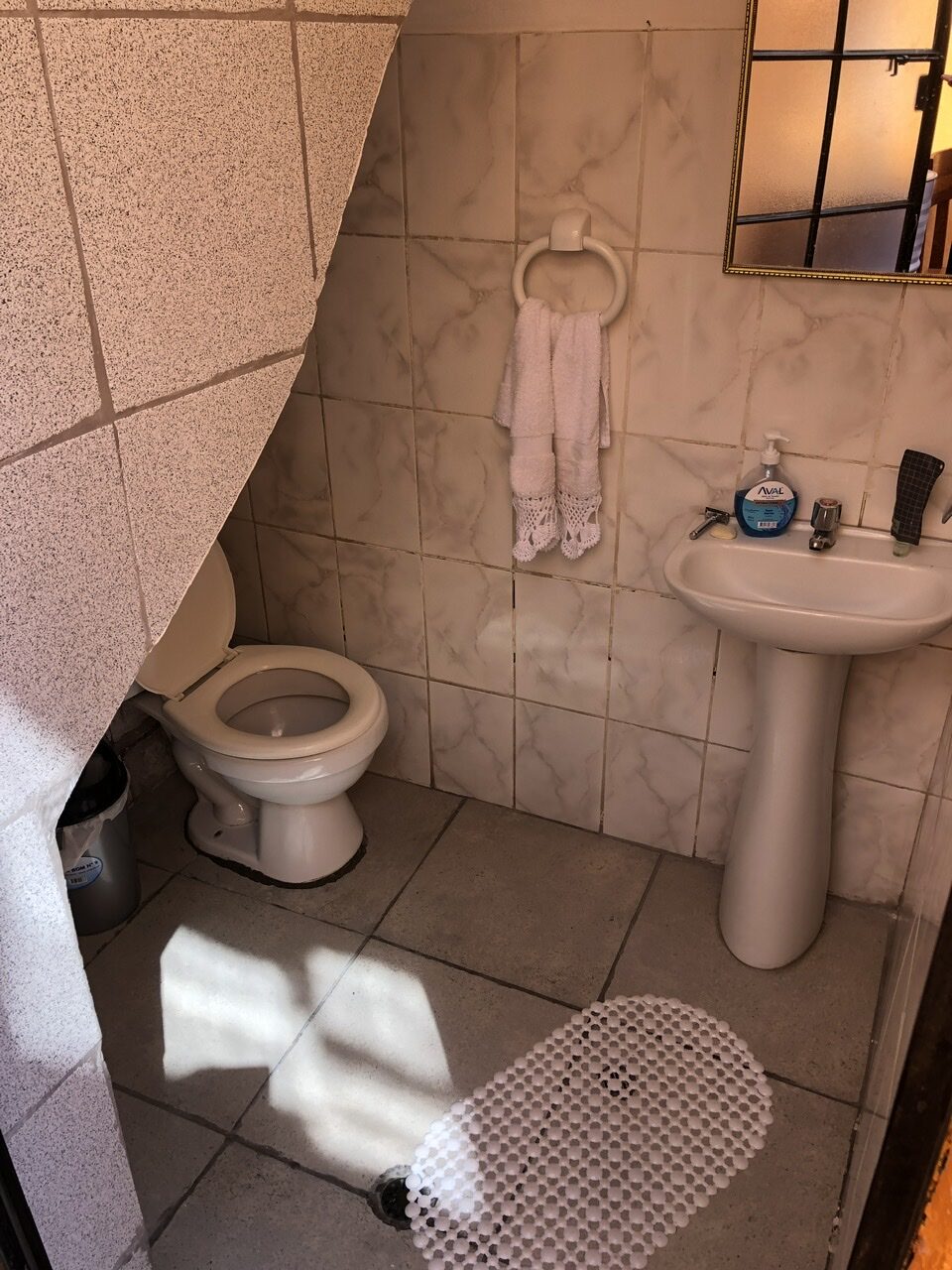
We’re also evidently back in a country where it’s common to be able to sit on the toilet while showering in the same space. Word to the wise…keep flip flops near the bathroom door to avoid wet socks in the middle of the night!
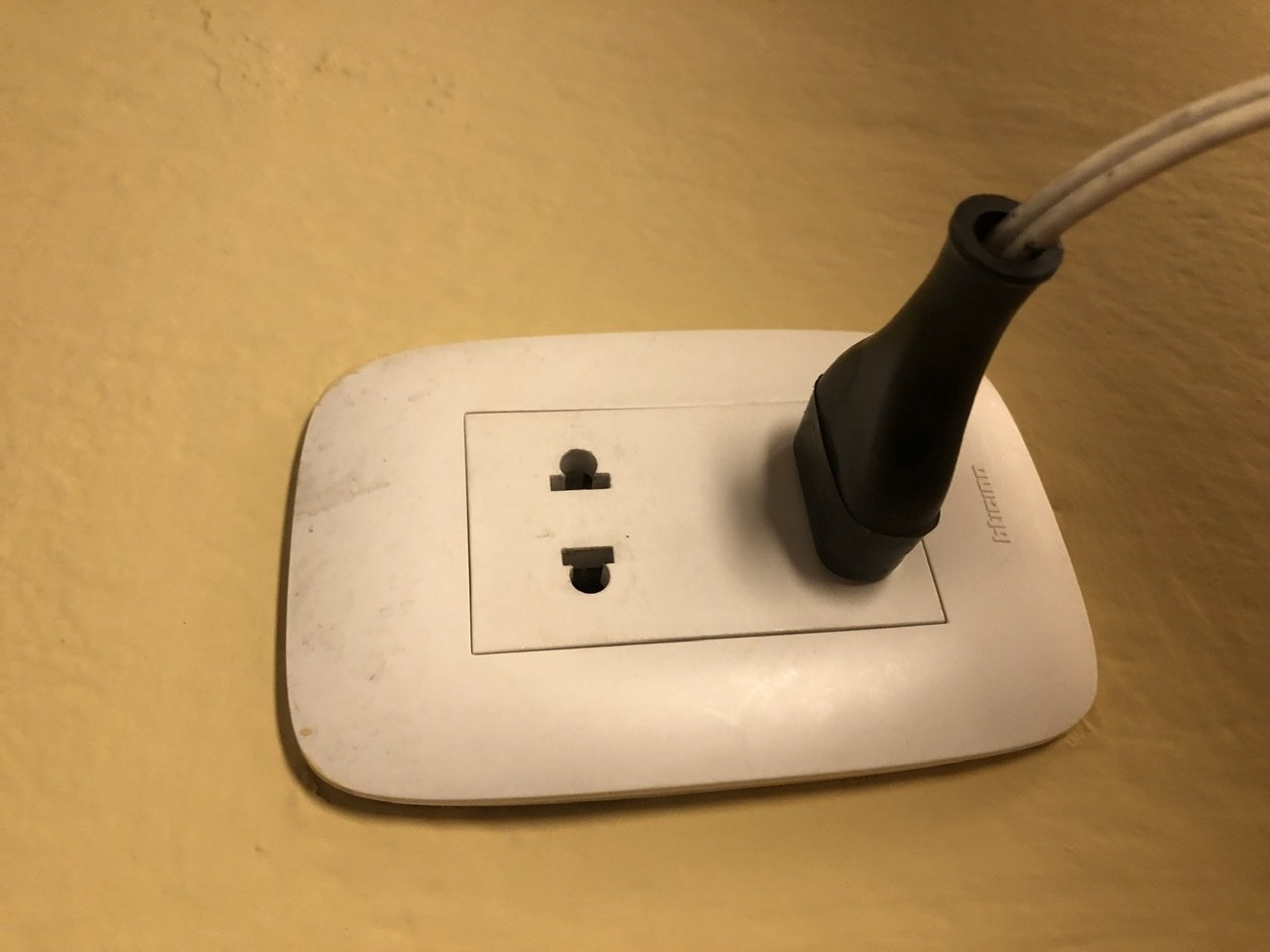
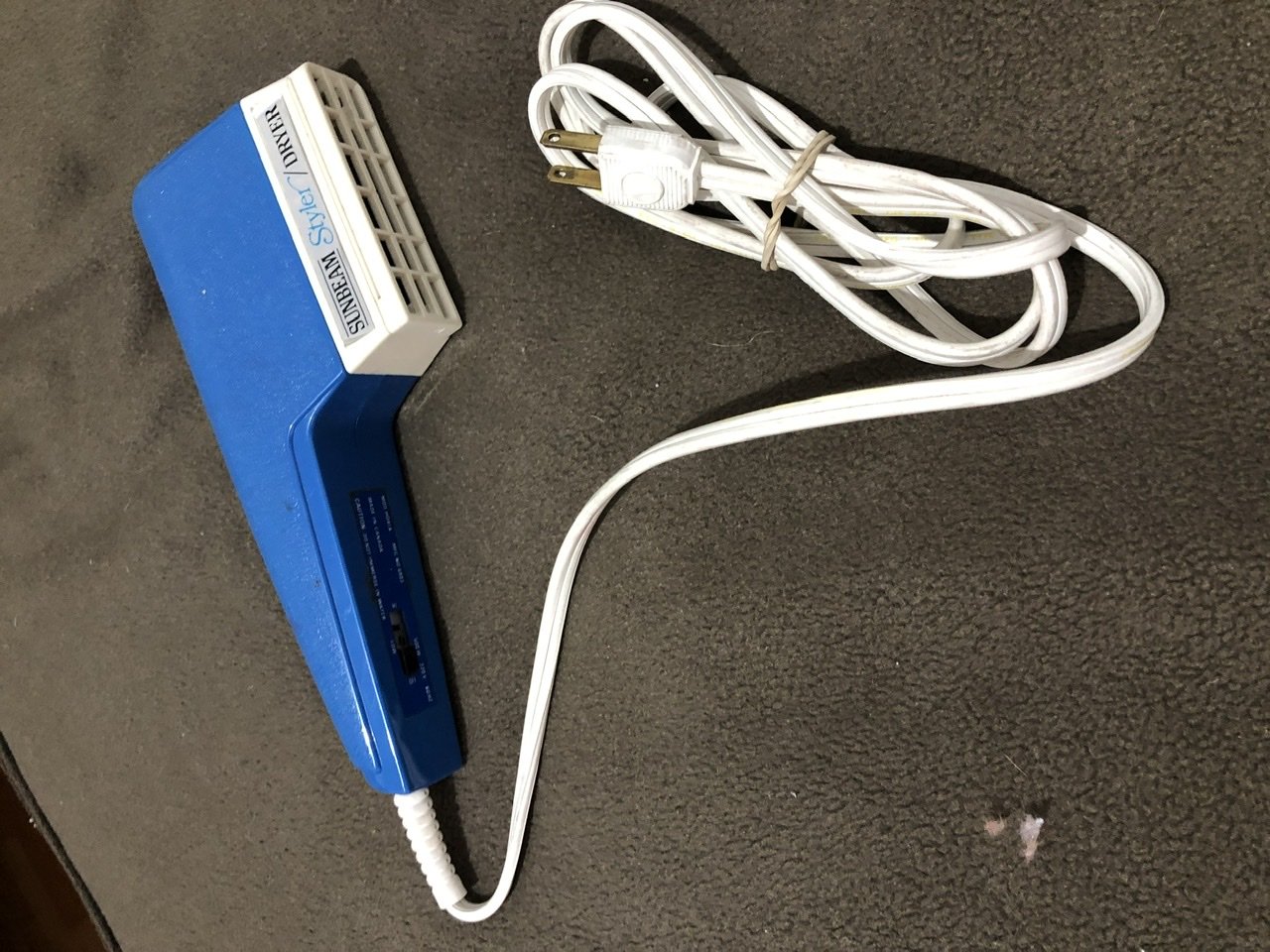
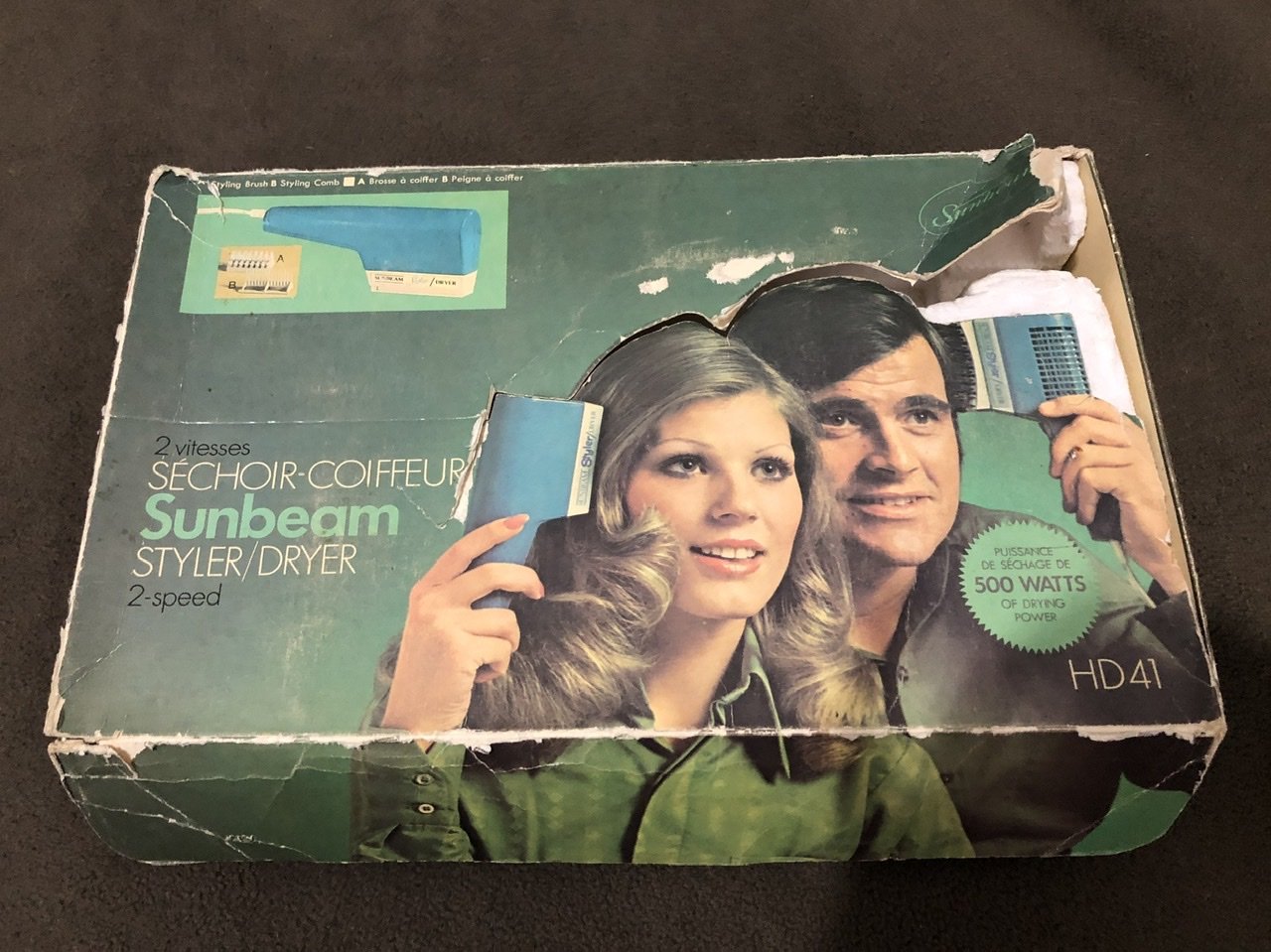
Oooo. But we do like this…Euro/American plugs all in one!! Points for Peru! It’s also a luxury when your Airbnb comes with a hairdryer to plug into that socket!! Maybe some of our wiser followers can let us know what year Mandy was blowing hot air from! ? Kudos for trying, Rosita!!
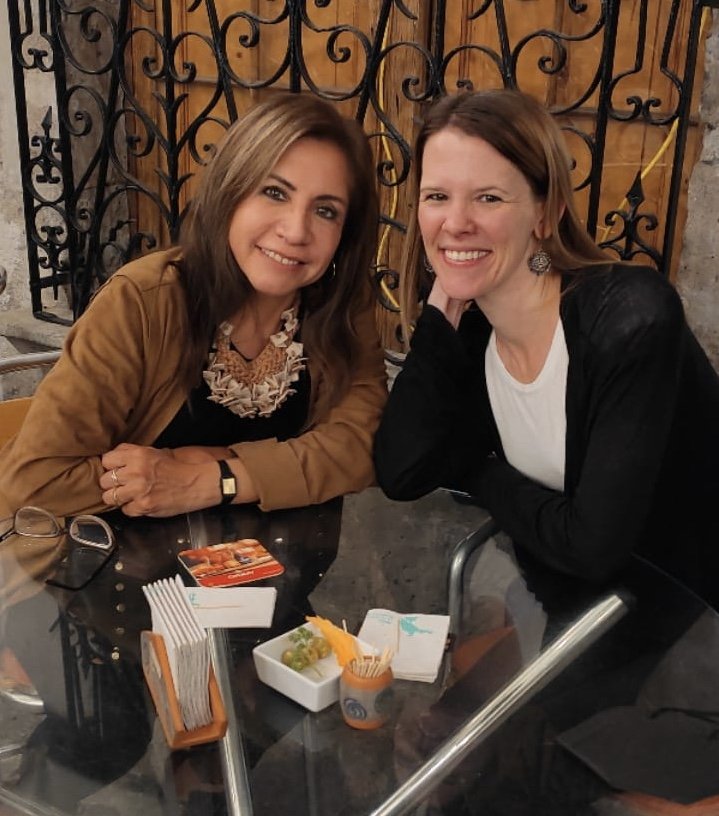
As the days went back, we realized we got really lucky to have the sweetest hosts ever in Rosita, Frederico, and their sister in law. Mandy and Rosita even got to have a (too much fun) girl’s night of Pisco Sours and they also practiced yoga together (but not on the day they were hungover….haha.)
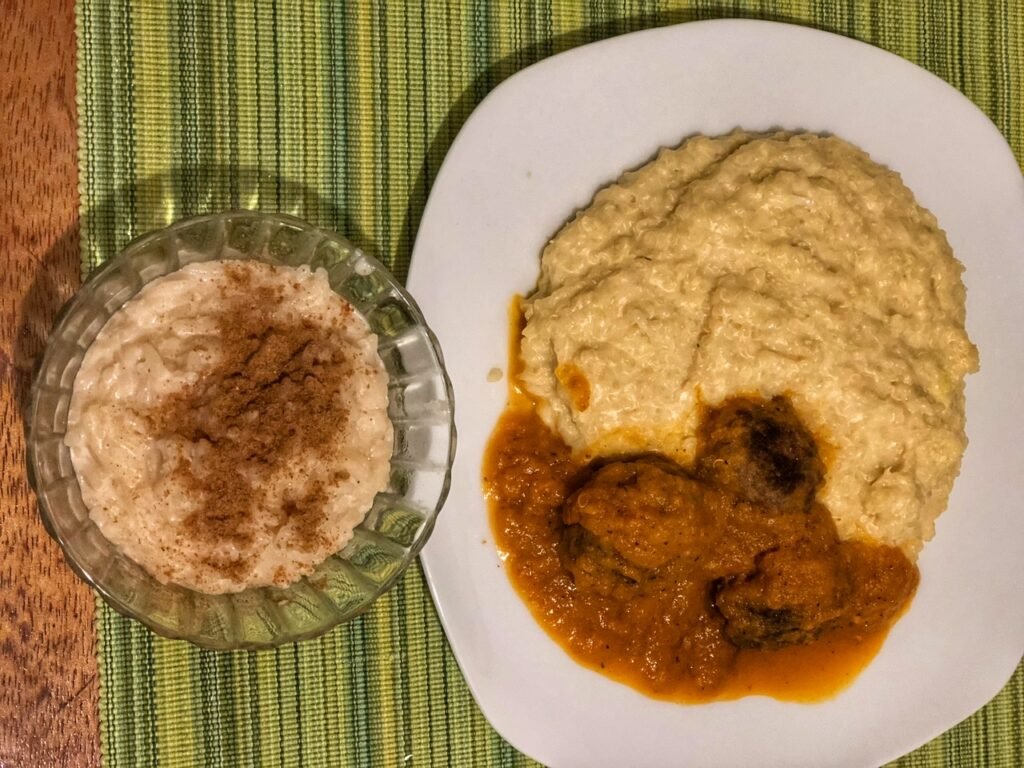
Oh, and they kept giving us food!!! Just one of the Peruvian delights they shared with us…arroz con leche with meatballs and quinoa with cheese, which seems to be a Peruvian comfort food like our Mac & Cheese.
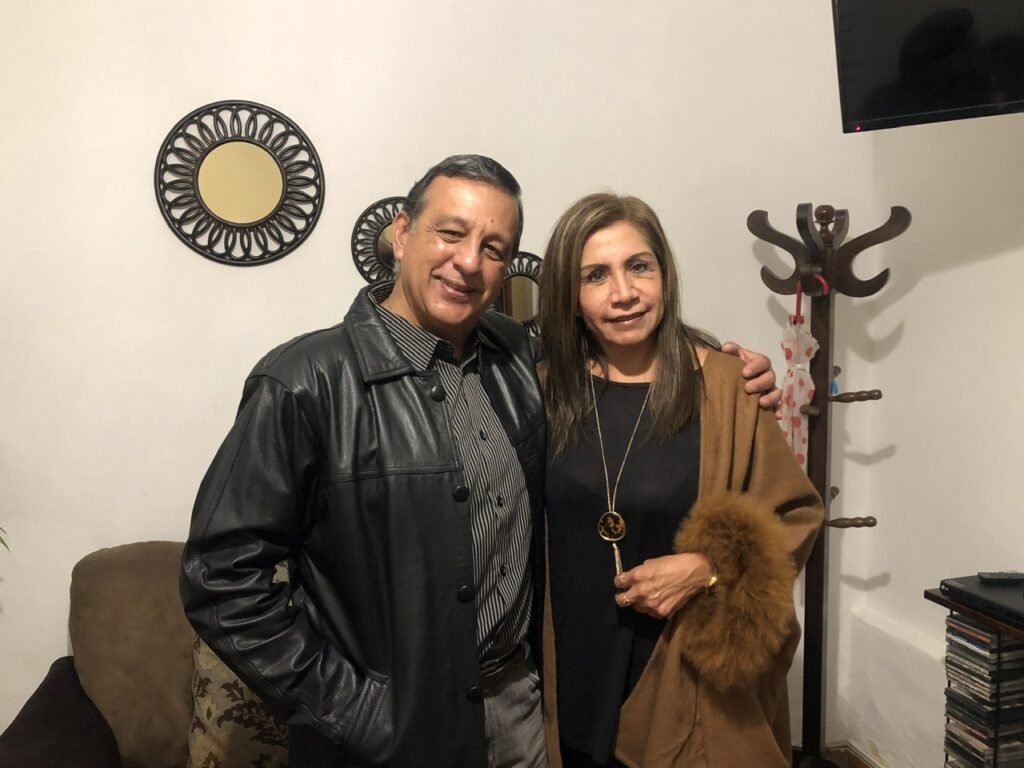
Despite our language limitations, we became quick friends and even plan to meet up with them later again..across the pond…this year!
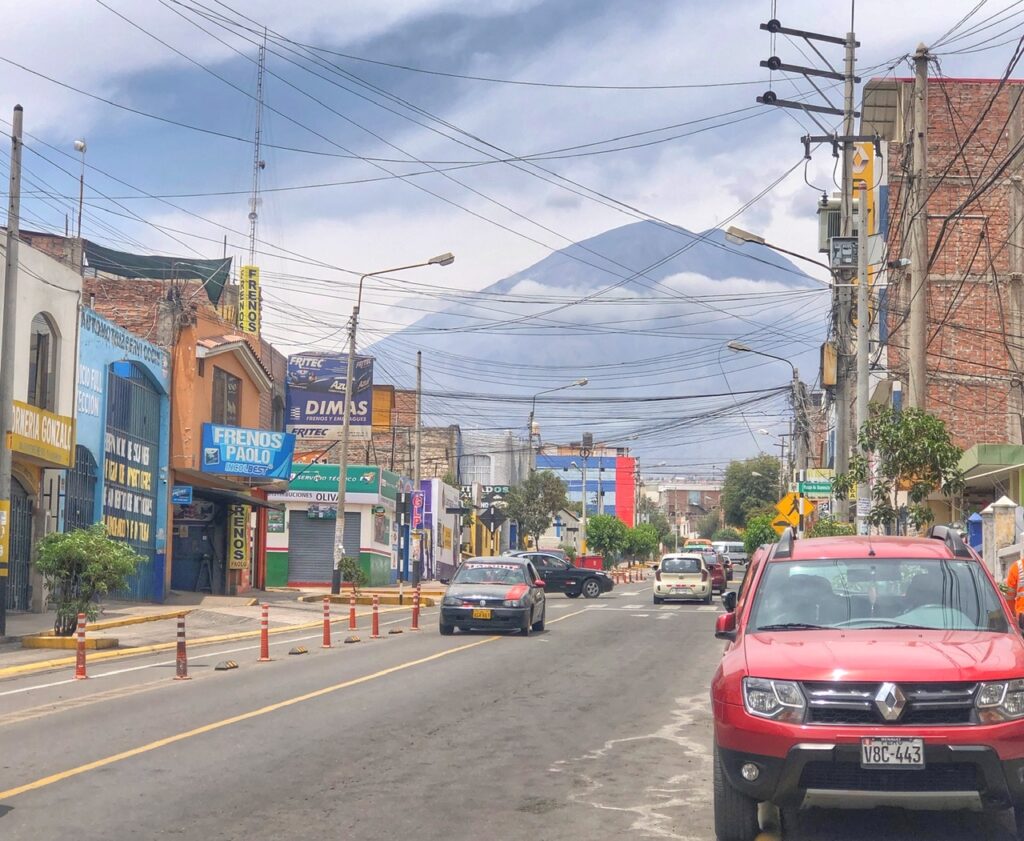
Oh, but by the way, there was a gargantuan 19,000 foot (5800 meter) active volcano out our door. Yes, that’s only 1000 feet shy of Denali.
Peruvian Cuisine
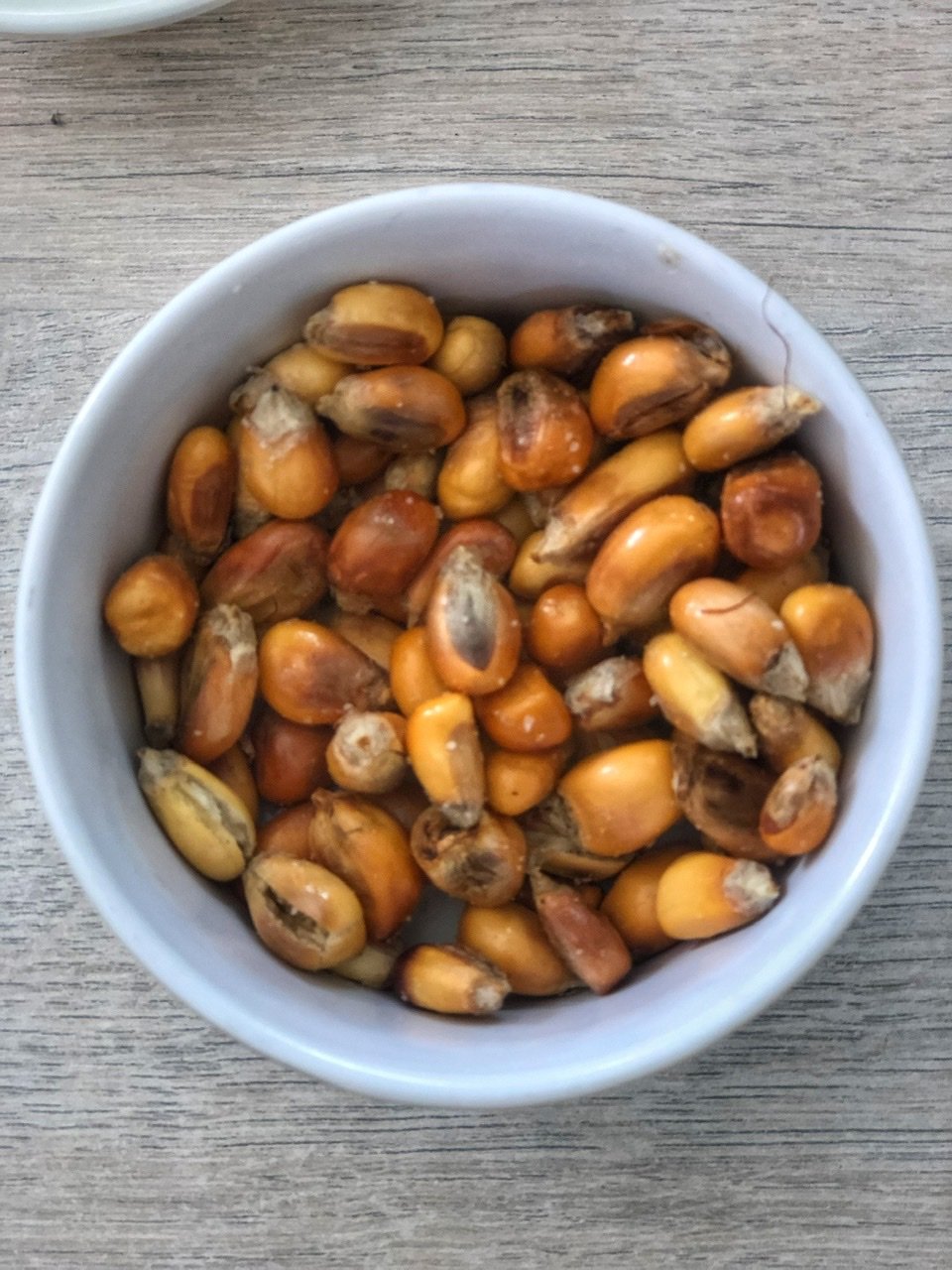
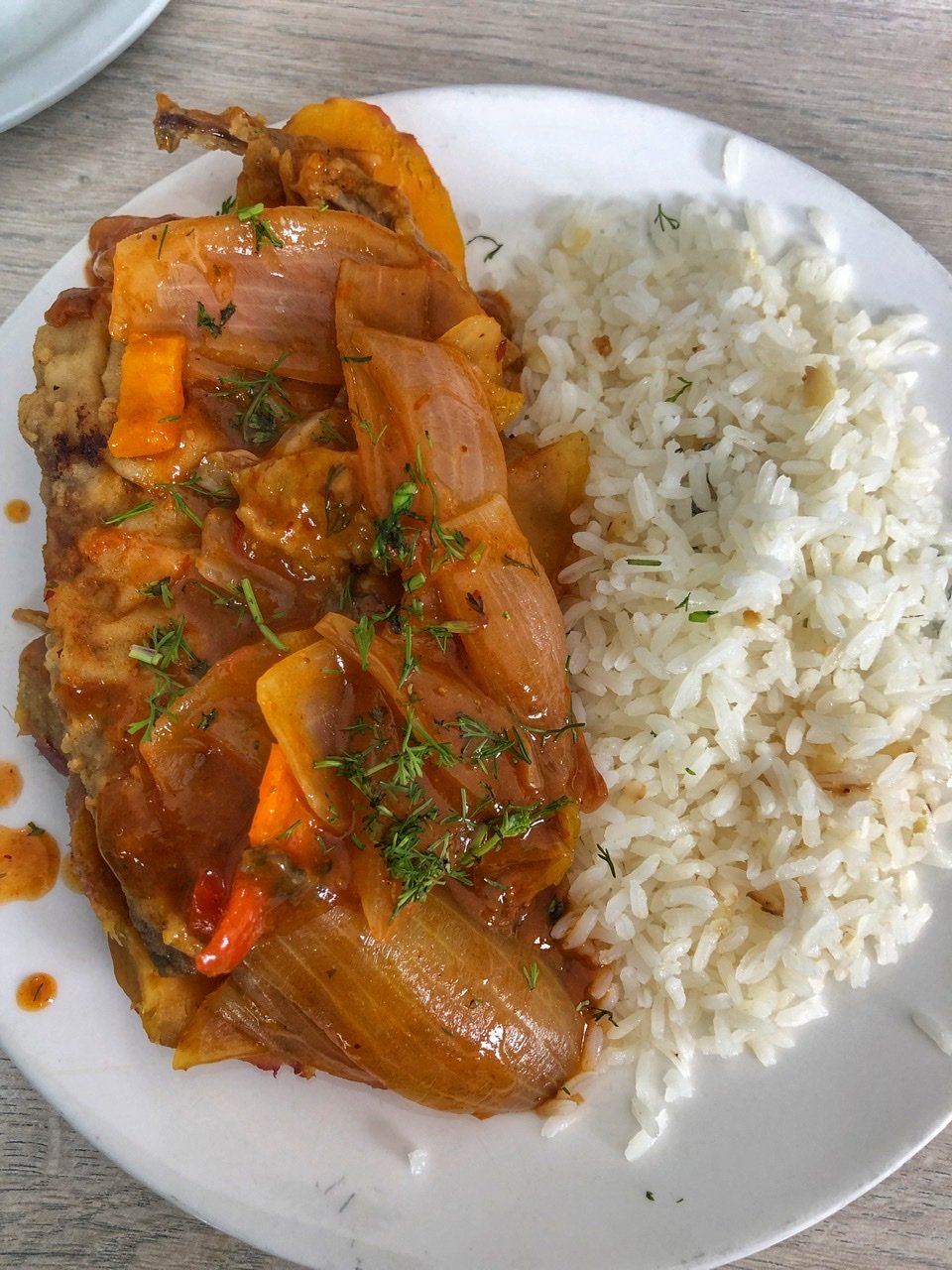
And my goodness, had our mouths been watering a long time for this…Peruvian cuisine! And, although they don’t call them Menu Del Dias in Peru, they do have Menus, which is the same thing. Our first meal out was at Cevicheria a few blocks down from us. While you’re waiting, you get the joy of snacking on these dry salty bits of corn. Hmmm….not quite peanuts…but interesting! Greg’s first was marinated jurel (mackerel) with rice, fish soup and juice. (8 Peruvian sols or $2)
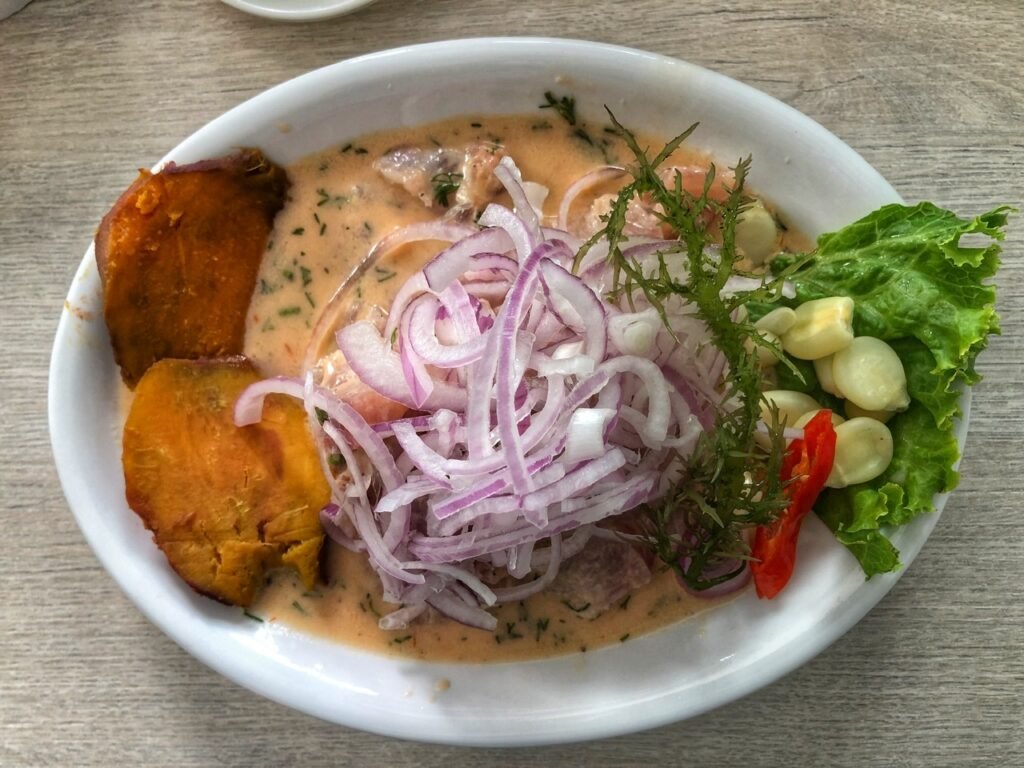
One of our favorite things about travel is going to the countries where our favorite foods were born. Therefore, Mandy immediately dove straight in to what she had been longing for ….a giant plate of ceviche made with sole fish, piled high with red onions and a side of yams, which is surprisingly a tasty combination. Absolutely divine. Cost 15 sols or $3.75.
In Peru, ceviche has been declared to be part of Peru’s “national heritage” and even has had a holiday declared in its honor. The classic Peruvian ceviche is composed of chunks of raw fish, marinated in freshly squeezed key lime or bitter orange, and salt and pepper.
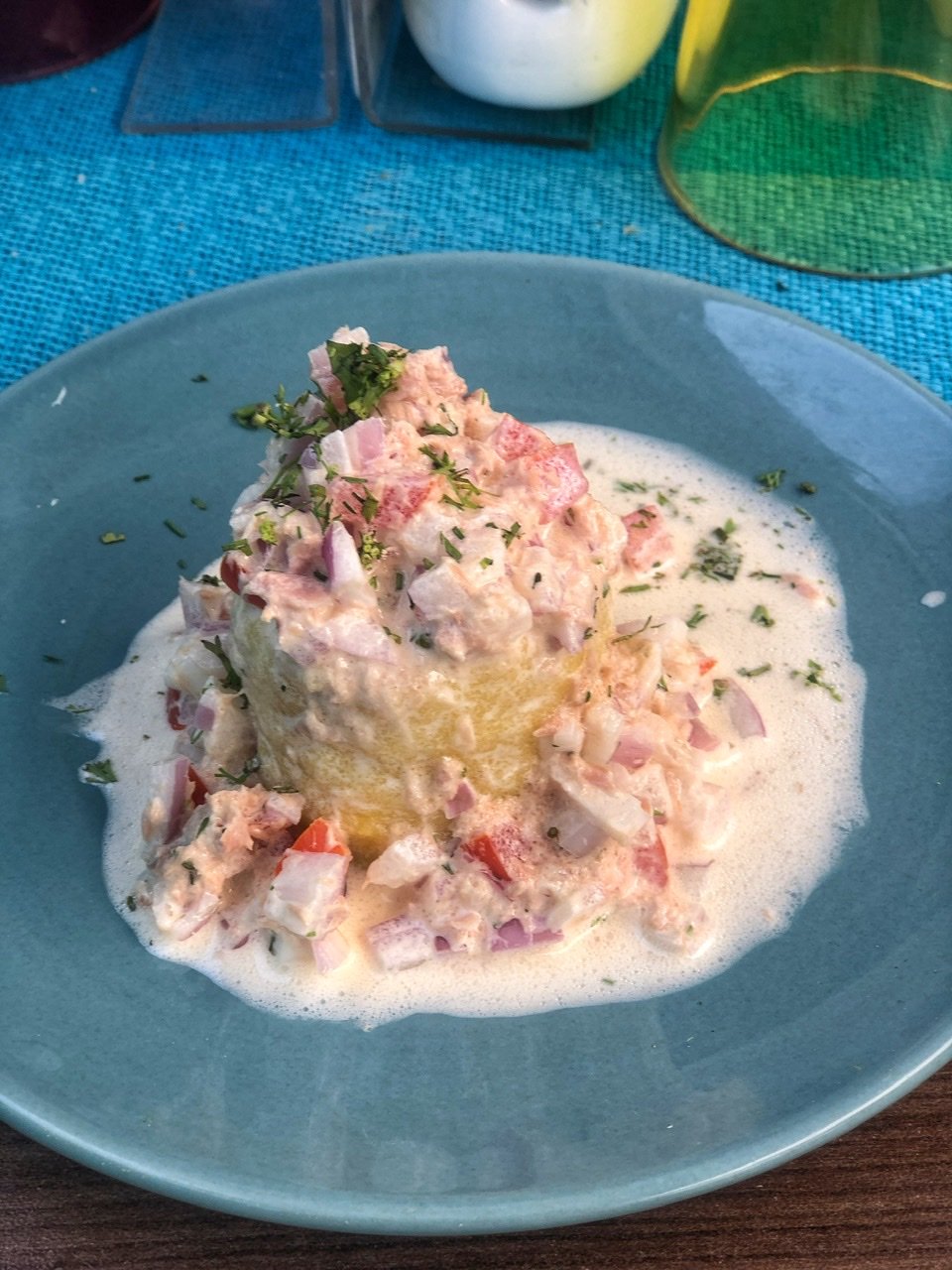
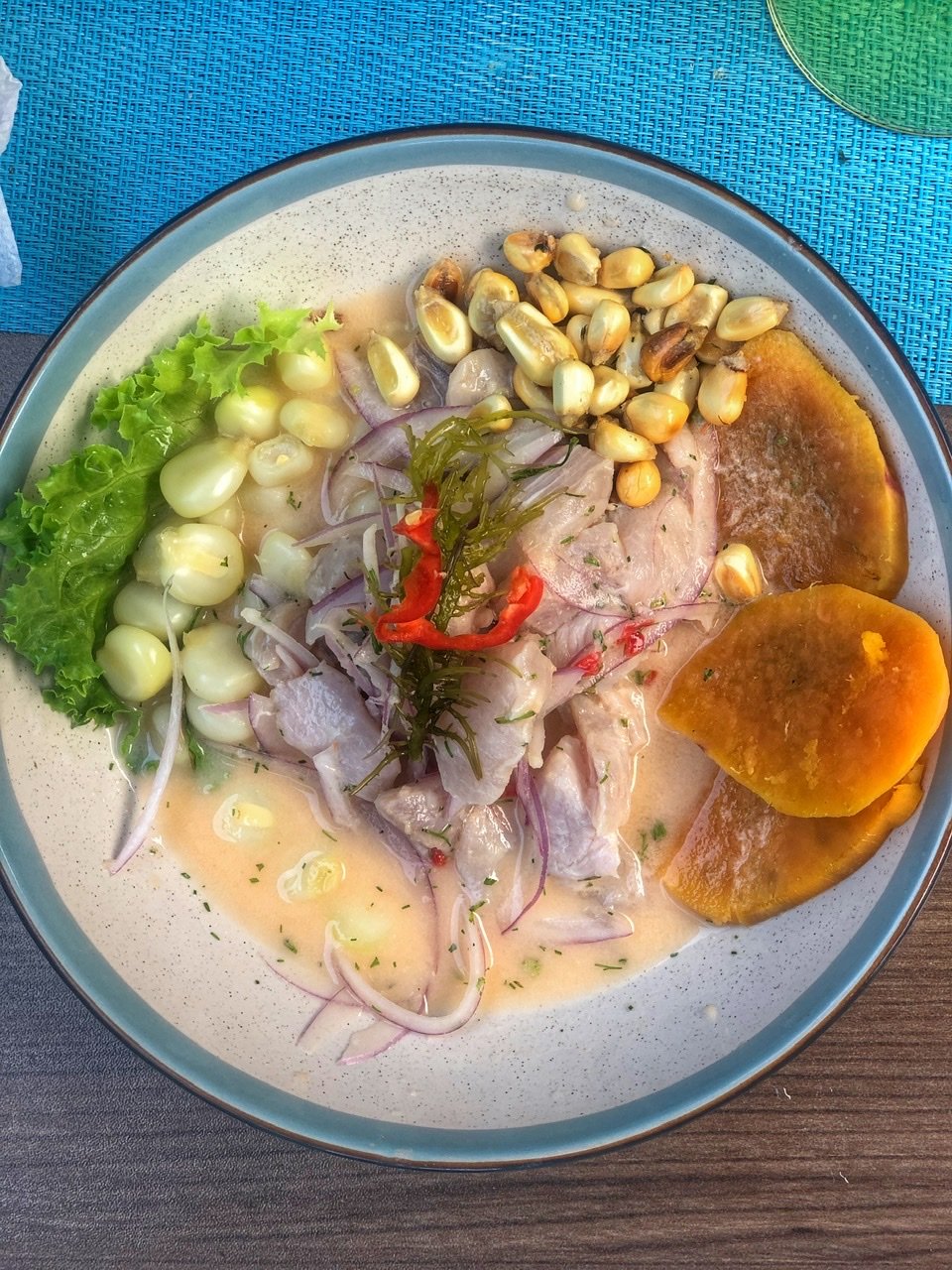
Another ceviche lunch included an appetizer called Casa Atun, which is bright yellow potatoes blended with oil, lime juice and, most importantly, Peru’s ají amarillo, and then layered with a filling of tuna, onions and peppers. OMG, what a mouth-watering surprise! And at right, the main course…more fish…in the ceviche. By this point we were surprised we haven’t grown gills from eating so much of it. In addition to the dishes above, you received juice…all for 14 Peruvian sols or $3.50. Such amazing value…this would cost easily $12-$15 in the States.
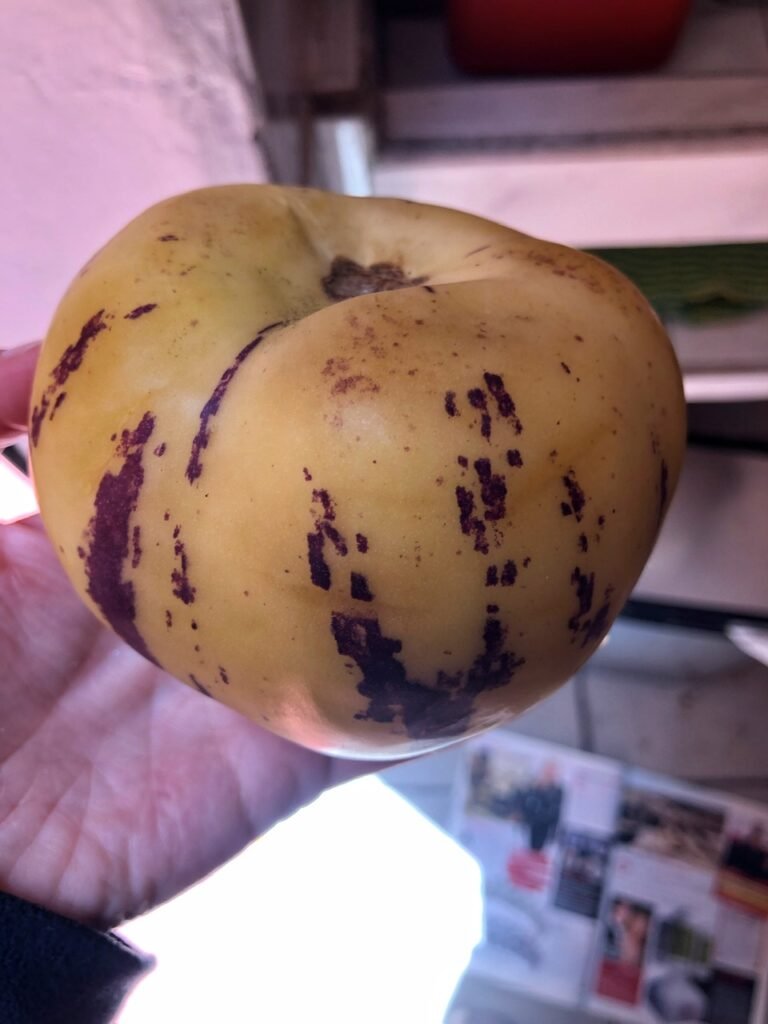
A pepino is not a cucumber in Peru. Evidently this tomato looking fruit with a rockin’ makeover is actually a pepino and it happens to be much more melon-like inside. And a pepino (aka a cucumber) is called something else. Oh Spanish ?♀️
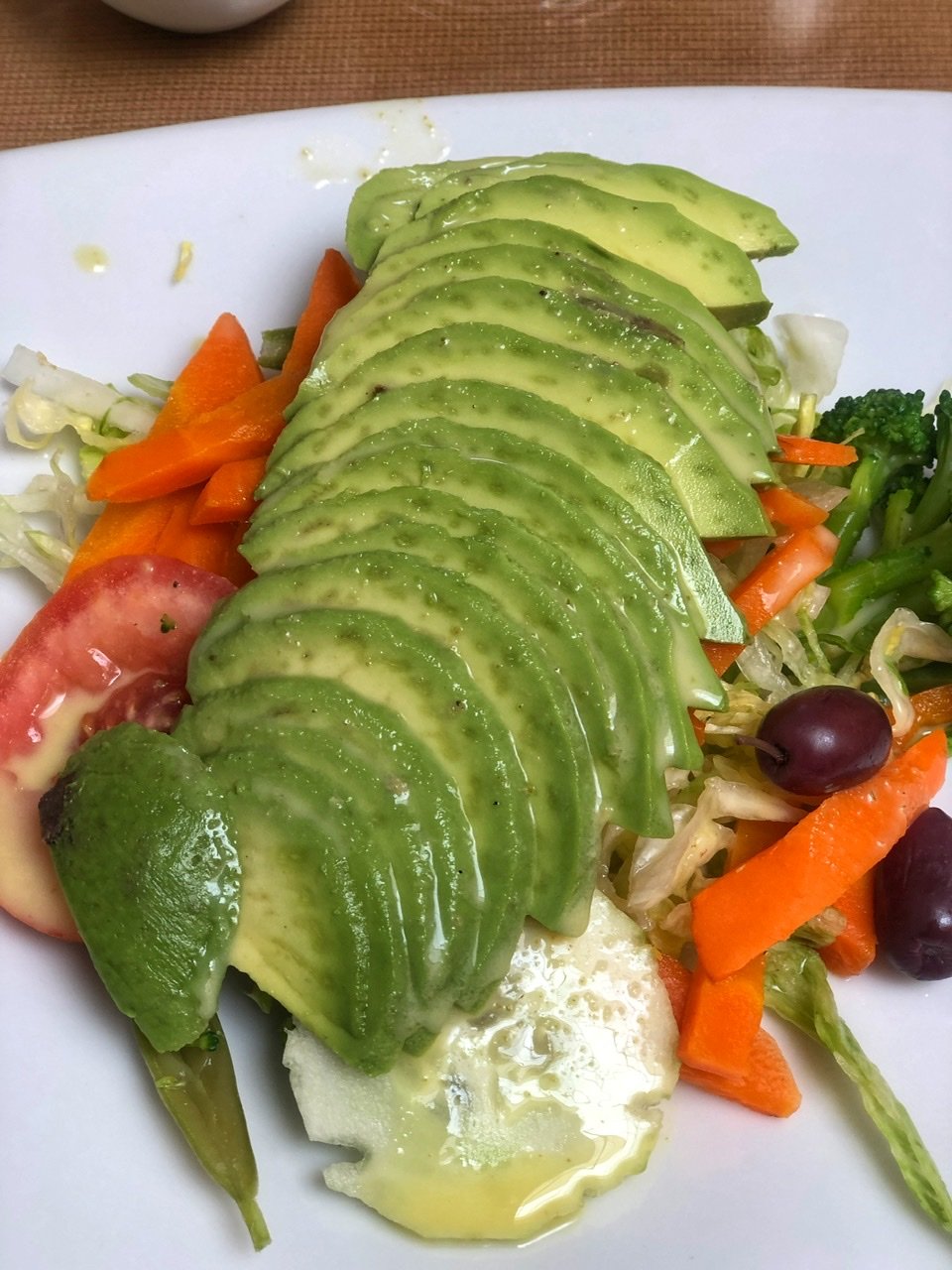
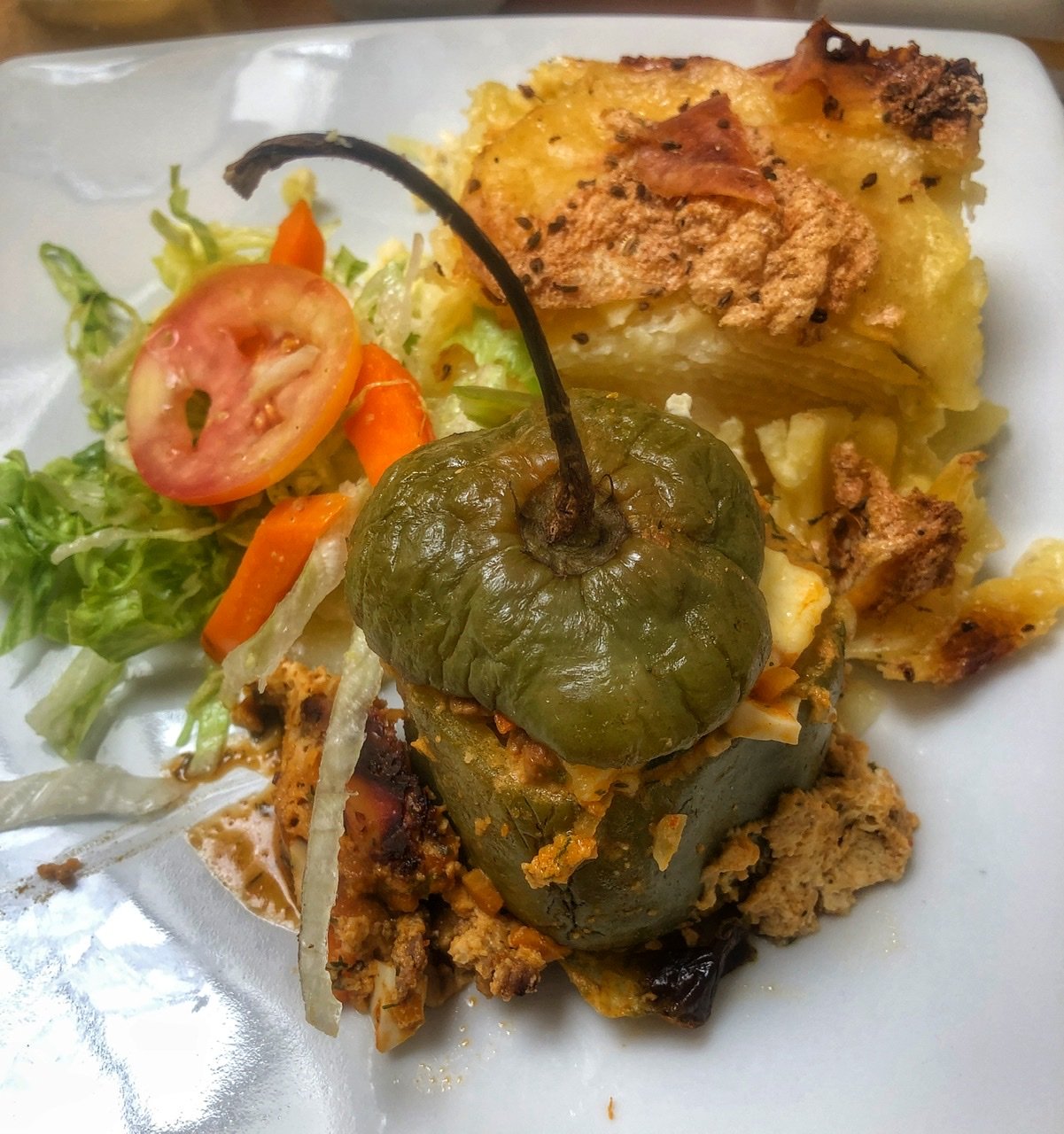
Also, this avocado salad is evidently an ensalada de palta here. Yes aguacate is palta. Geez. The other part of Greg’s meal included a Rocoto Relleno, which is a very spicy Peruvian stuffed pepper, and one of the culinary prides of Arequipa. Stuffed with seasoned meat, egg and veggies. Both items, and juice from this Menu del Dia were 11 sols or $2.75 total.
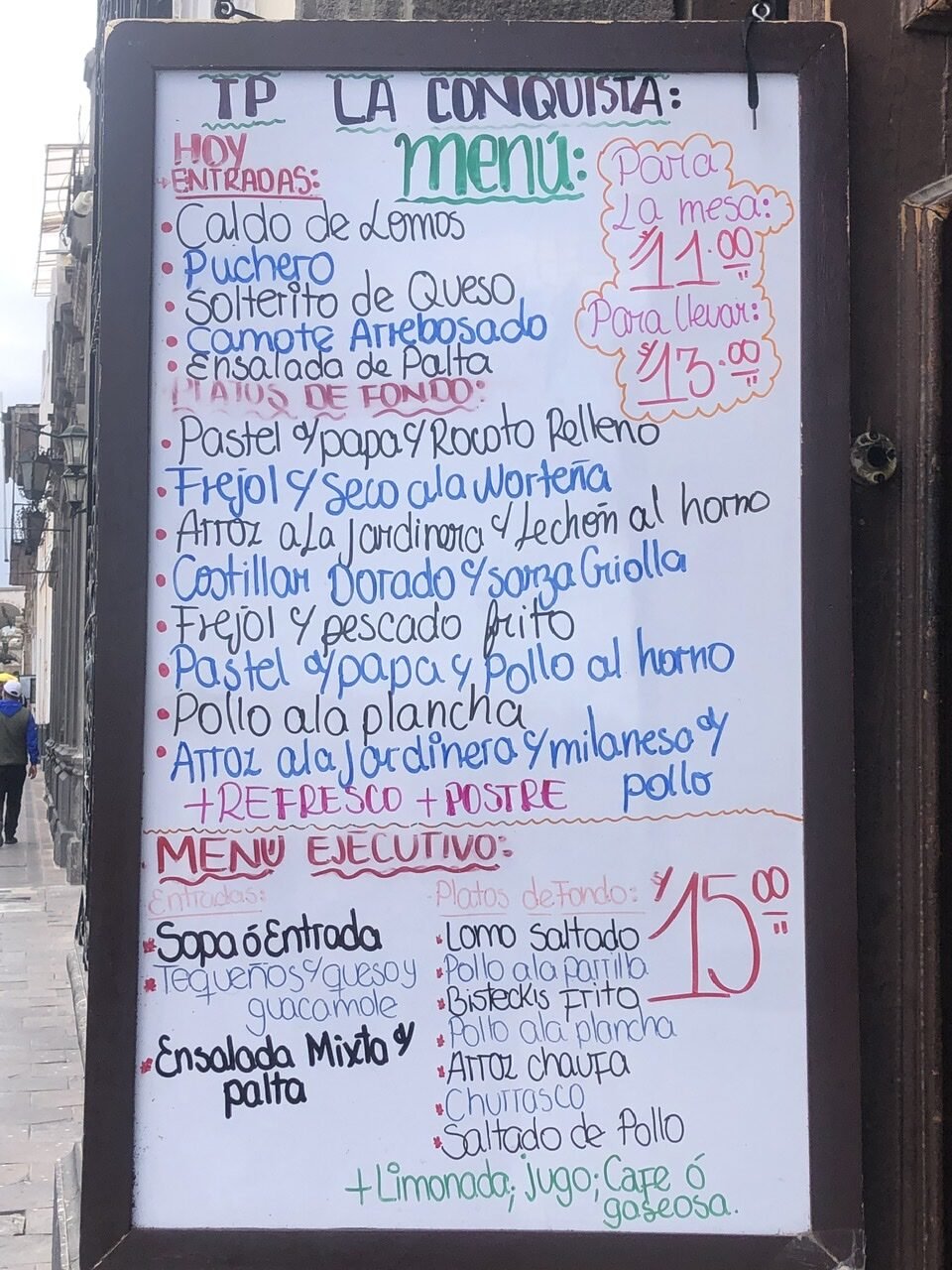
All the food options are overwhelming. This city is one of a kind!
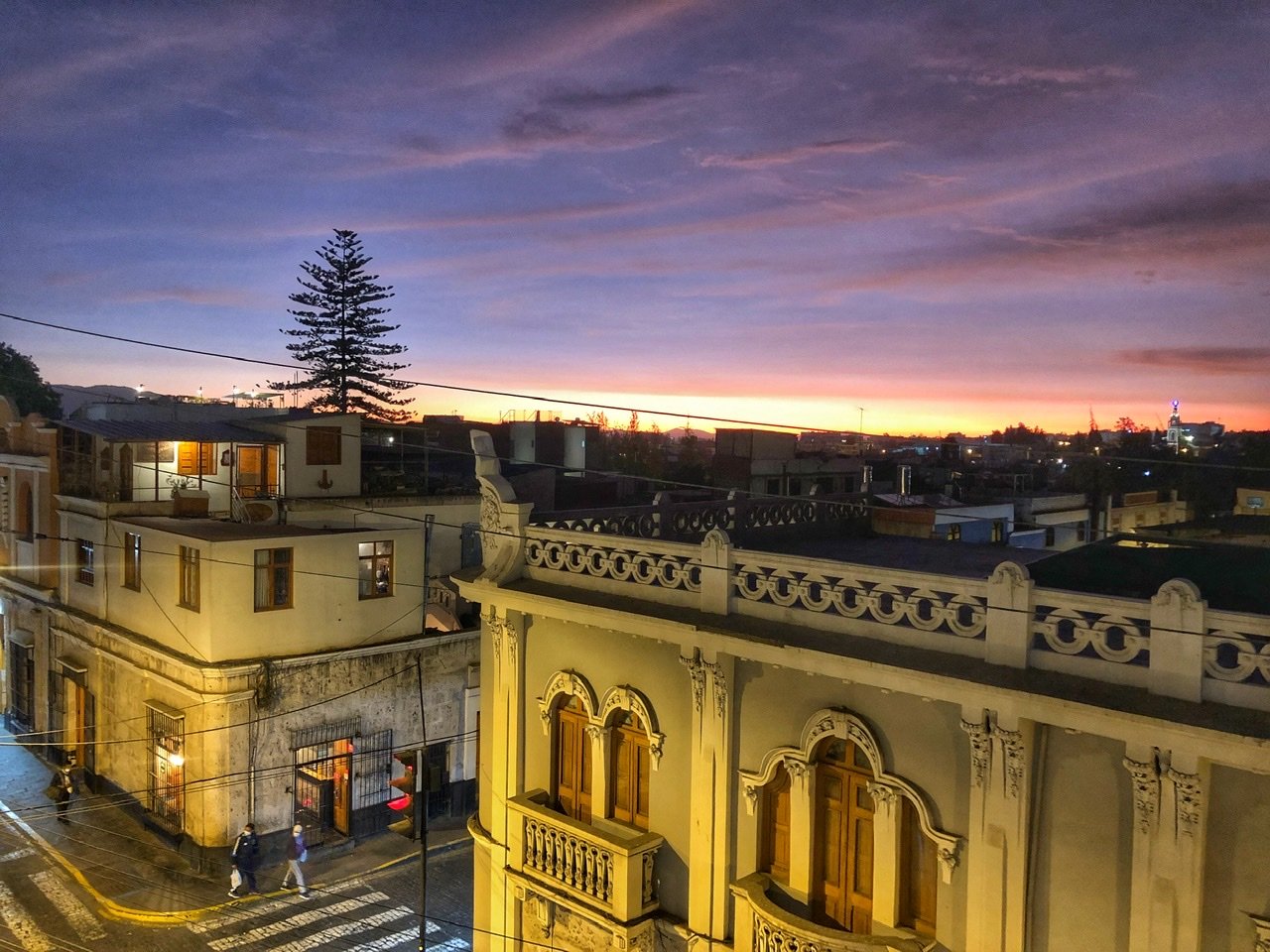

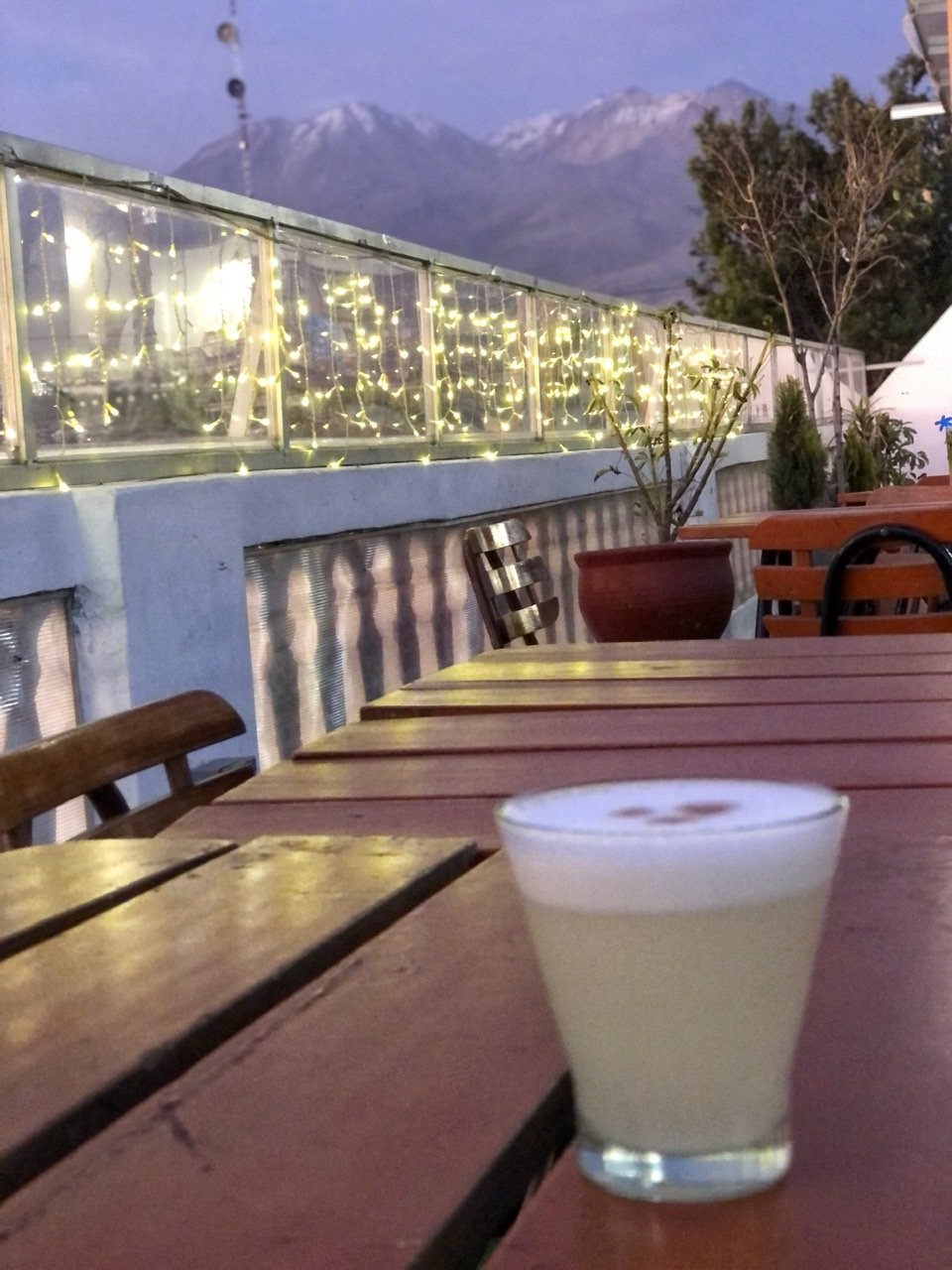
At Haykuy Rooftop Bar we enjoyed a mountain-laden view as we slurped down our first Pisco Sour, which is an alcoholic cocktail of Peruvian origin that is typical of the cuisines from Peru and Chile. The Peruvian pisco sour uses Peruvian pisco (type of brandy) as the base liquor and adds freshly squeezed lime juice, simple syrup, ice, egg white, and Angostura bitters. We were hooked. Especially Mandy. Cost for two cocktails: 16 sols or $4
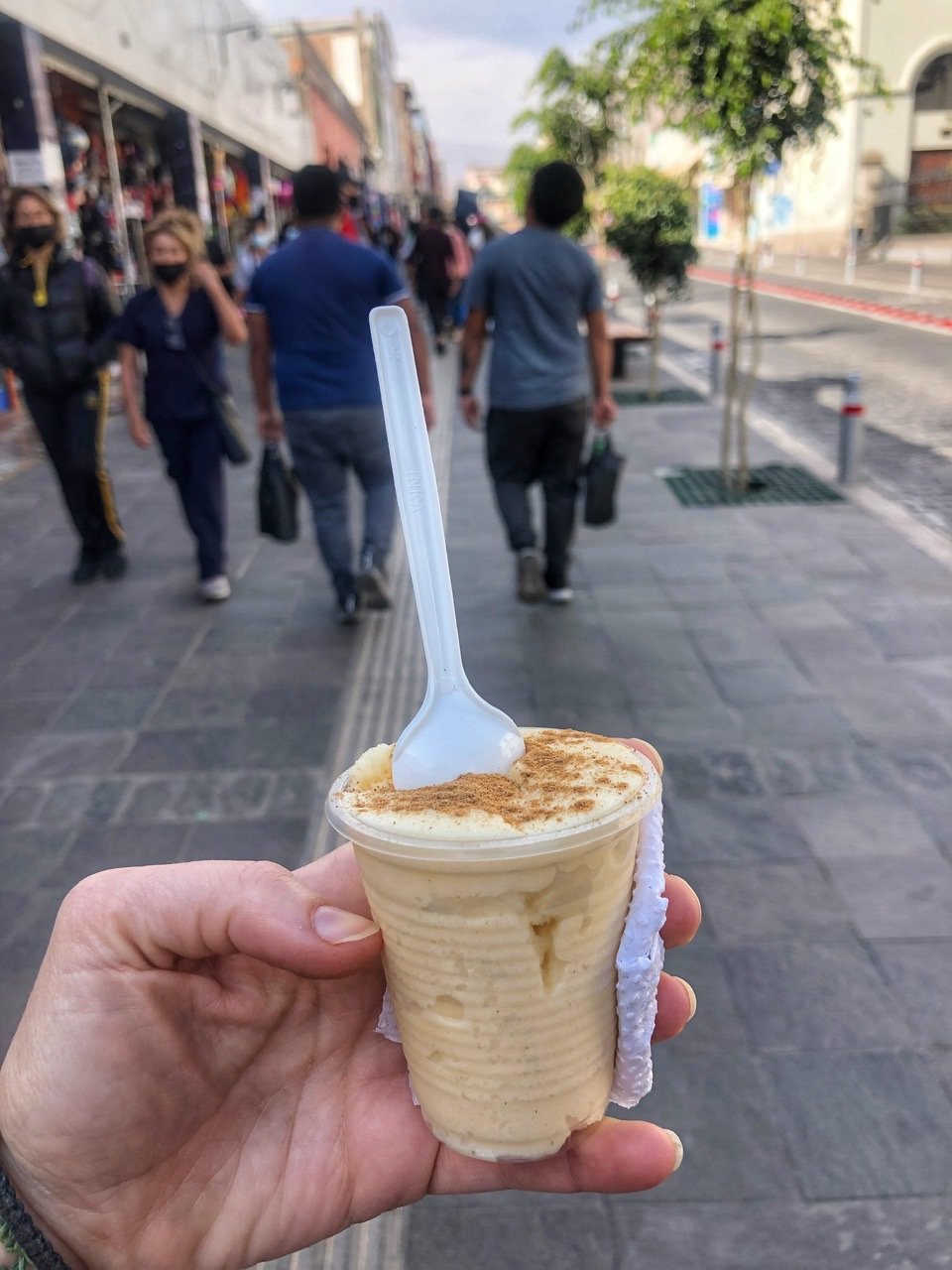
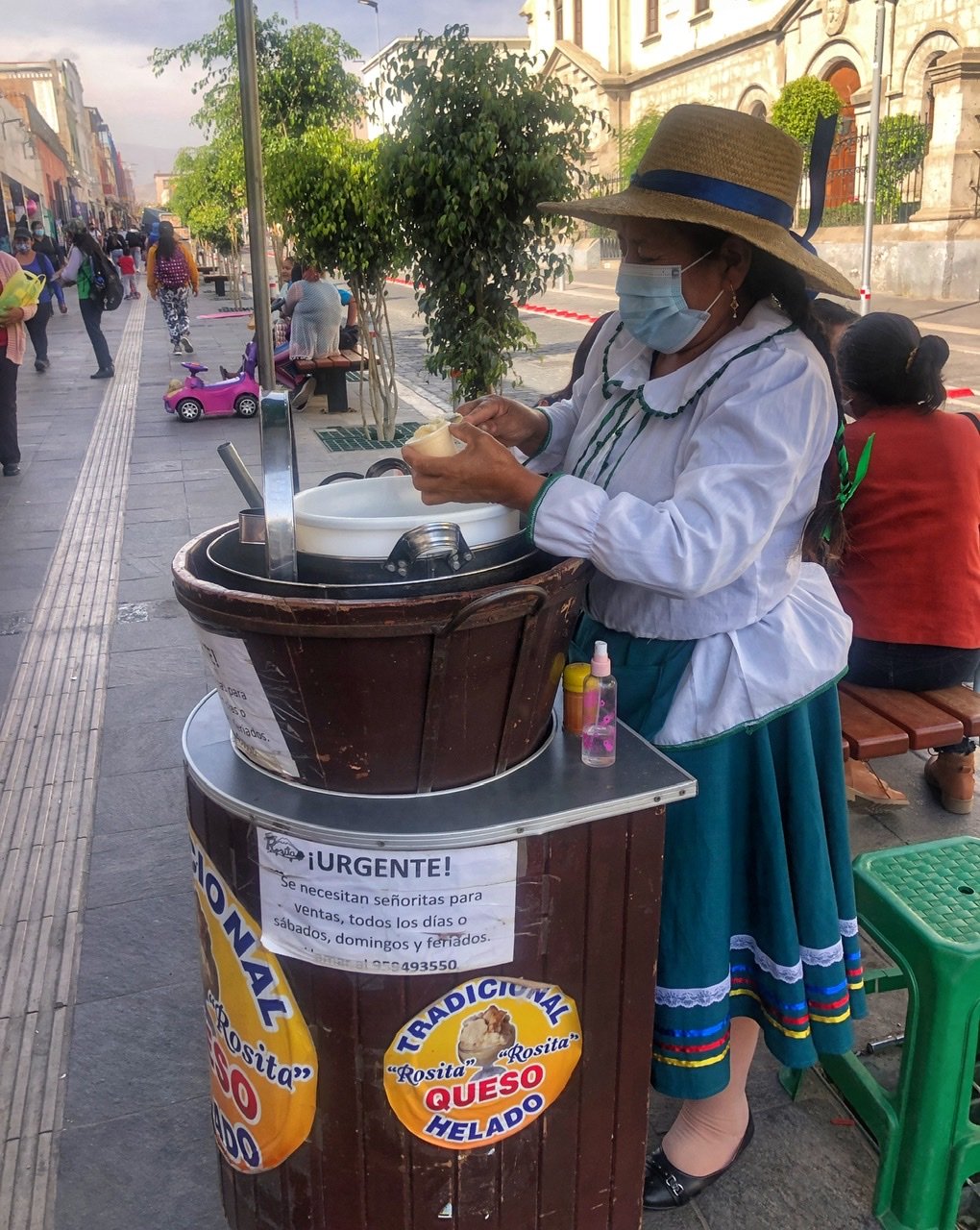
Queso helado. Yes, Taco Bell Spanish learners, that means CHEESE ice cream and Arequipa is the home of it. But let us be clear, there’s no cheese in it. Instead it’s a beautiful blend of coconut, cinnamon, and vanilla. To us, it takes a bit like good old fashioned vanilla homemade ice cream topped with cinnamon. Muy rico!! And the little lady who served it for 2 sols/$.50 was just so darn cute!
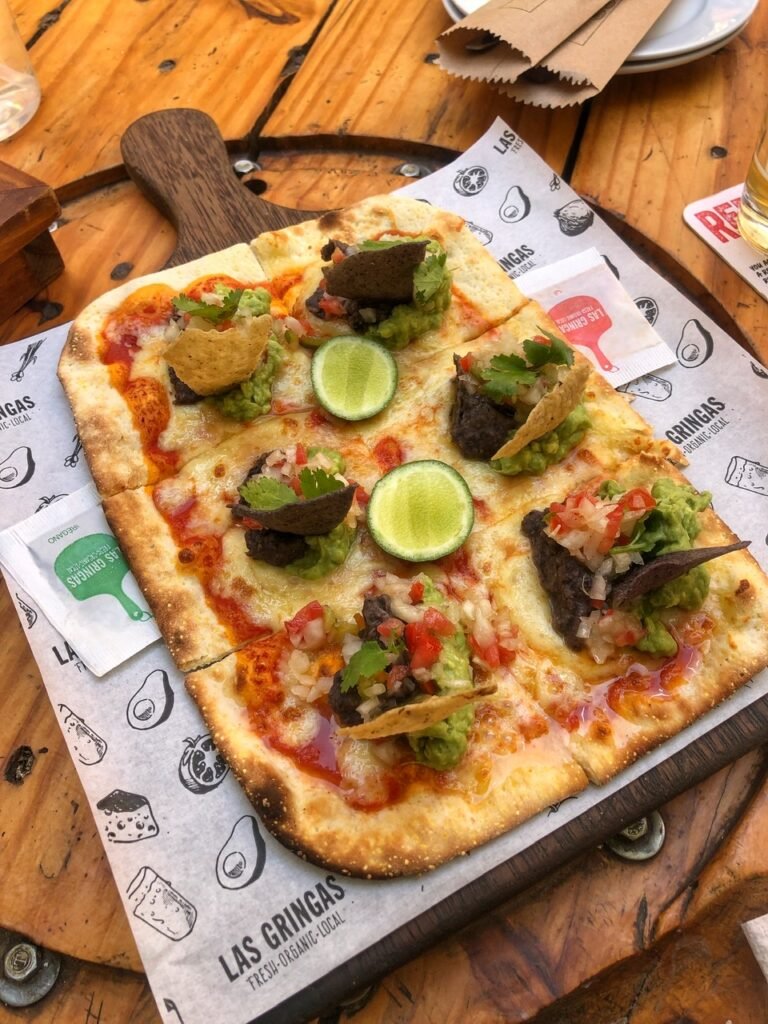
We haven’t had pizza in at least six months, so we were over the moon when we finally found some that is gluten free for Greg at Las Gringas. Yes, conveniently catered to our burdensome dietary gringo needs. The crust was made of quinoa, and it was an Italian/Mexican blend topped with refried beans, guacamole and pico de gallo. A bit pricy at 32 sols/$8, but absolutely worth it!
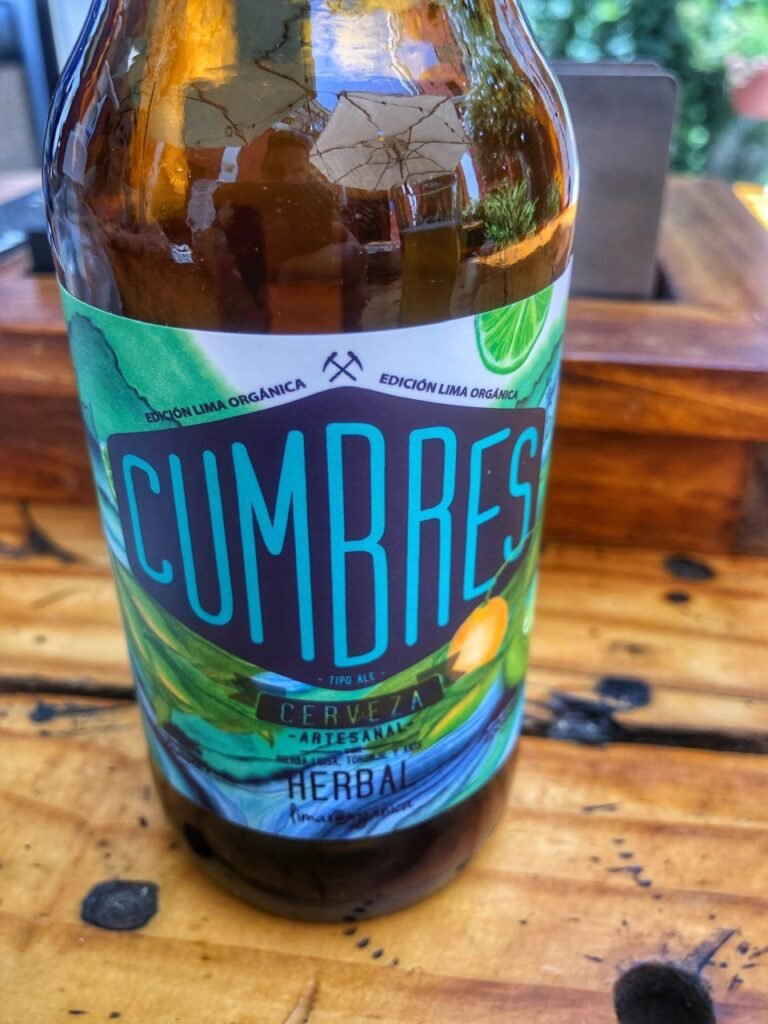
We had craft beer choices in Arequipa!! Whoohoo! Cumbres Brewery from Lima offers an herbal blonde ale with hints of lime and mandarin. Very thirst quenching on a warm afternoon. Yum.
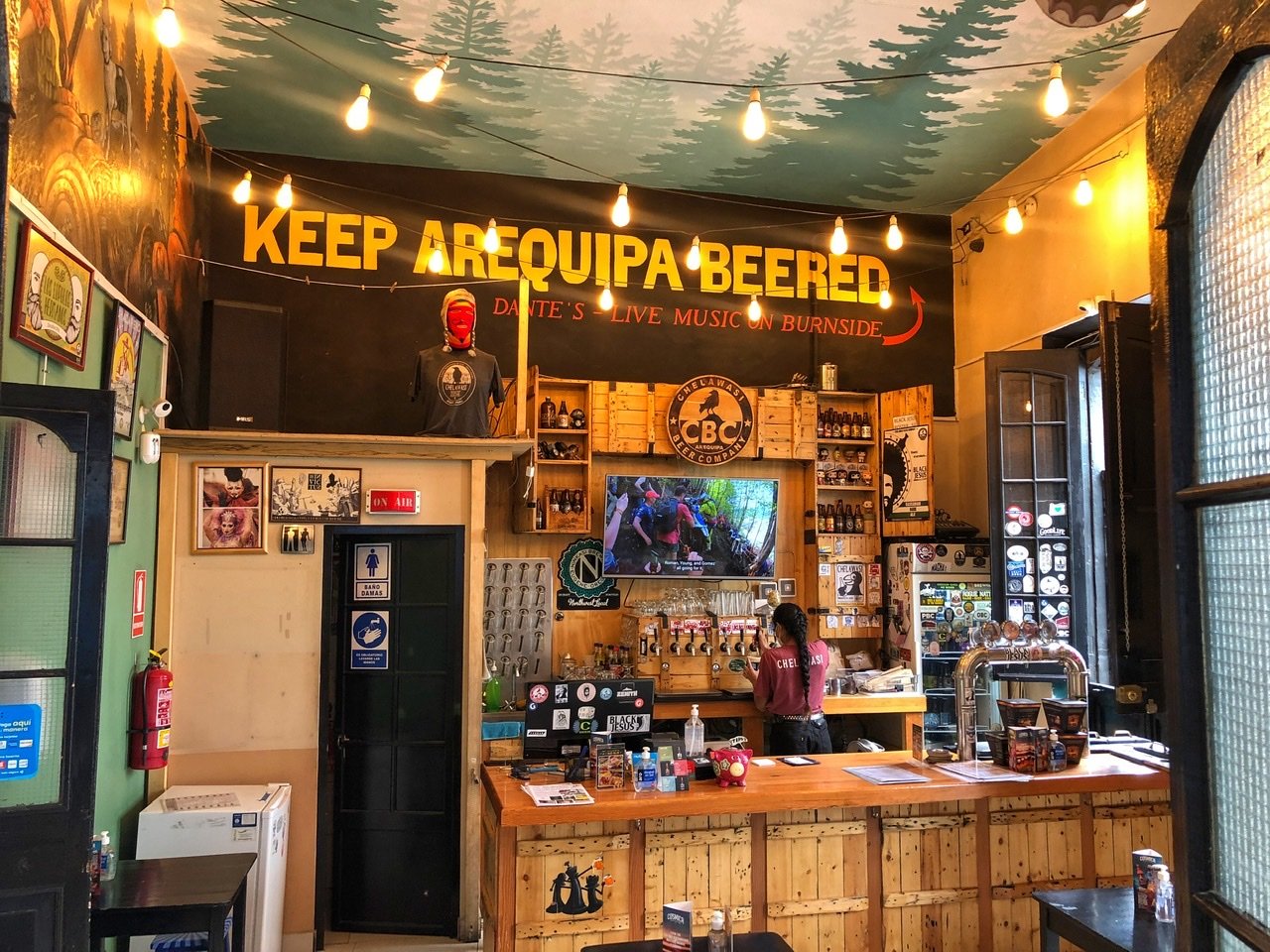
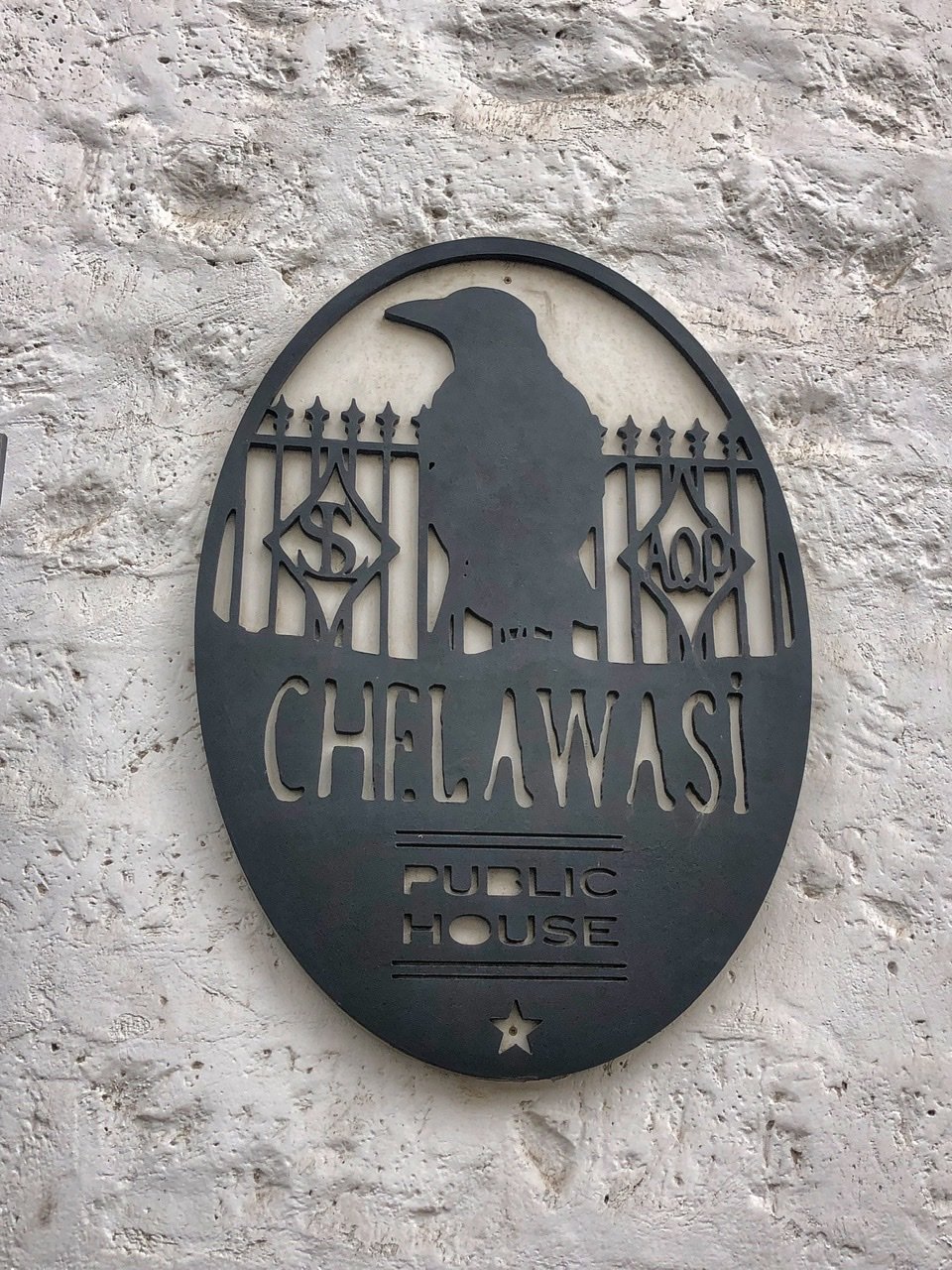
Also, we were astonished when we walked into another brewery called Chelawasi and saw a big sign on the wall said, “Keep Arequipa Beered.” And then…a Base Camp coaster! And…then there was a BIRD on the logo. This probably doesn’t mean much to many of you, but to us, these were obvious clues that the brewery owner shared the love for our last home of Portland, Oregon. Unfortunately, he wasn’t there so we couldn’t ask him directly, but through the power of the internet, we found out he was certainly from there!
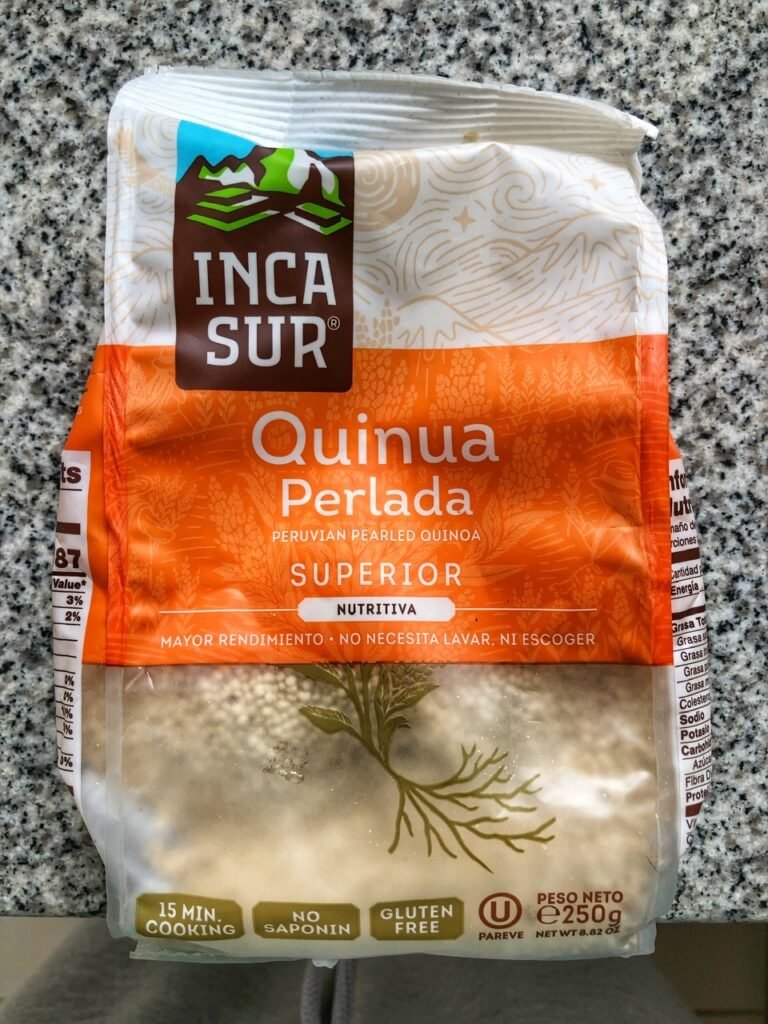
Another Peruvian staple we love is found for $1.50 a bag here. Probably cheaper at the markets, actually. Yay! No rice needed!!
Exploring Arequipa
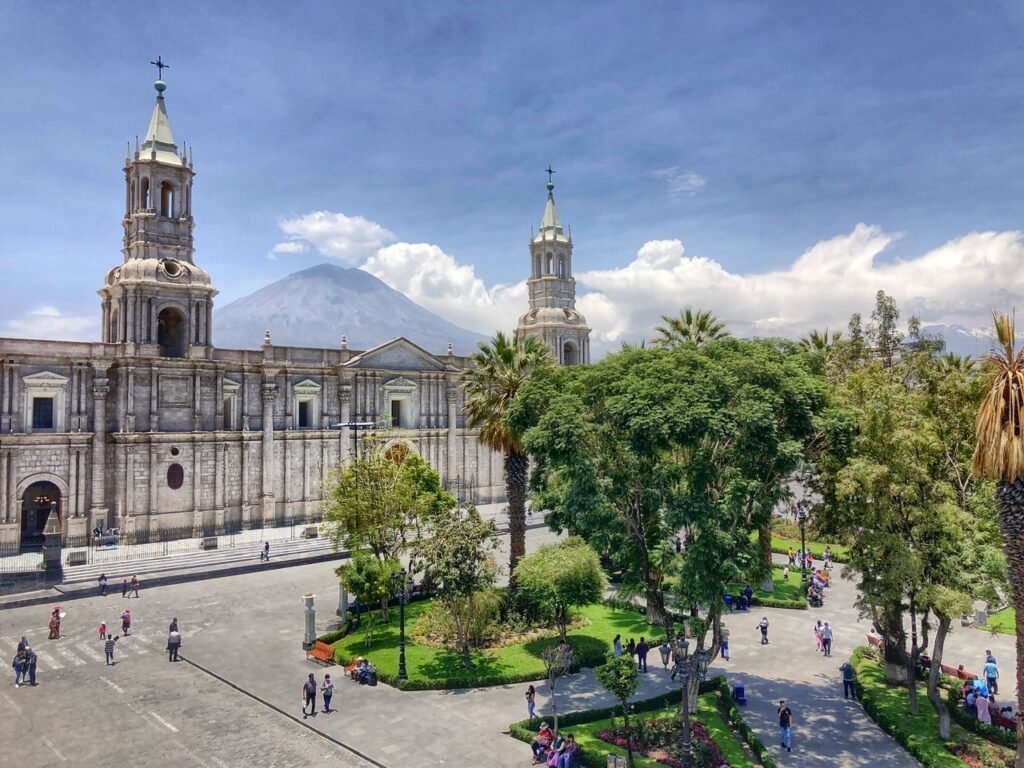
Plaza de Armas is a masterpiece showcasing the city’s radiant white volcanic rock sillar architecture. Grand balconies and arcades line three sides and the fourth gives way to Peru’s widest cathedral. Misti volcano, a gargantuan 19,000 foot (5800 meter) active volcano which last erupted in 1985, regally guards the city 17 km away. This is 1000 feet shy of Denali. There are two common climbing routes to the top, which many tourists partake in because it’s a relative “easy” climb with no technical skills required. We’ve summited enough volcanoes, so that was a hard pass for us. It cost $70 to climb and is about the same elevation as Kilimanjaro, which people pay $3700 to climb. Quite a head scratcher. ?

Another reason the plaza is reminiscent of Italy…there is a bronze fountain with a sculpture made of bronze of a pixie with a trumpet. It is said that this little man once had wings, but over the years he lost them. He must have been bad.
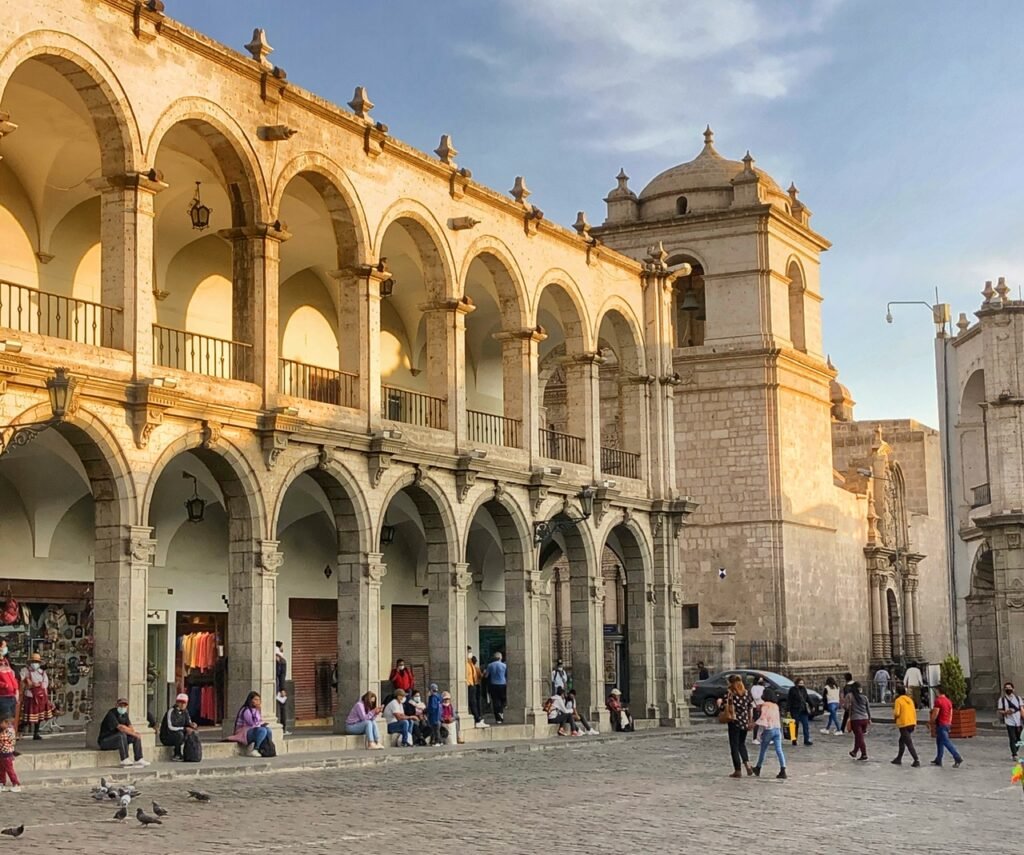
Arcades and stunning balconies line three sides of the square. There are also multiple rooftop bars and restaurants. We took the first photo at one of these bars called Waya Lookout, a very unpretentious and inexpensive place.
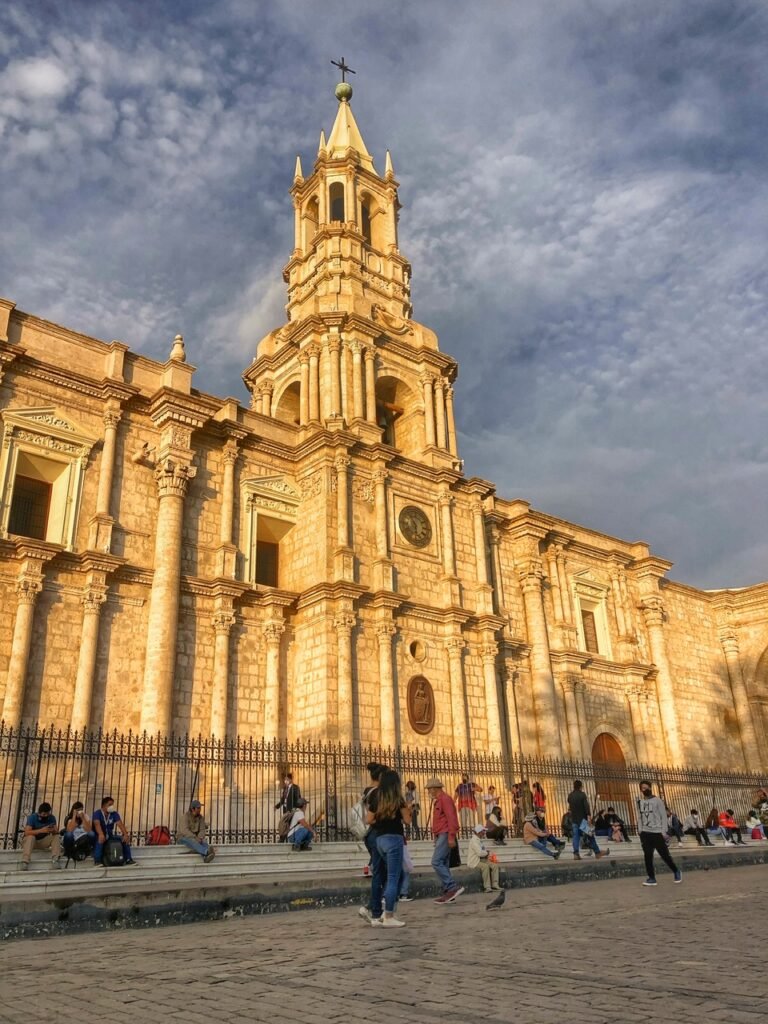
La Catedral is colossal…the only cathedral in Peru to stretch the full length of its plaza and something we’re not sure we’ve ever seen. Also very difficult to get a photo of the full width. In this precarious seismically active zone, it also has a history of rising from the ashes because the original structure from 1656 was gutted by a fire in 1844, rebuilt and then toppled by an earthquake in 1868. This new structure from the late 1800’s was then hit again in 2001 by another earthquake when the left tower crumbled completely.

The inside of the cathedral. It is open every morning but Sunday to the public.
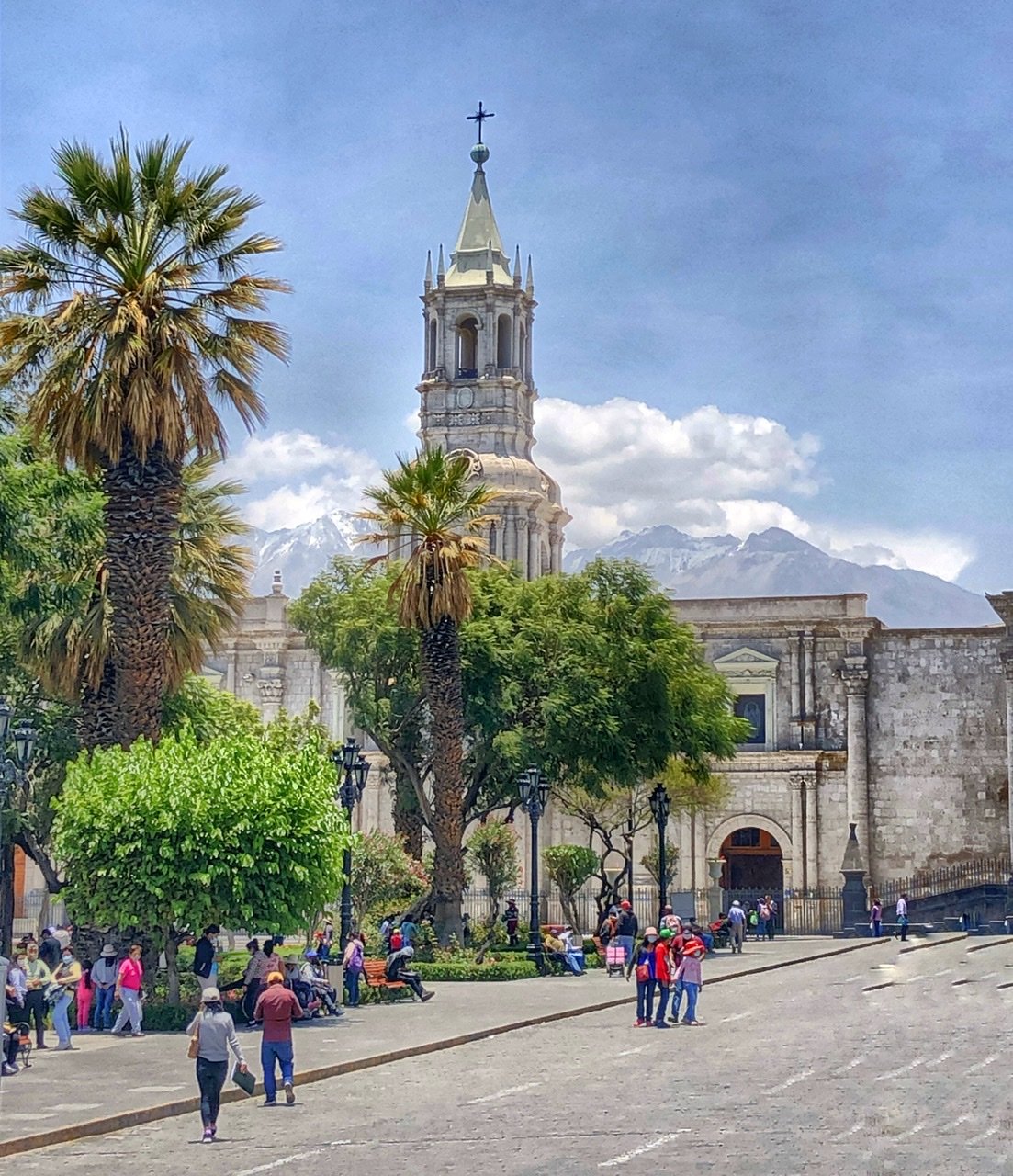
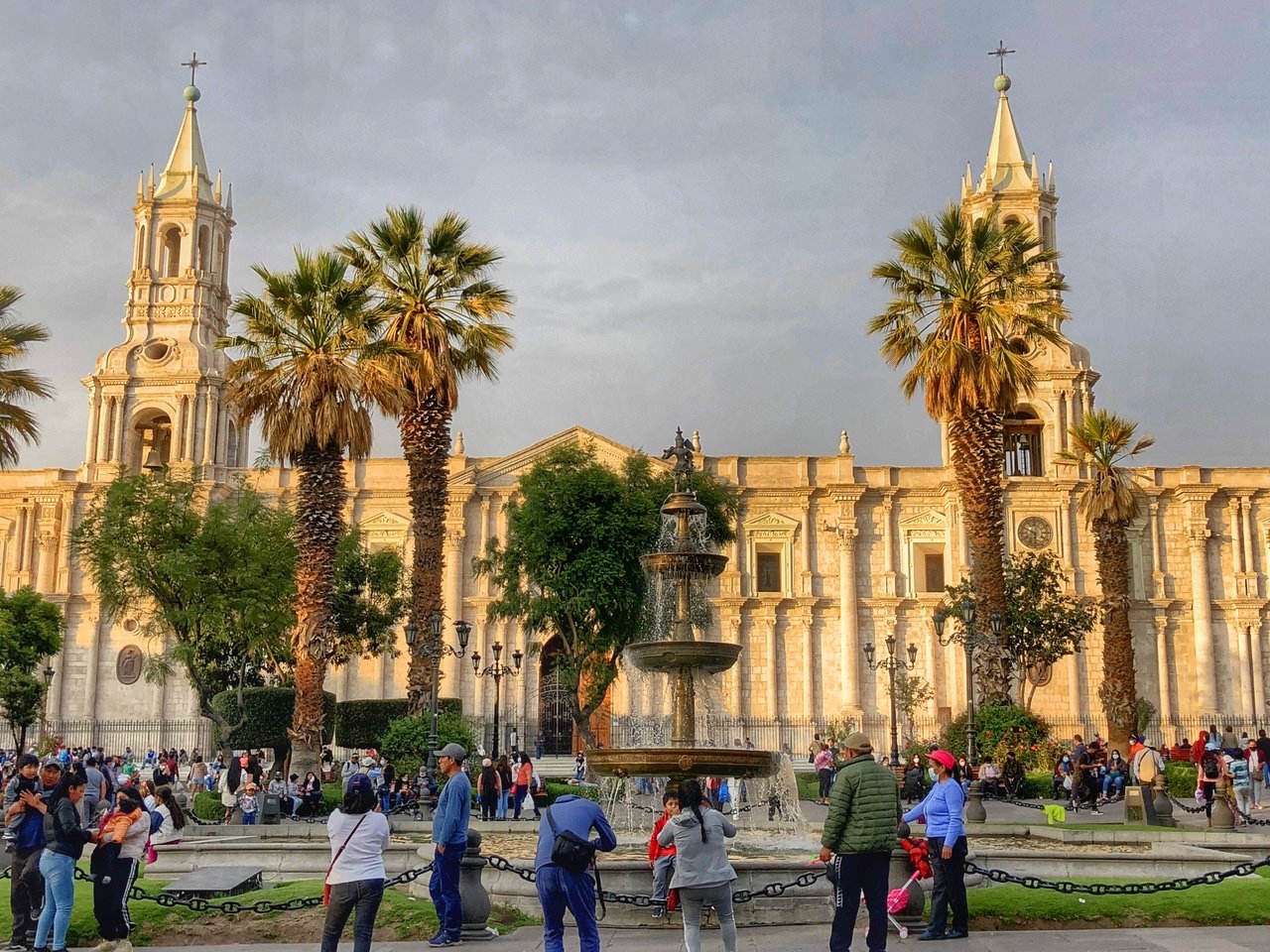
Other views of Plaza de Armas. We loved just sitting in this square. At left you can see a different volcano—Chachani. There are 16 in Peru and three in Arequipa.
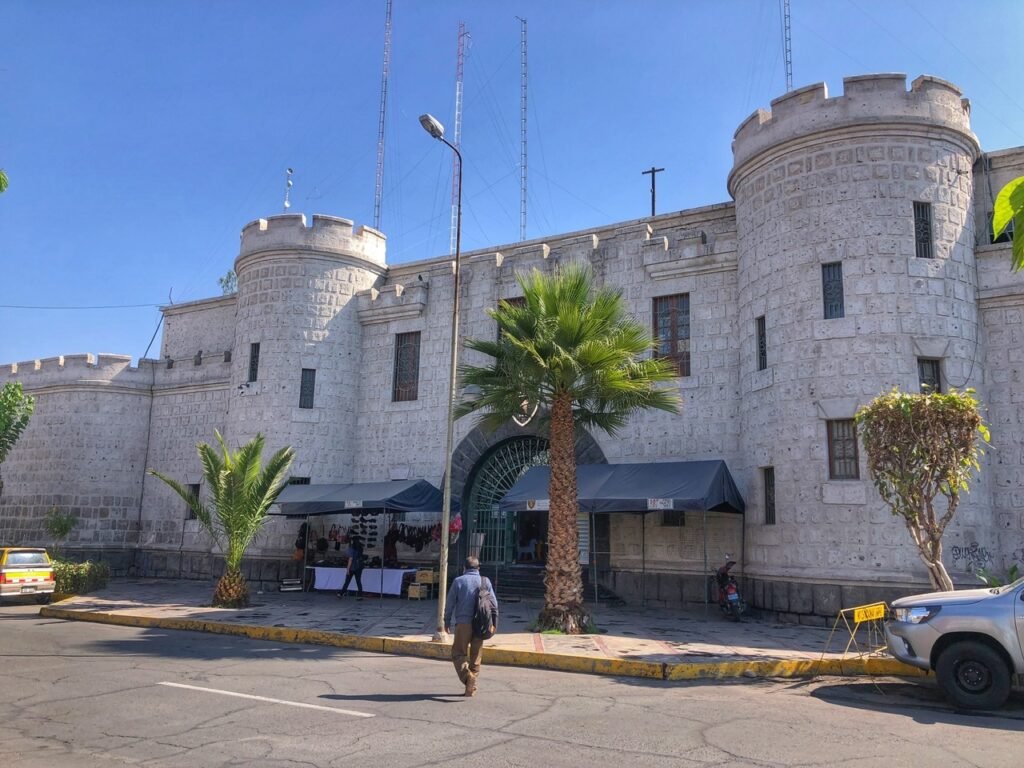
This castle-esque stunning building which seems to form two city blocks is the former penitentiary of Arequipa. We caught a peek of behind those walls and it seems it is now serves as the city’s junk drawer.

Parroquia Santa Manta has fantastic views of Mini and Chachani, one of the other volcanoes. It’s tricky to get a photo of both, however.
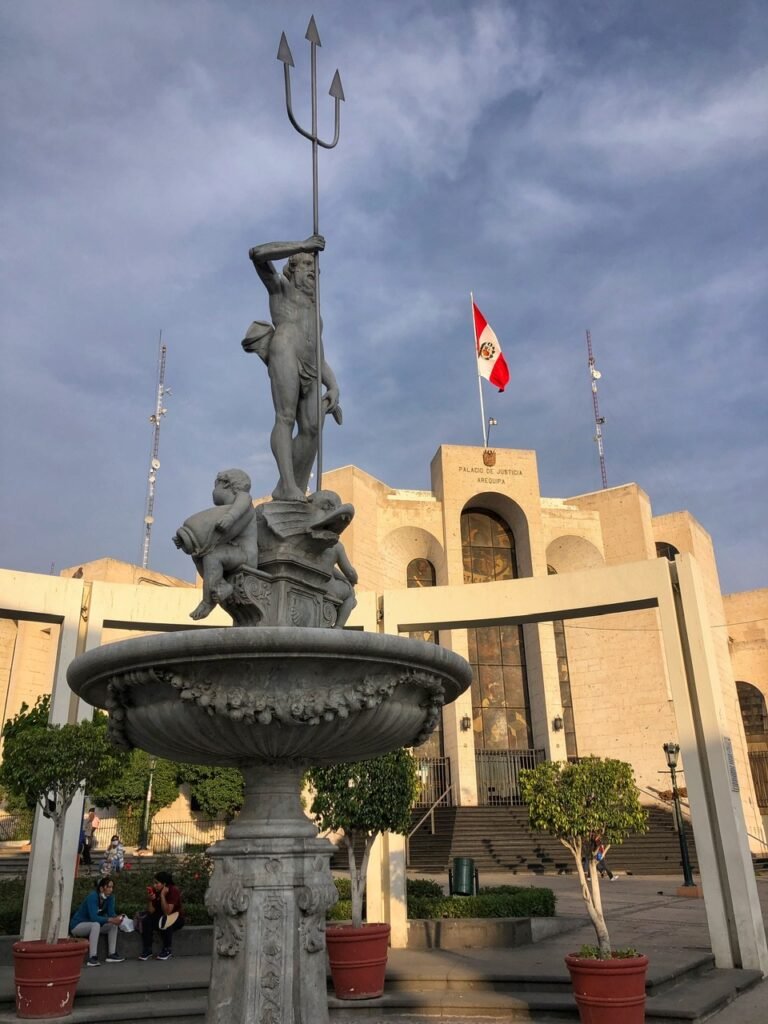
How’d Poseidon get here? Also, a glimpse of the Peruvian flag in the background. It was created in 1820 when Jose de San Martin arrived with his Army of the Andes from Argentina and Chile. The colors of red and white are said have been chosen because San Martín saw a flock of flamingos take wing at his arrival. Ummm…so…why he didn’t make it the world’s first pink flag is still a mystery? The Peruvian coat of arms is in the middle.
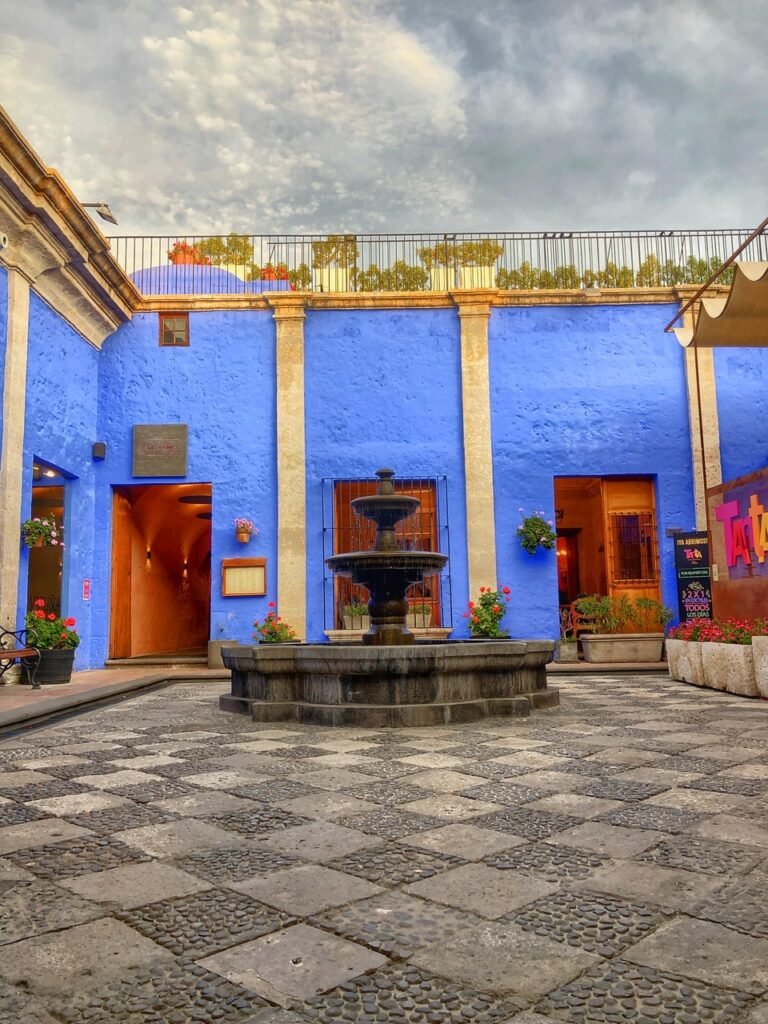
An arresting electric blue courtyard near the center.
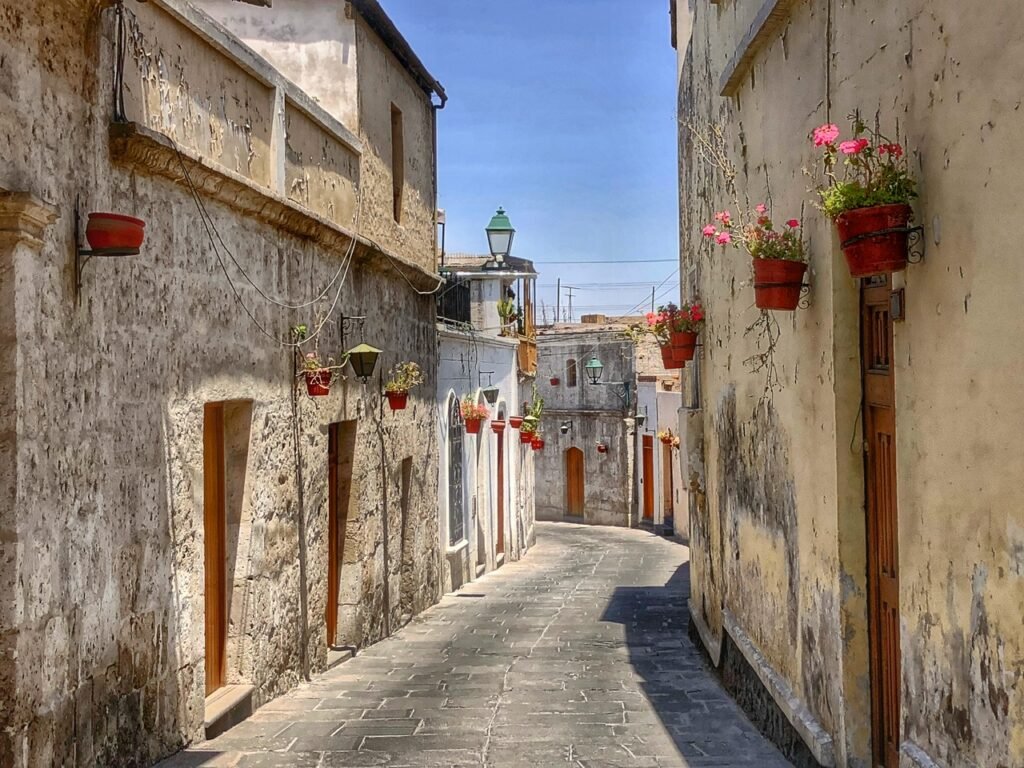
Pasaje de Los Cristales is not listed on any map or guidebook as a place to check out, but it’s probably the cutest part of the city we stumbled upon, especially contrasted with that penetrating blue sky. Felt a bit like Malta.
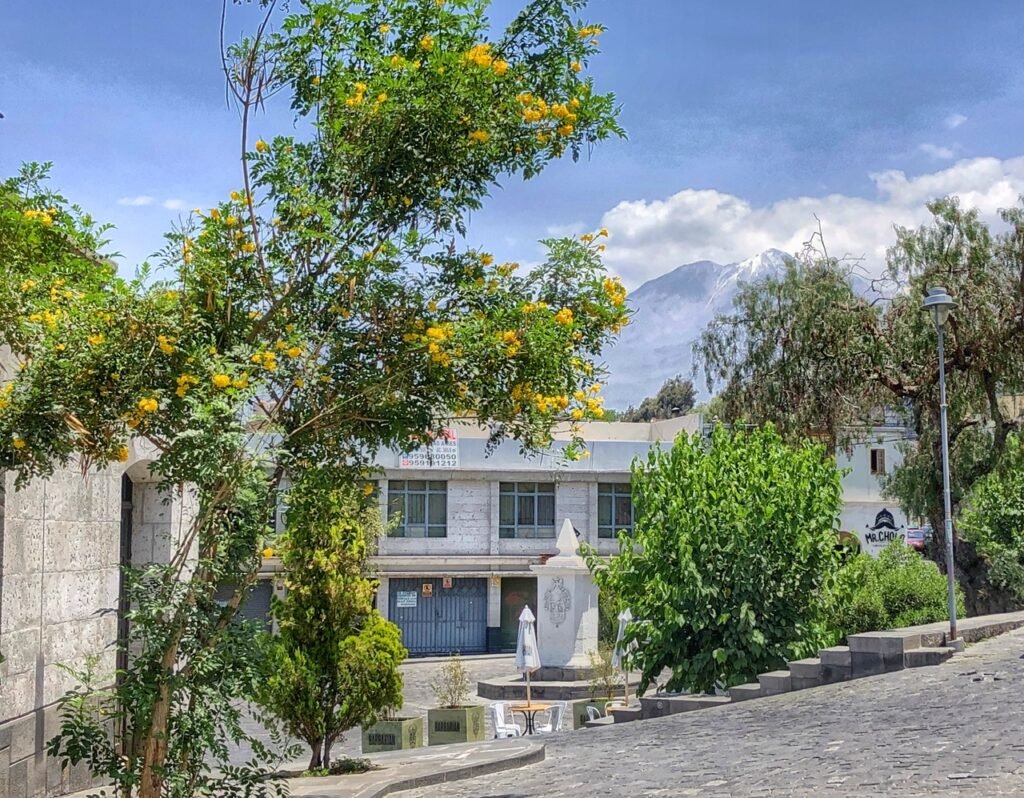
The mountains try and grab attention from near Plaza Campo Redondo. It’s near Chelawasi Public House.

Our free walking tour guide seemed to be putting himself out of business when he pointed out these signs, which are all over notable buildings of the city. They indicate a QR code is on the building which you can scan and get a history/summary of where you are. How brilliant. Can we please make this idea global?

Al fresco dining is everyone in Arequipa.
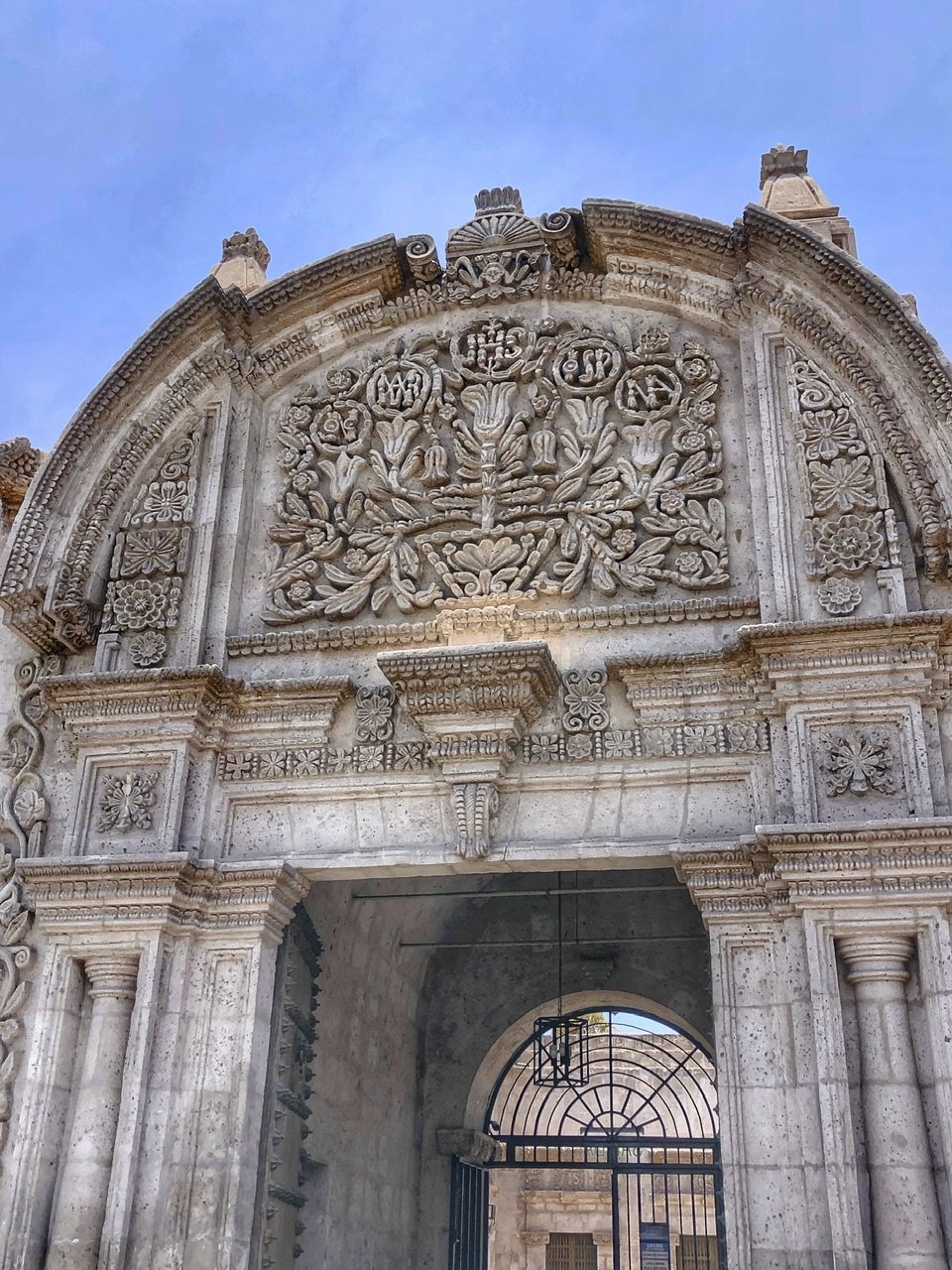
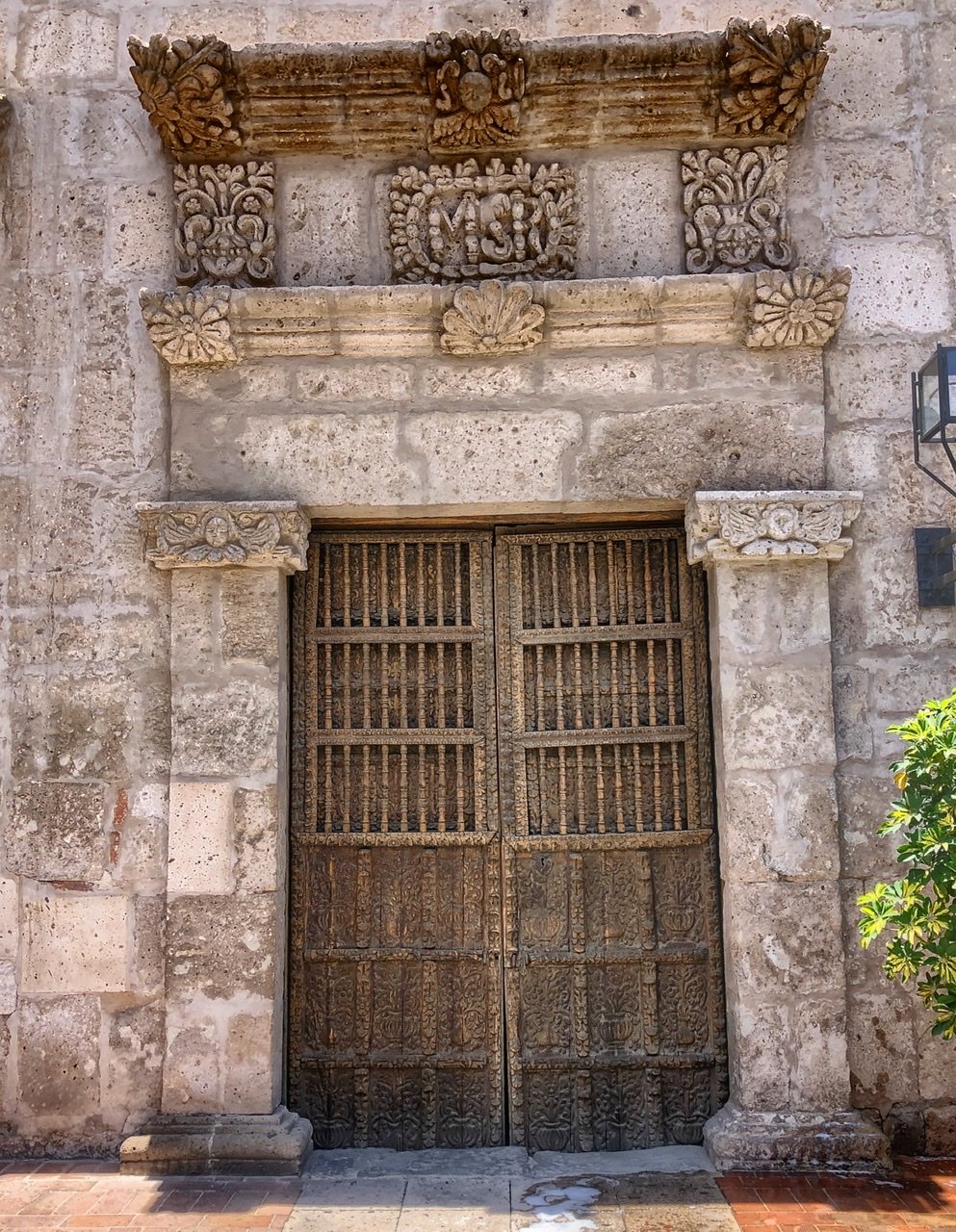
Casa Tristan del Pozo is an 18th-century residence with an ornate baroque entryway, which has since been turned into a bank. <Sigh> Well, at least it’s not a parking lot. The details are incredibly ornate. Our walking tour guide pointed out that the letters over doors had to do with civilians trying to prove they weren’t heathens to the Catholic Church, as they referred to Mary, Joseph or saints. Hmmm, not sure why a simple classic cross wasn’t just chiseled in…

The Church of the Company is a small baroque church noted for its elaborate carved facade and an interior chapel with jungle motifs. We didn’t get to see the jungle motifs during our tour because a service was happening and that would be rude.
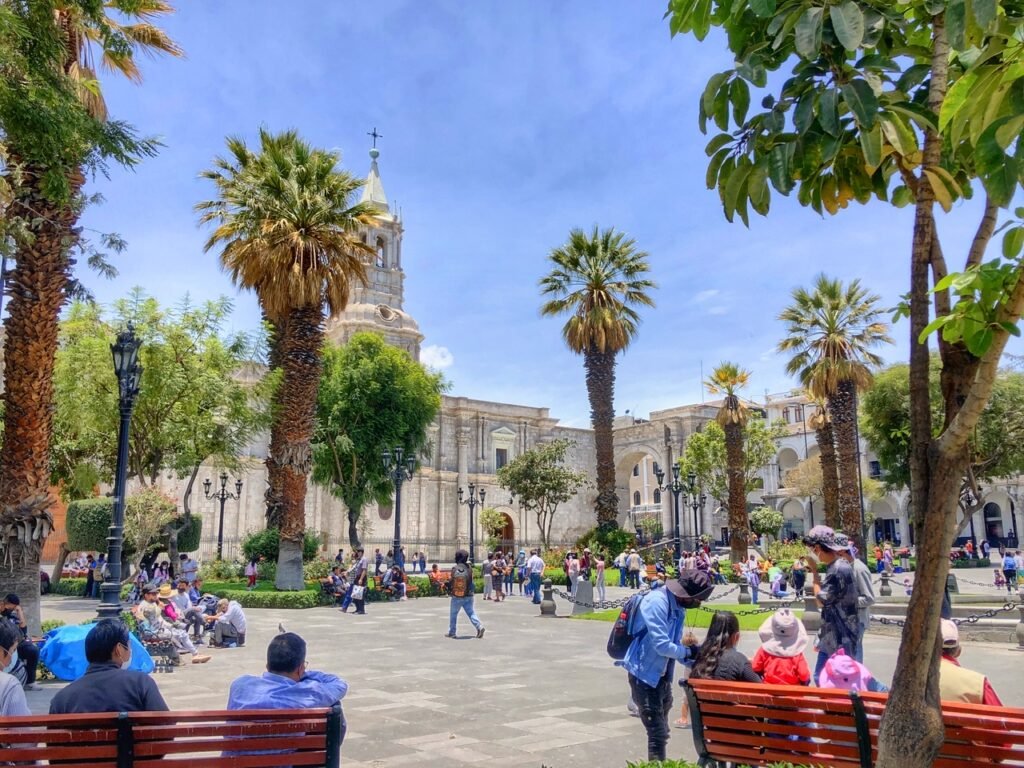
Wondering where Arequipa got its name? To us, it sounded a lot like the Colombian milky caramel of arequipe, but it has nothing to do with dessert. Legend says that the fourth Inca King, Mayta Capac, was traveling through the valley and became enchanted by it. He ordered his people to stop saying “Ari Quipay” which means “yes, stop” in the Quecha language.
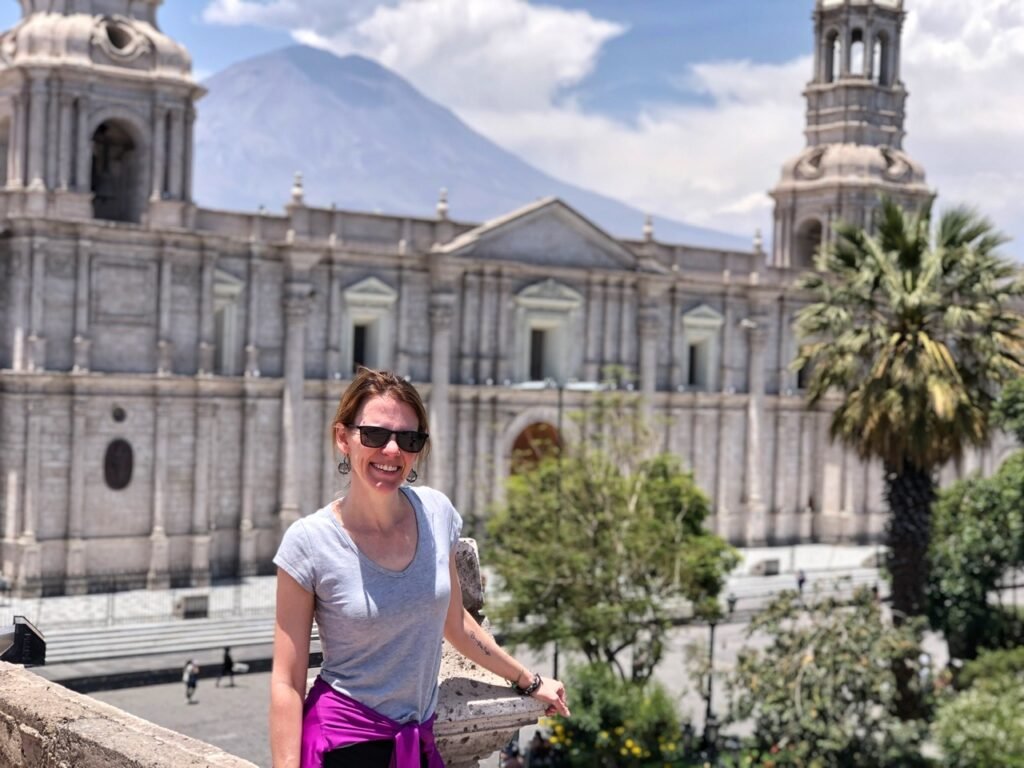
Mandy and Greg were there too.
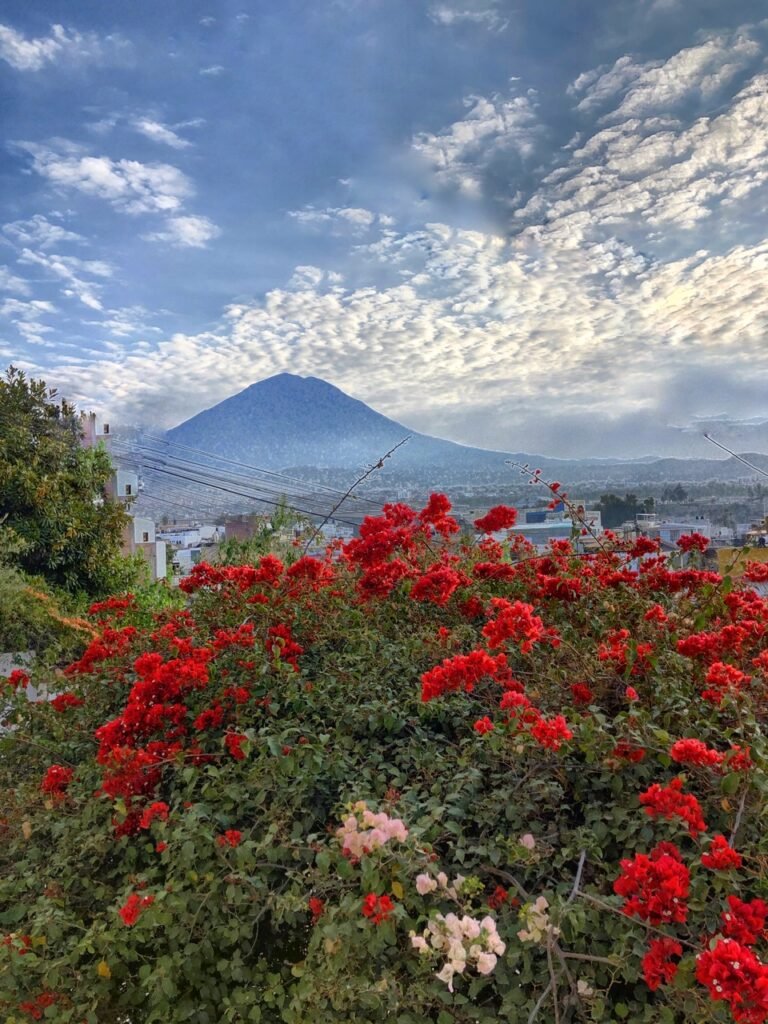
One morning we woke up at 5 and walked 40 minutes up to the Yanahuara Scenic Overlook, deemed one of the highest and best views in the city. (It’s not that high). We prefer the rooftop bars, and accompanying drinks. Haha.

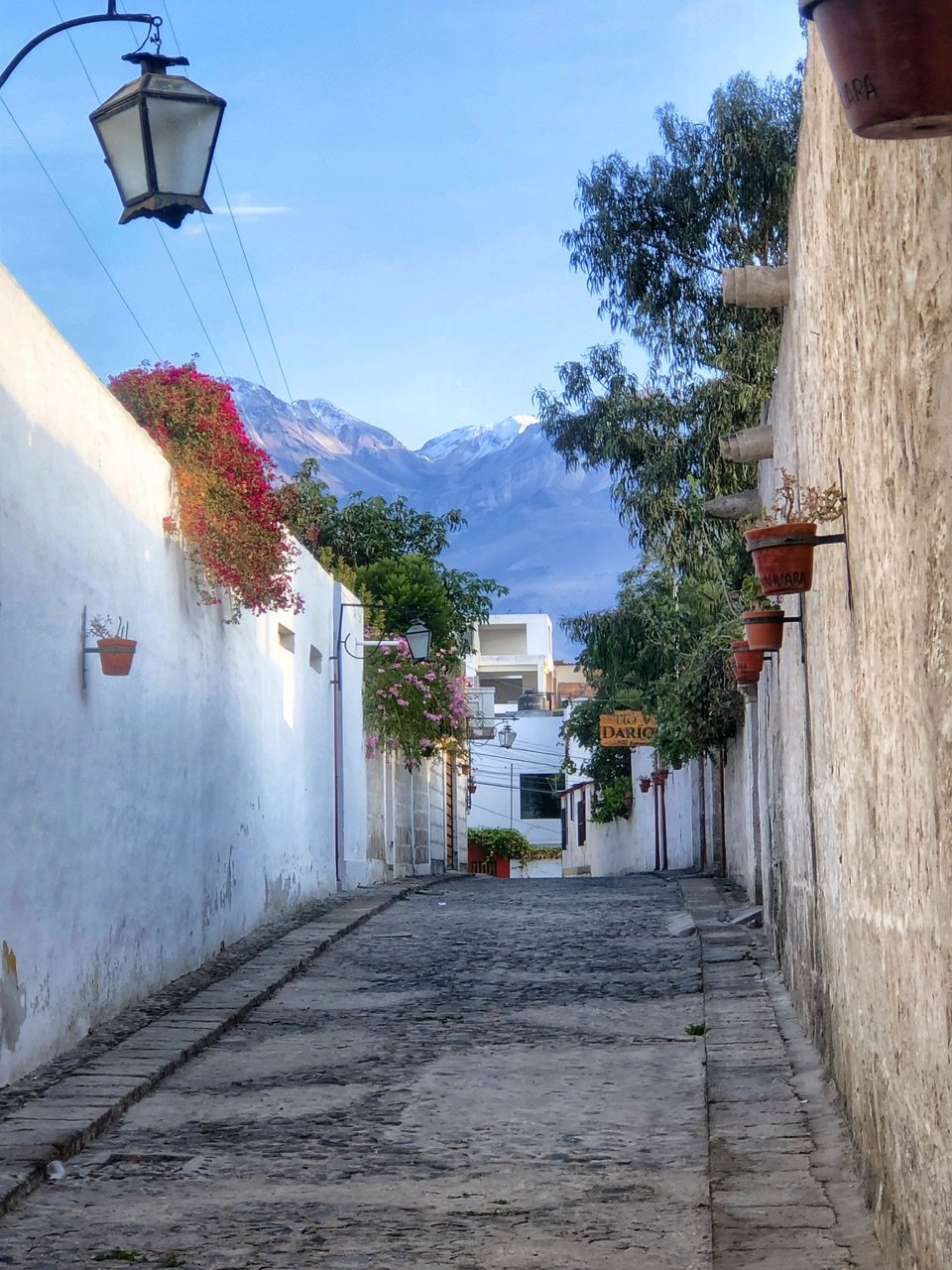
The Plaza near Yanahuara was incredibly peaceful at 6:30 in the morning. Seriously, never seen so many social distancing signs though. Of the six countries we’ve traveled in since the pandemic began, Peru gets top marks for their efforts. Of course, they also had the most worldwide deaths per capita, so I guess that actually scares some people. At right, an empty street with an astounding view.
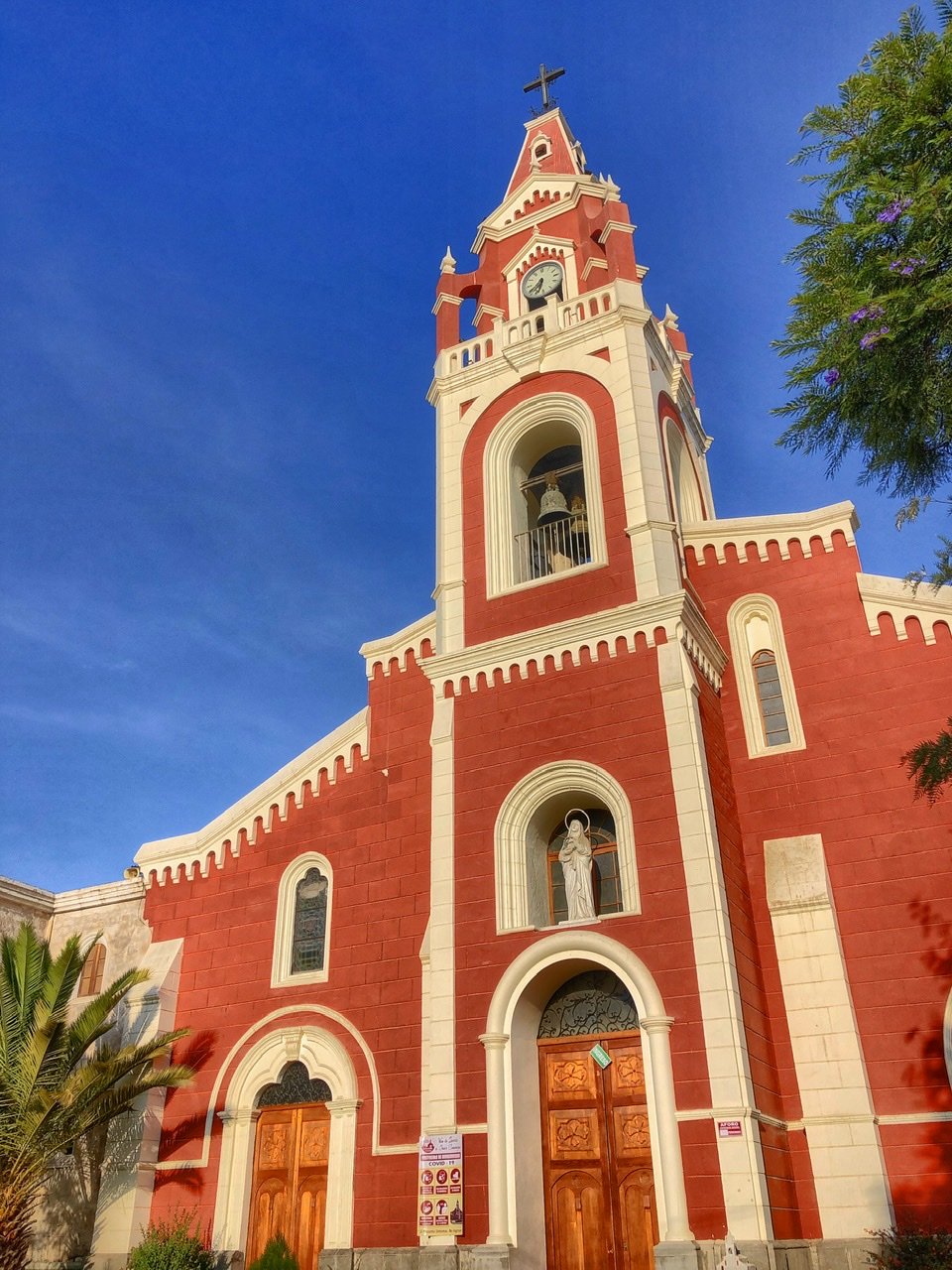
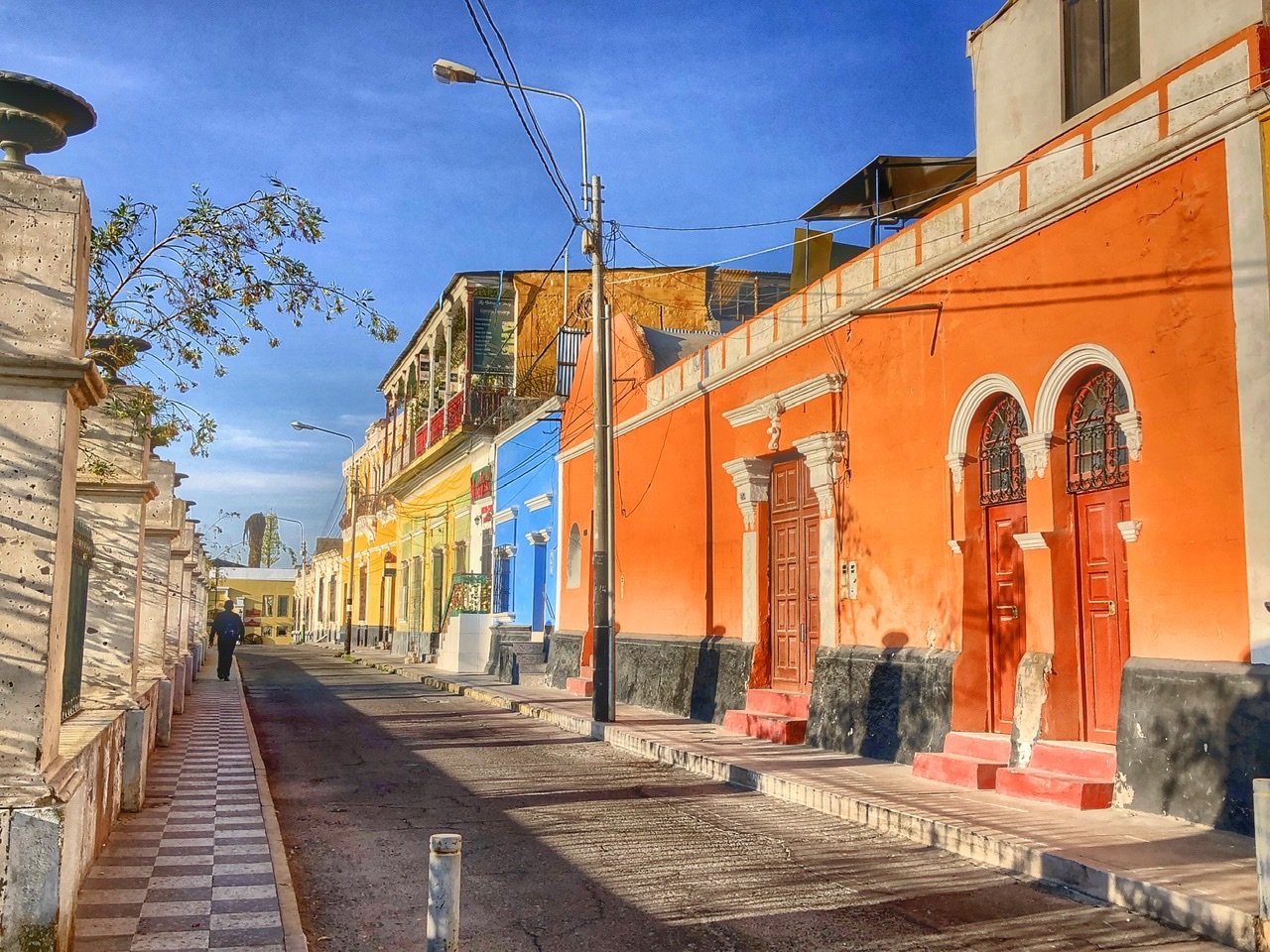
The radiant red of this church/former monastery in Recoleta stuck out like a sore thumb in this city of white. As did the street on the right.

A view of the Andes and Chachani Volcano as seen from the Bolgnesi Bridge.
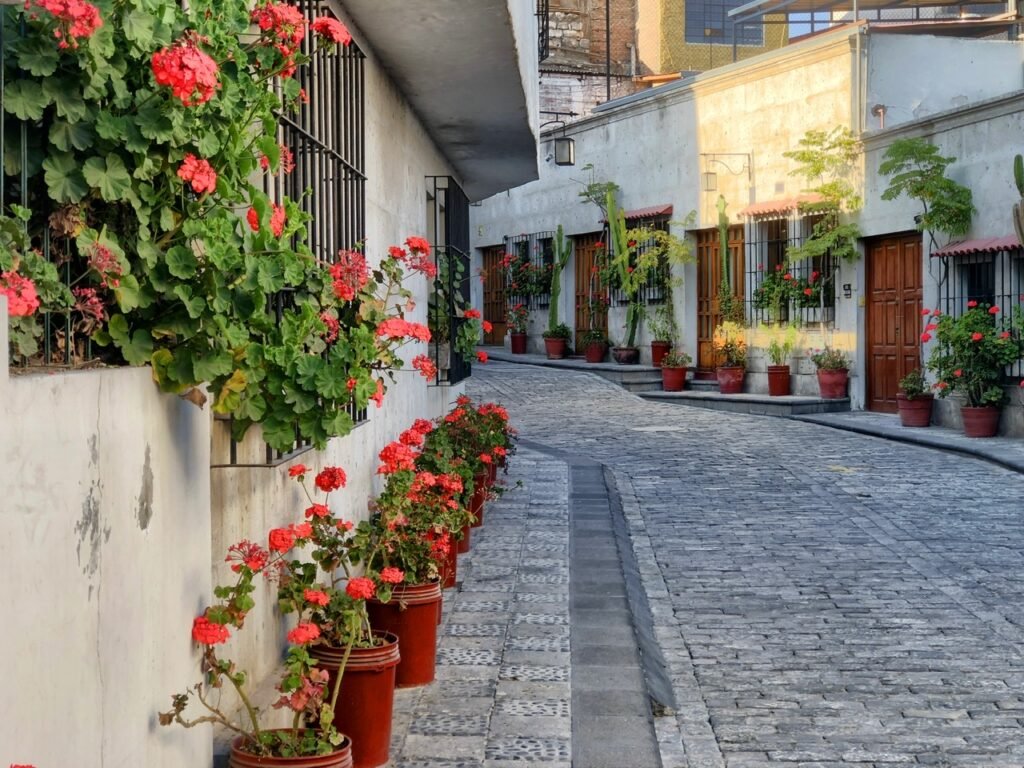
The charming street of Del Solar, which was listed in the guidebook, though the far cuter Las Cristales was not.


Another elaborate doorway. The details are extraordinary. Obviously sillar stone is very easy to carve with.
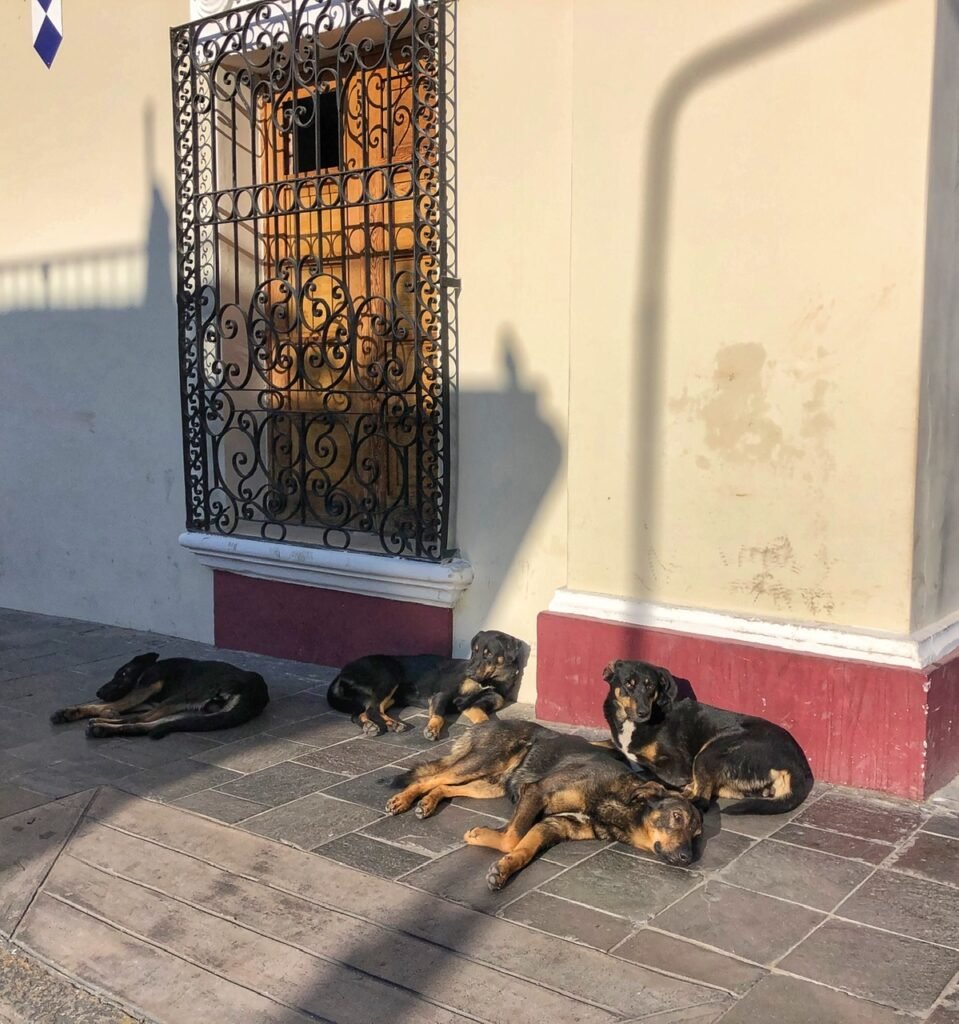
This is a common and heartbreaking problem in Arequipa and the barking is incessant. Sometimes we feel like we’re back in Mexico.
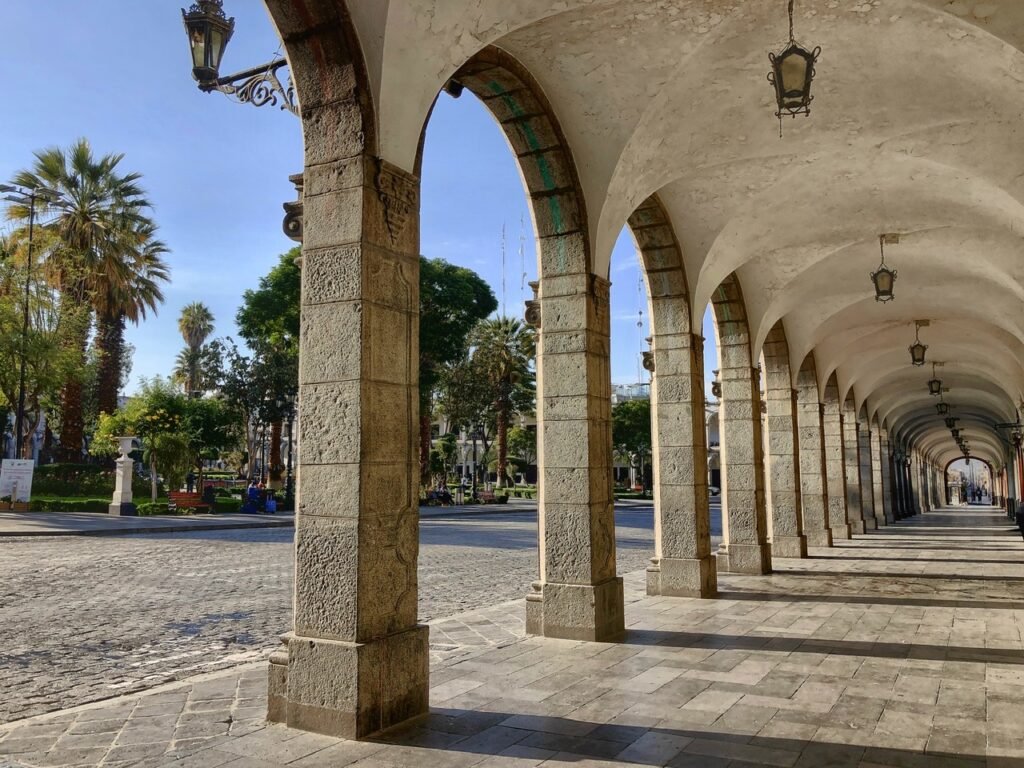
The arcade of Plaza del Armas in the early morning light.
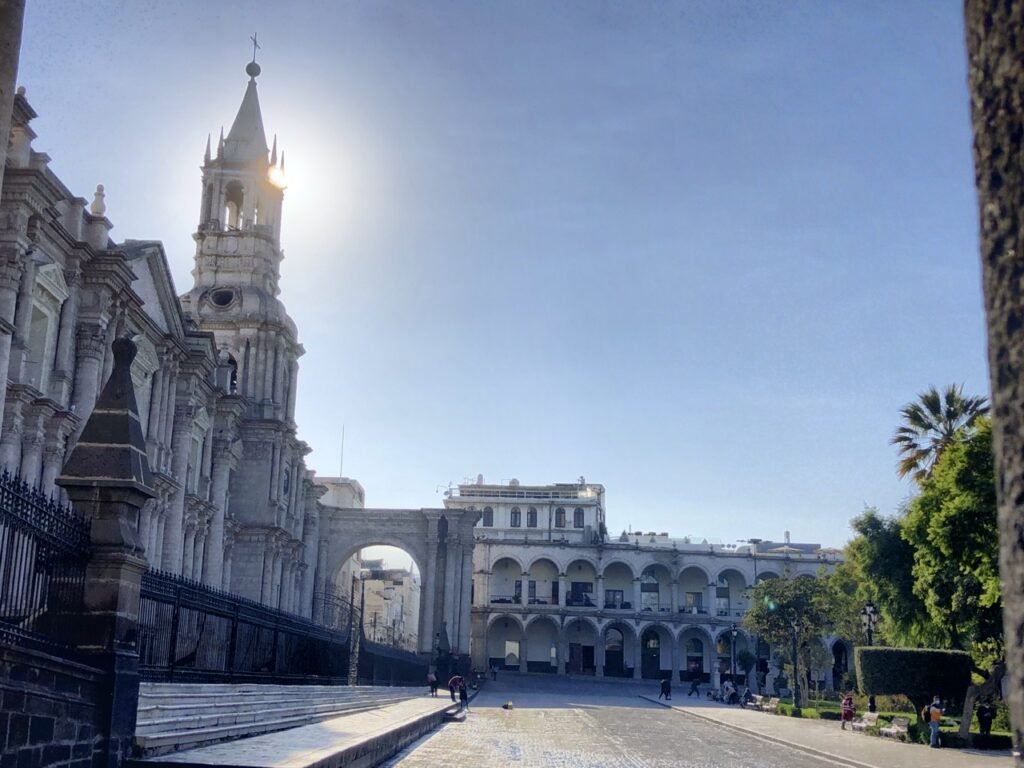
La Catedral at about 7 am.
Sabandia Mill
Como se llama? It wouldn’t be Peru without a lame Spanish joke about their cutest critter, nor without snuggling up with a baby alpaca and touch testing all the different varieties of fur found on said critters. And we found a wonderful place to do just this at Sabandia Mill, set in a vast agricultural valley 25 minutes outside of Arequipa. This mill was built with sillar, the same white volcanic white rock as Arequipa, in 1621 by Francisco Flores. We got there by taking the “A” bus on Indepencia Avenue for 2 sols or $.50 each. We couldn’t have asked for a better way to spend our Valentine’s Day.
This video is of a vicuña which is one of two South American camelids, normally only found in the wild in higher regions of the Andes. They are known worldwide for the rarity, exclusivity and price tag of their wool. (Around $5,000…yes dollars…for a sweater.) This is because Vicuña coats grow very slowly, and sometimes they take as long as three years to grow back after being sheared.

A baby alpaca we fell in love with. We called him Hercules. Alpacas are different from llamas because of shorter necks and rounder, squishier faces. Yes, that’s the scientific term.

One of two kinds of llamas. Llamas are part of the camel family even though they have no hump.
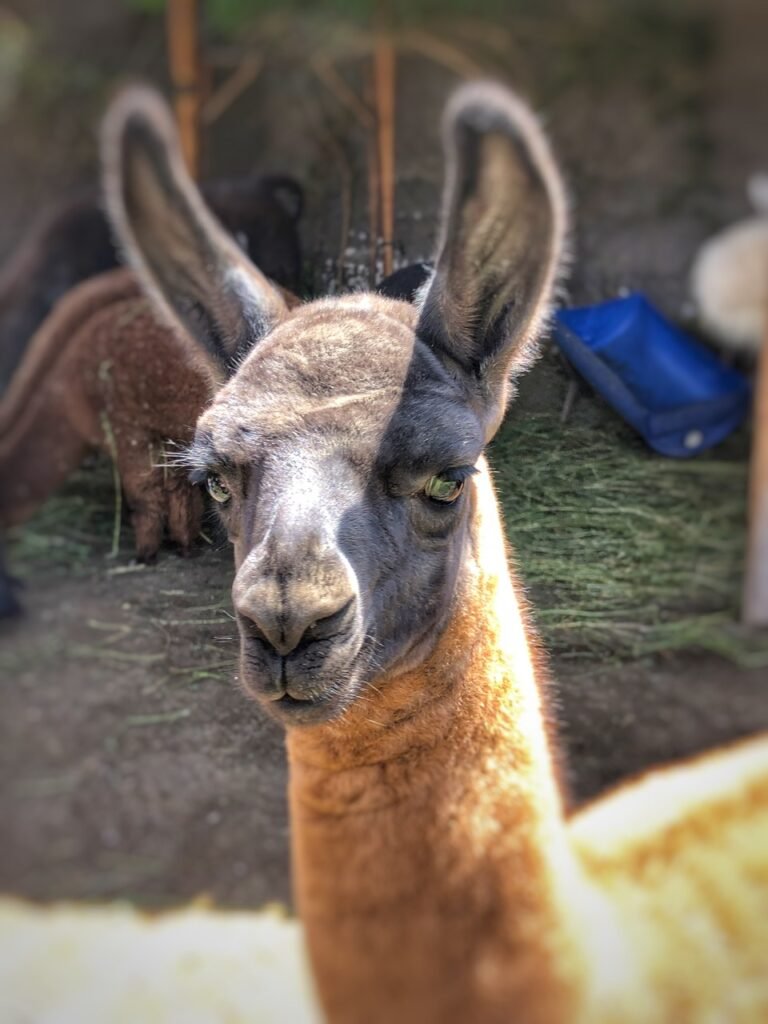
Another type of llama. Llamas are said to date back 40 million years to the central plains of North America, but they became extinct there during the Ice Age. The only ones that made it were the ones who plowed their way across the Panama Canal into South America.

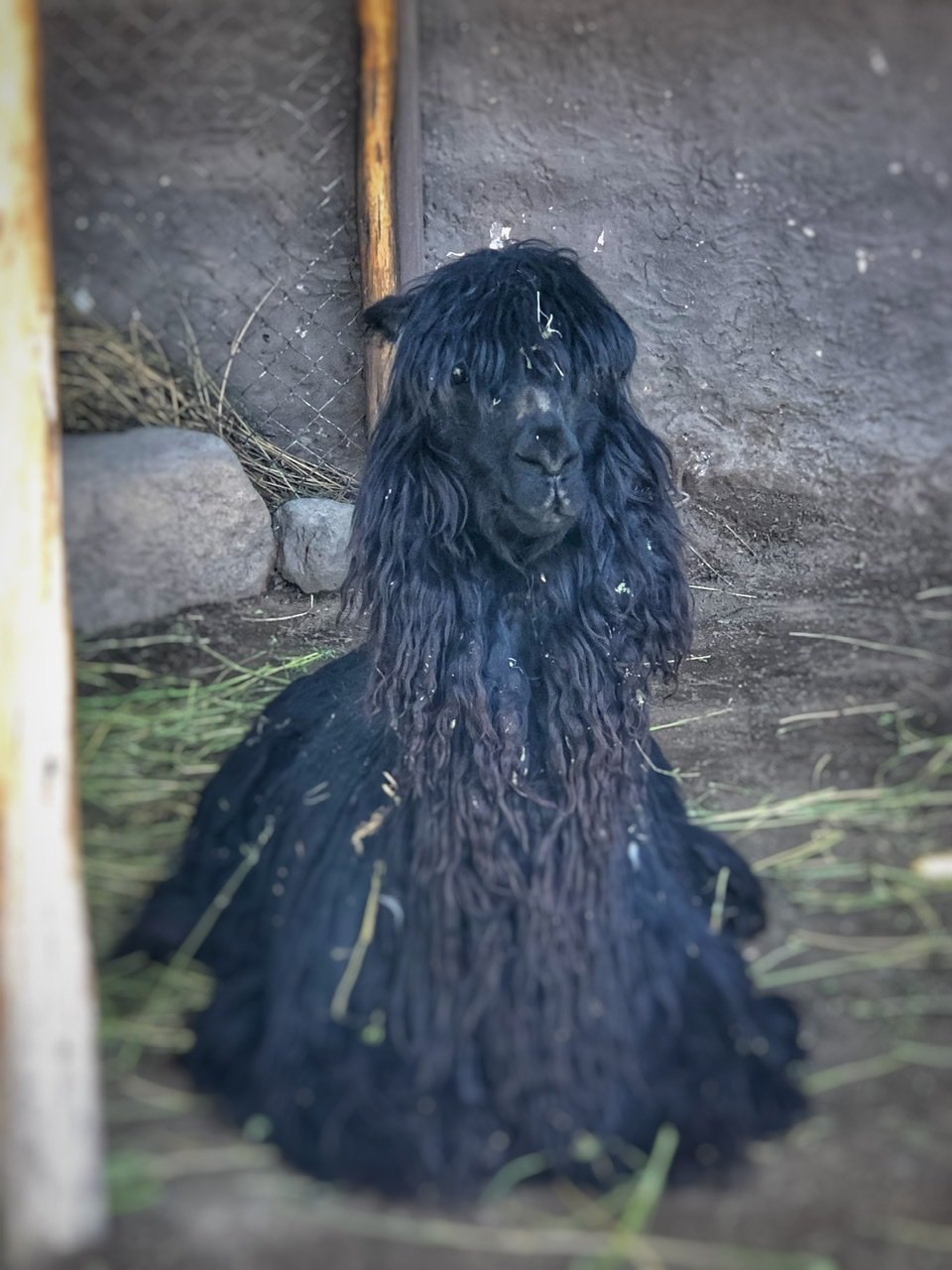
Mandy trying to get a pet on the other type of alpaca which, when that hair is grown out (right), is similar to Rastafarian dreads! ?

Walking around the mill was incredibly tranquil but we were surprised how many people were there on a Monday. Apparently it’s the place to take your Valentine.
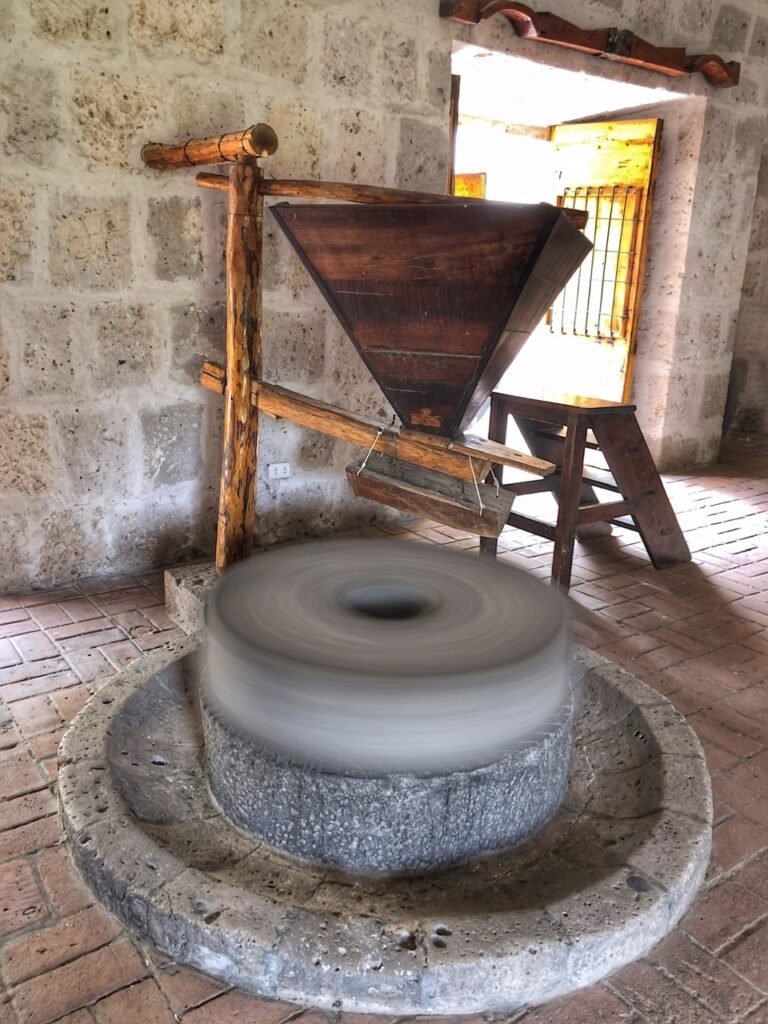
One of the still working grinding stones of the mill.
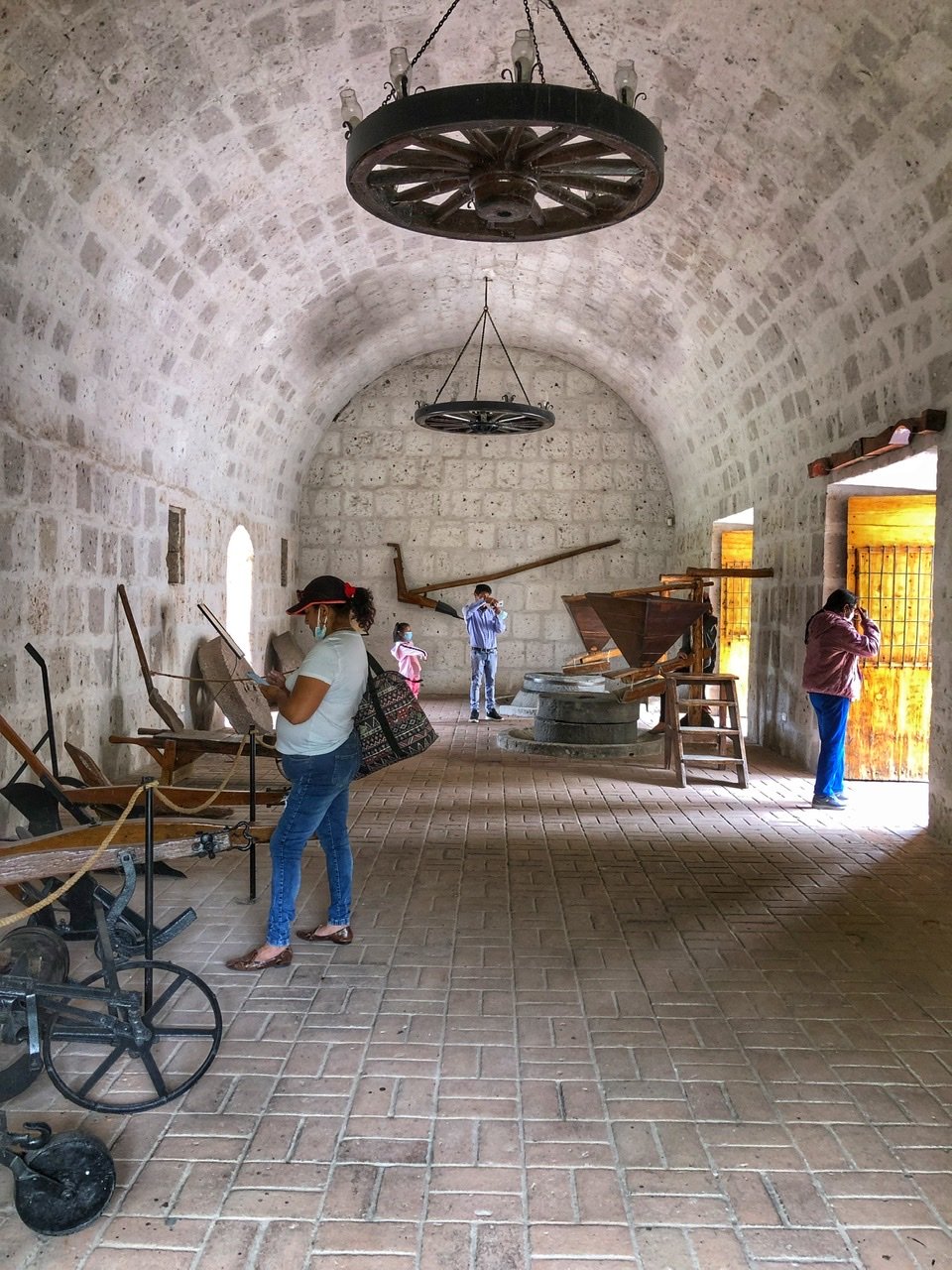
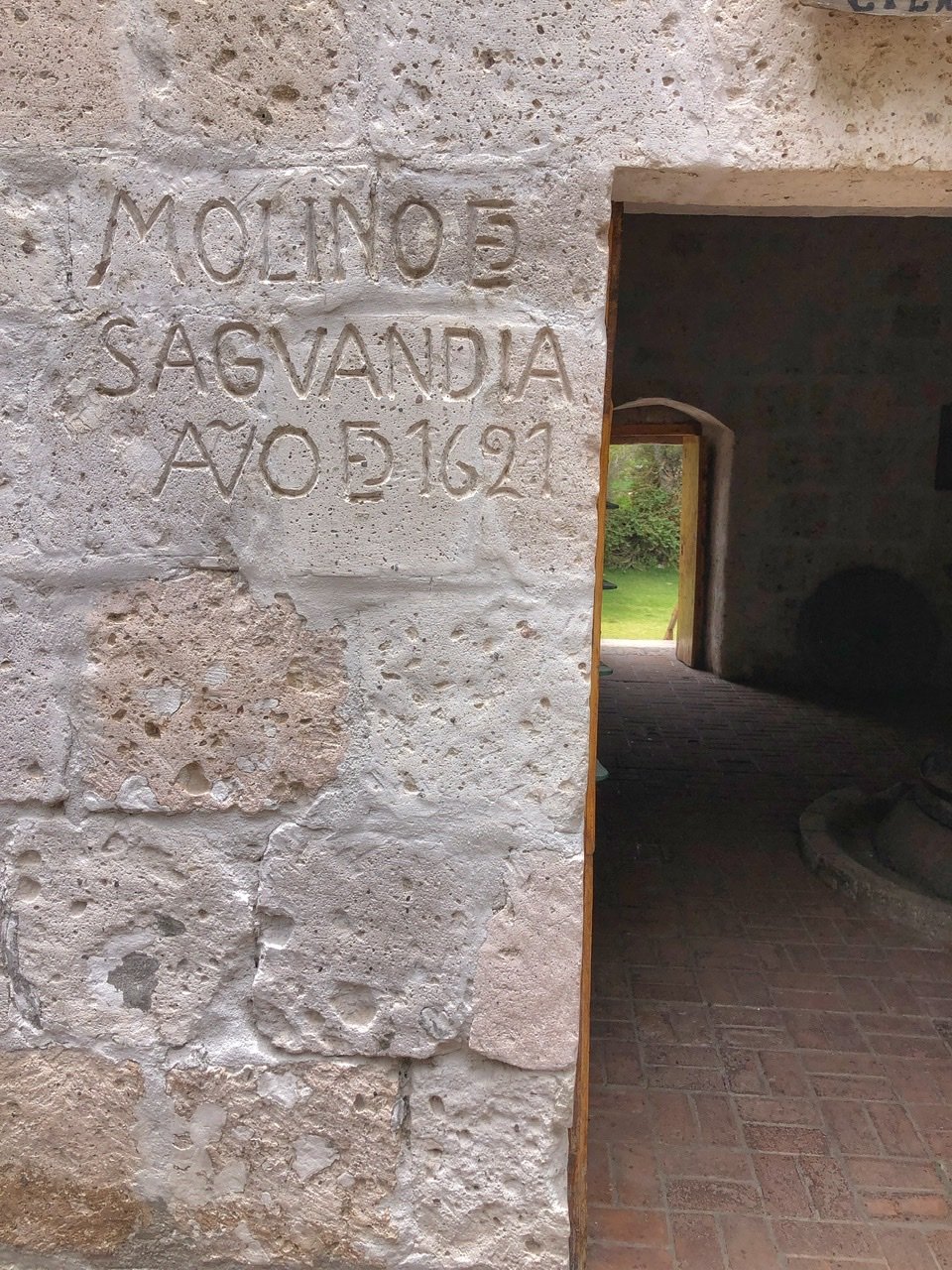
The equipment museum. And, the date stamp. Wow. 1621 is really old for this half of the world!

The inner workings of the mill.

We loved the crystal clear serene streams that ran throughout.
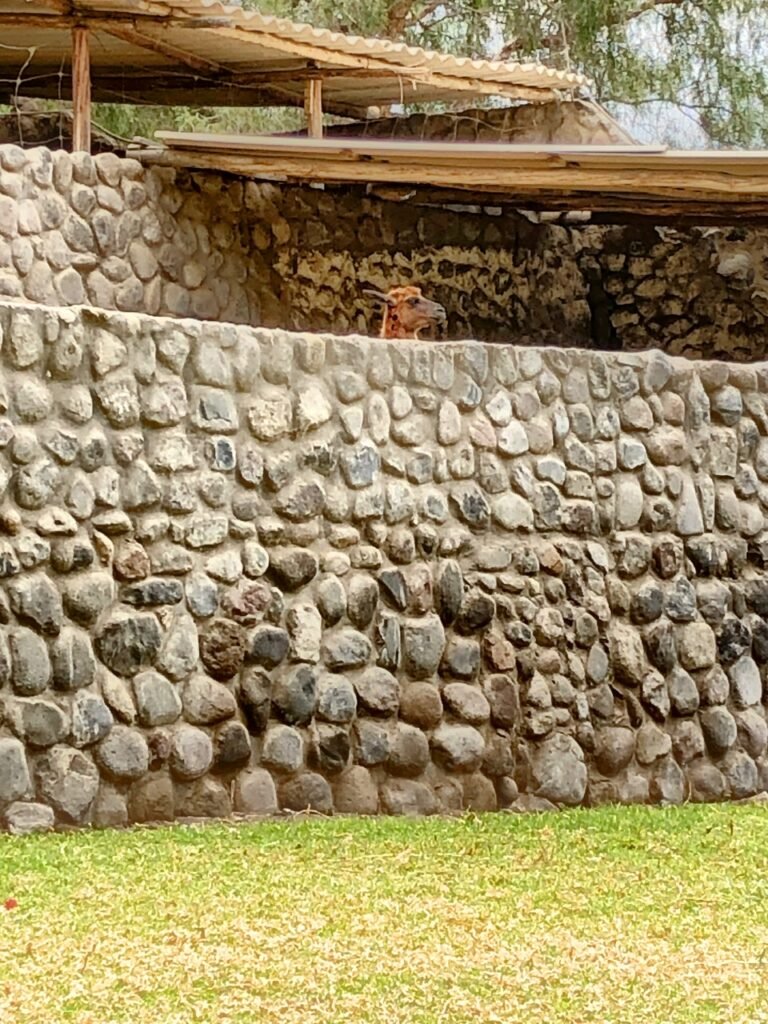
Hey! Who’s out there?! Do you see him?
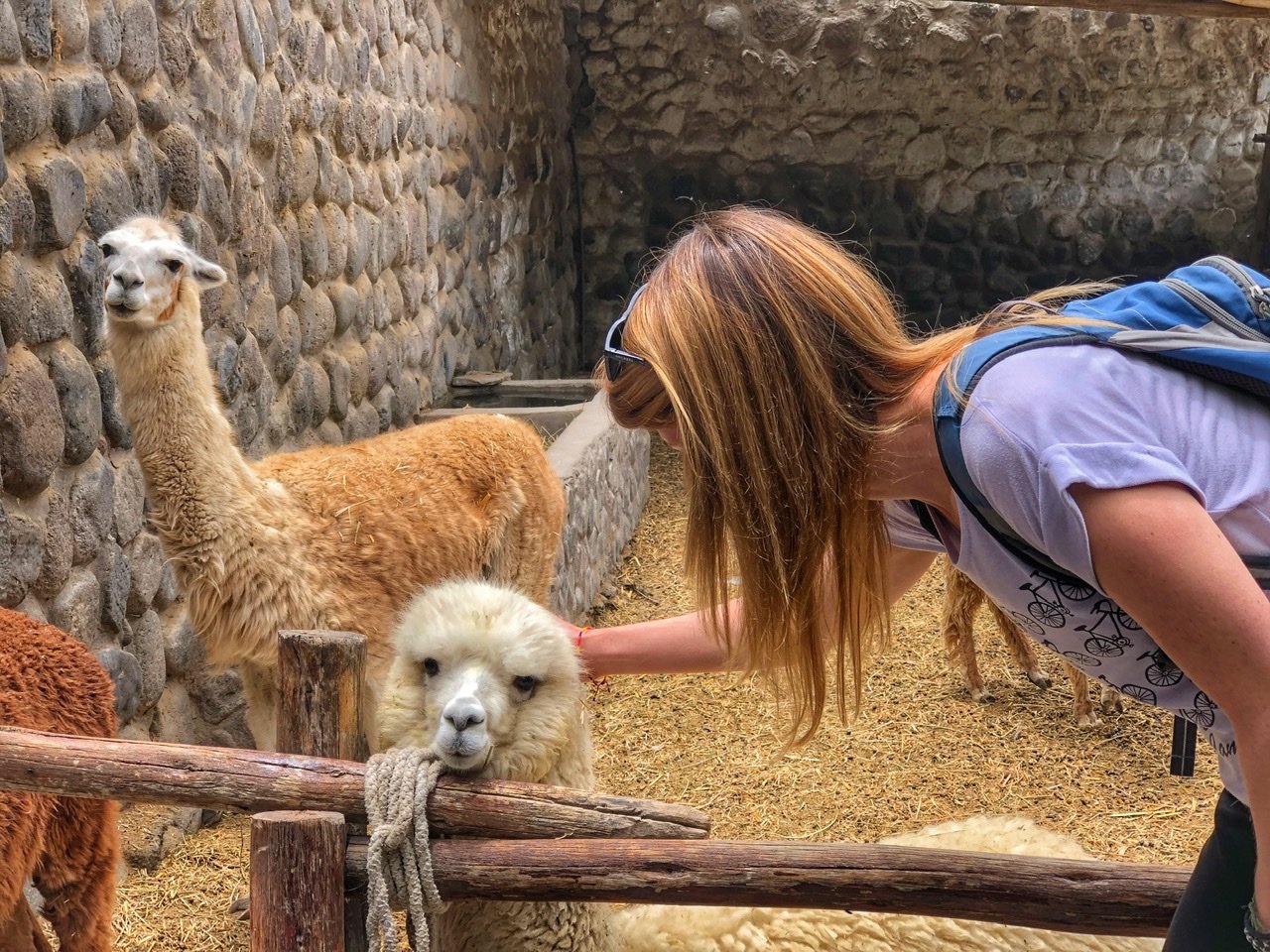
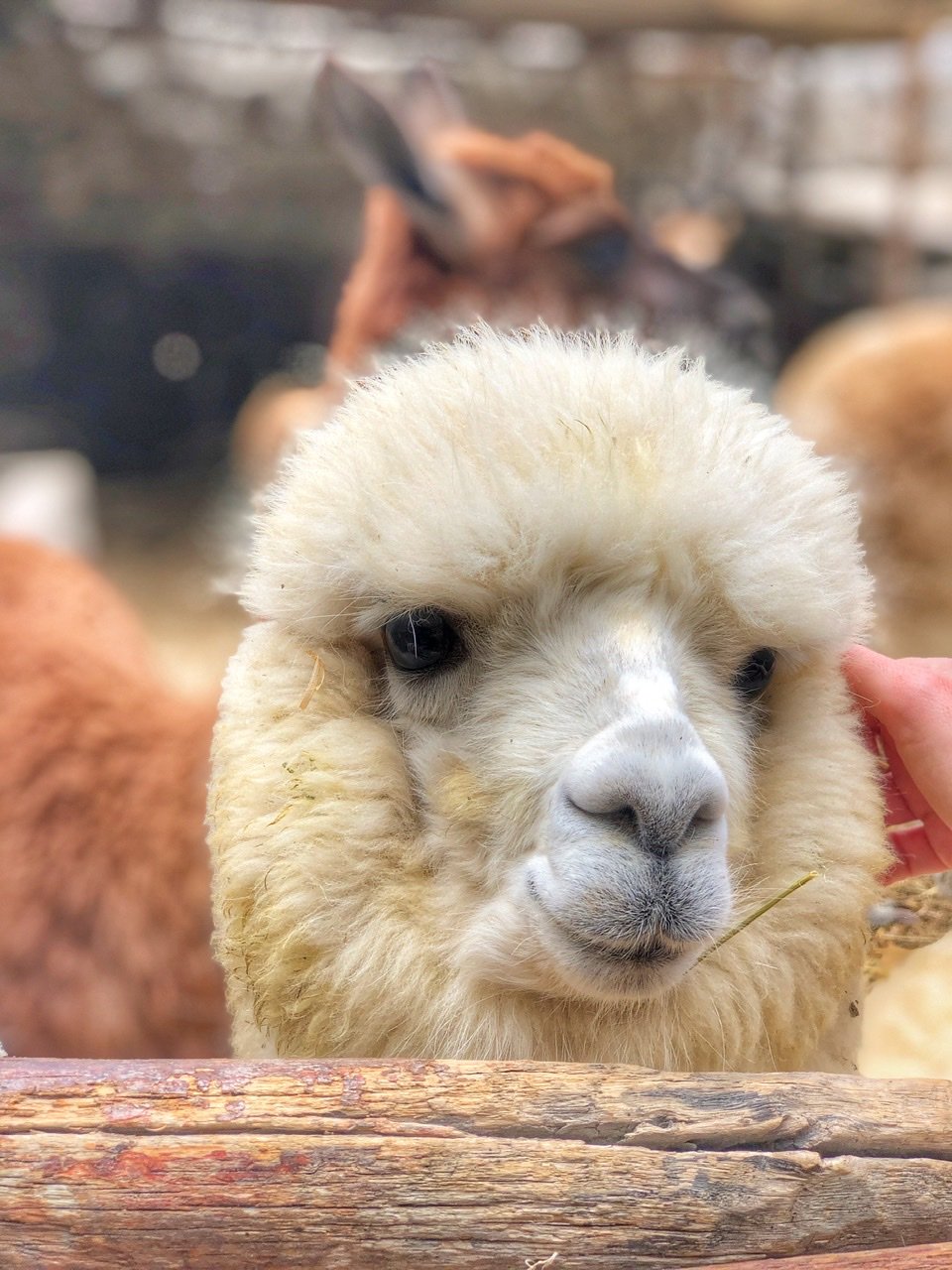
Back for more cuteness overload.
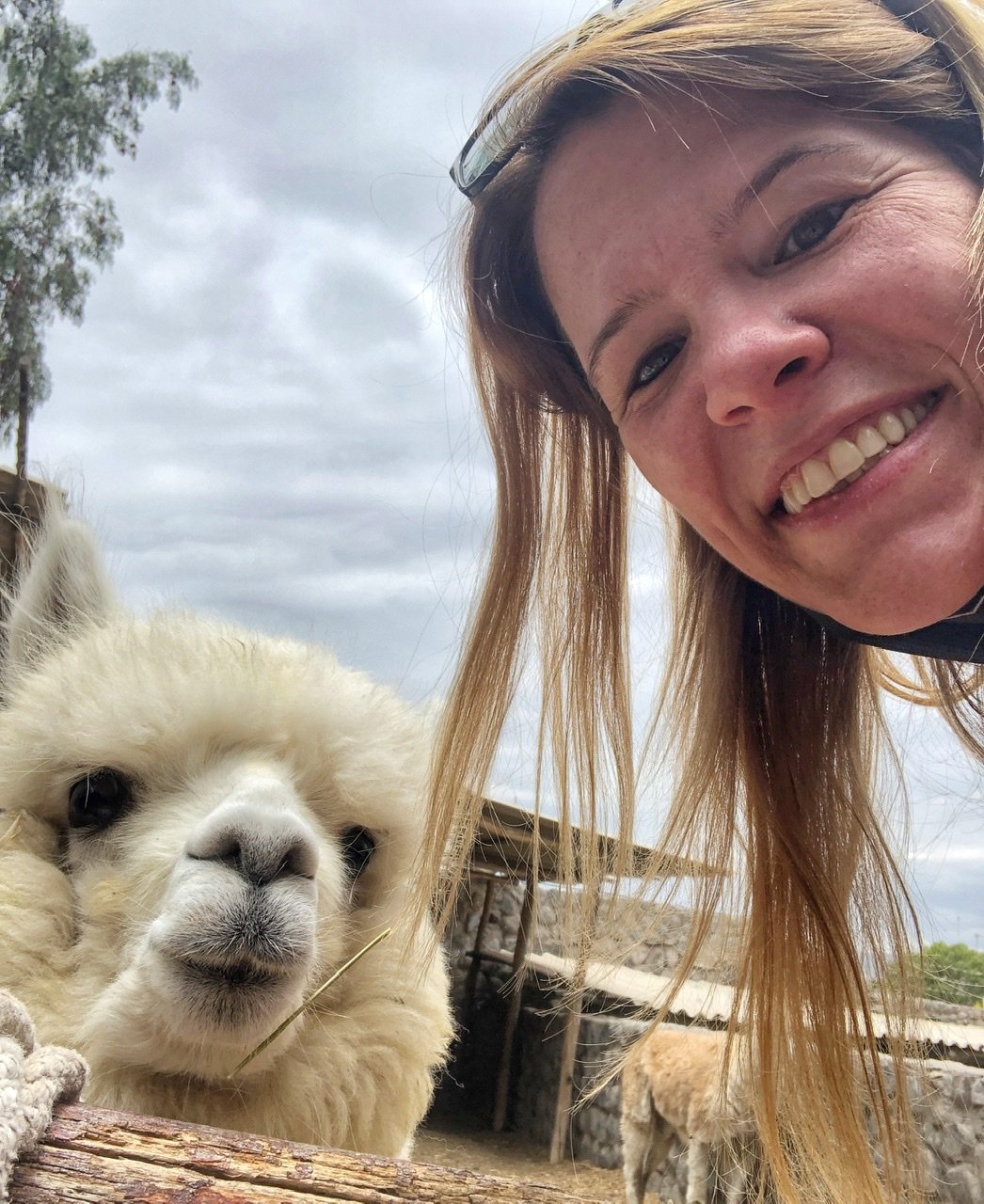

Greg better watch out. Mandy has never been so smitten.
I think we spent an hour hanging out with Hercules.
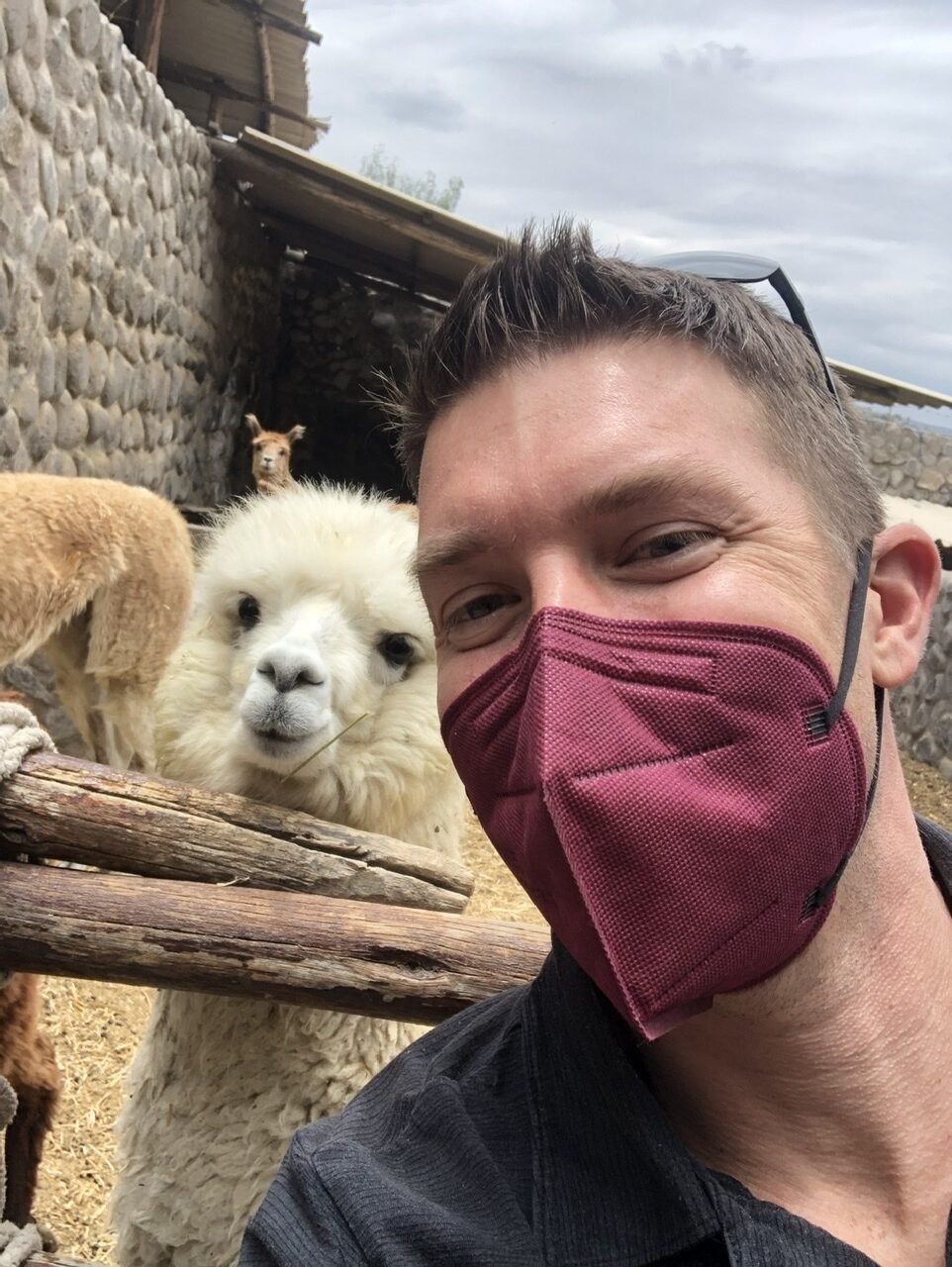
Greg took a turn too.
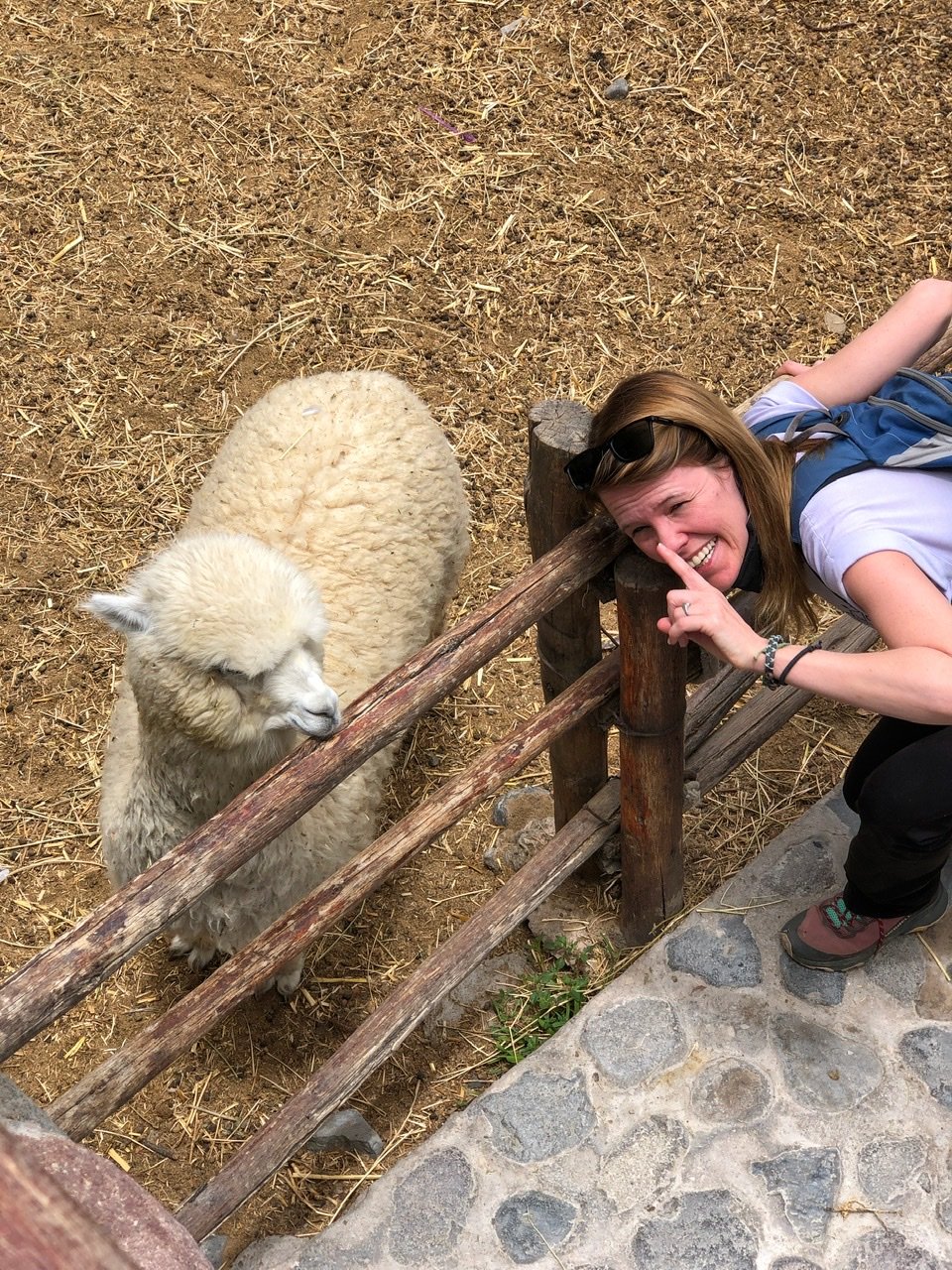

Going in for a sneak attack….but then Greg said it was time to go.
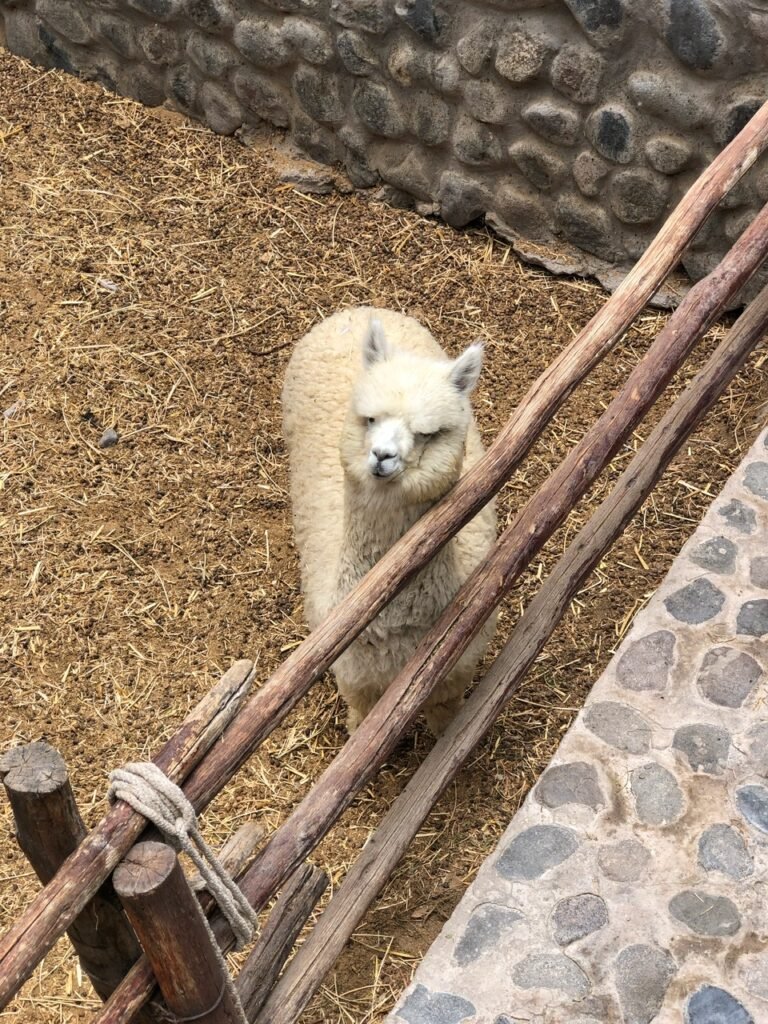
Oh…wait…please don’t go!!
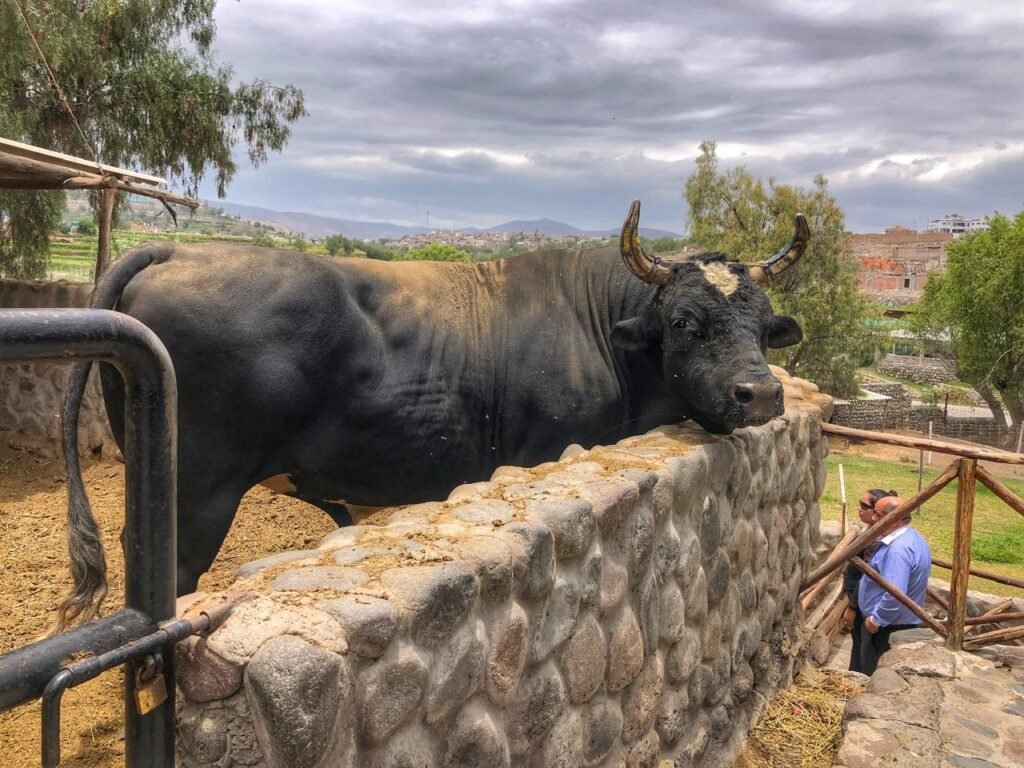
Really?! This mega bull is the replacement?
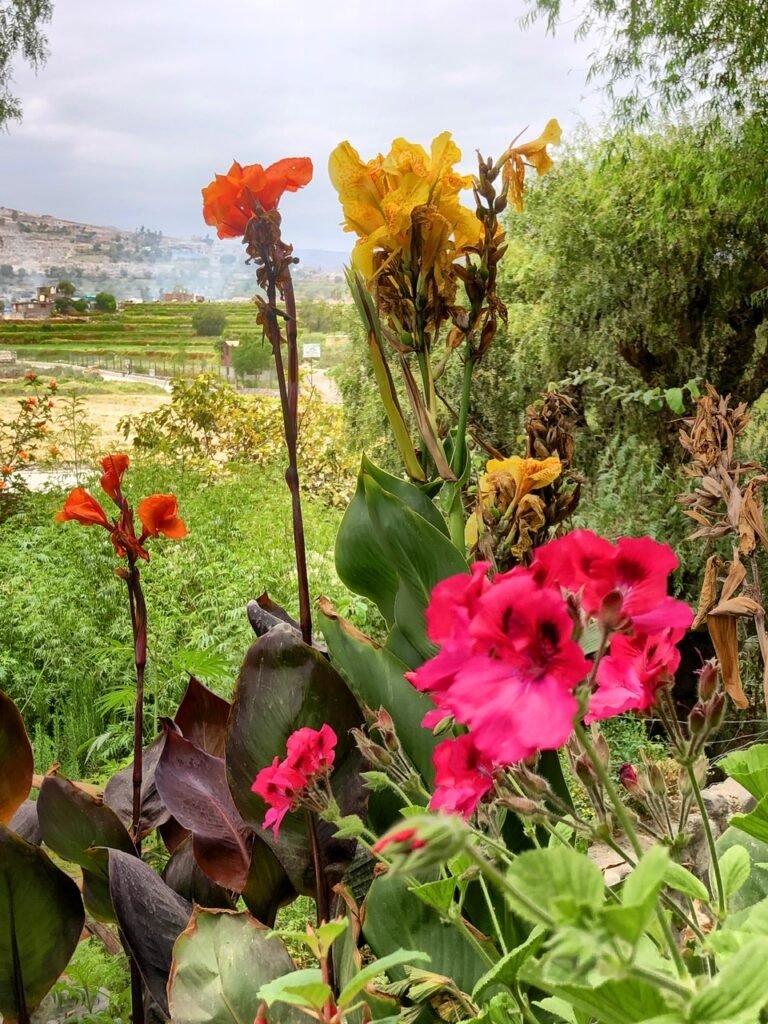
Mandy reluctantly looks at pretty flowers.
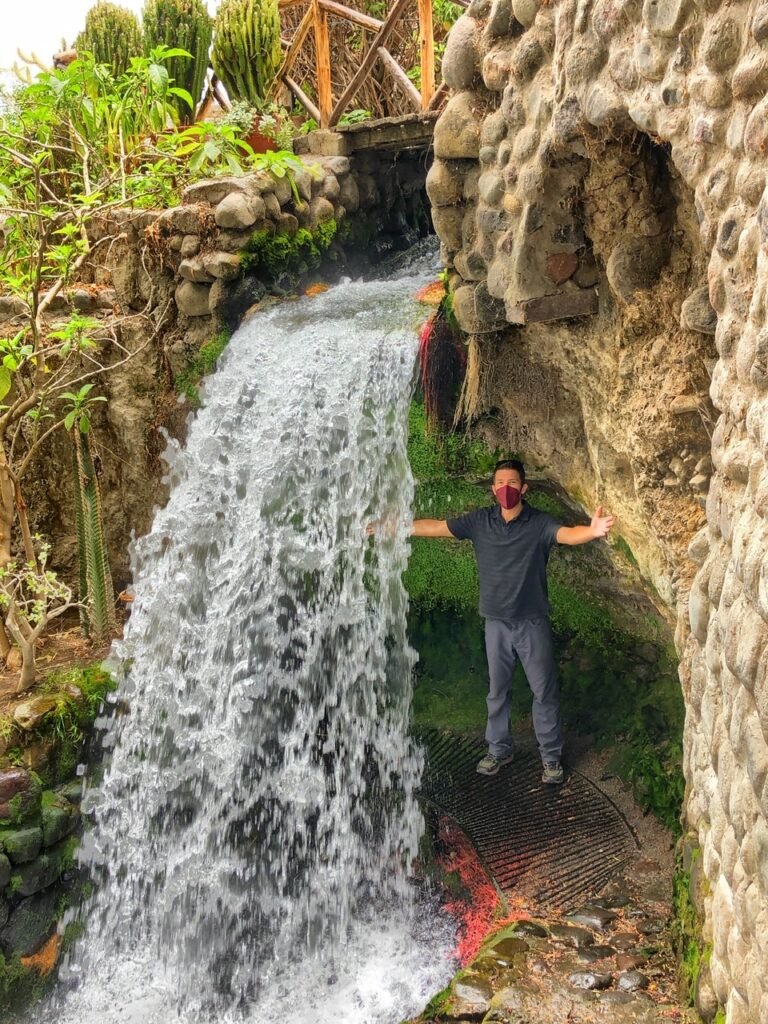
Greg tries to coerce Mandy behind the waterfall.
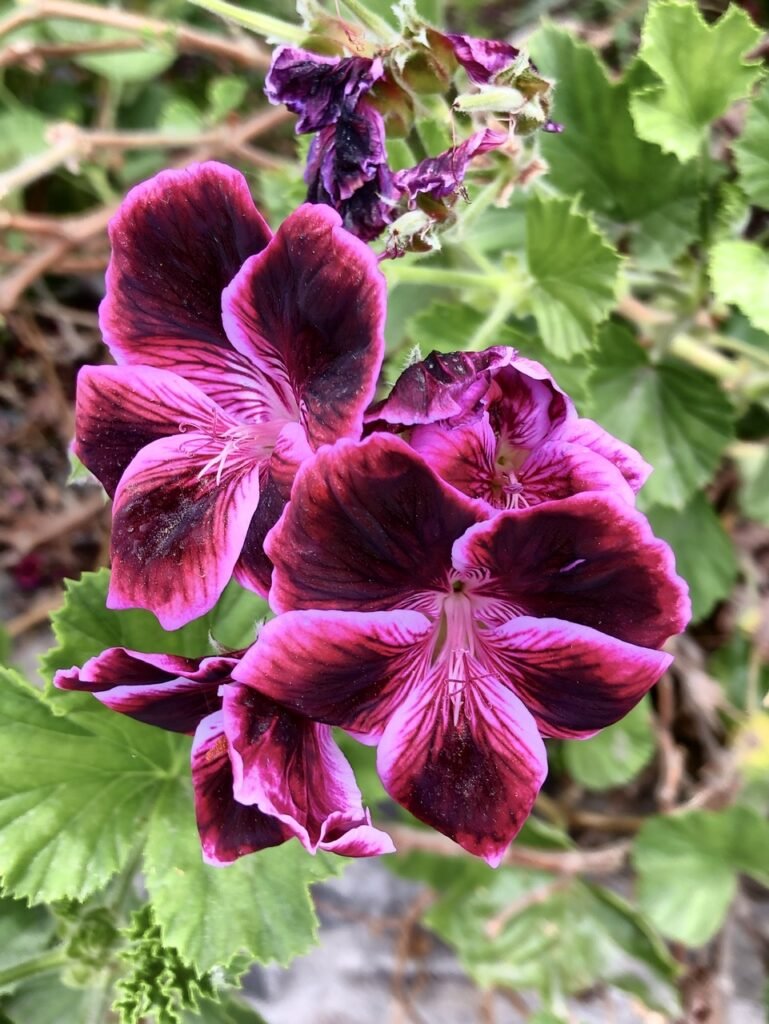
Wow!! Most beautiful geraniums ever!!

Like stepping back in time.
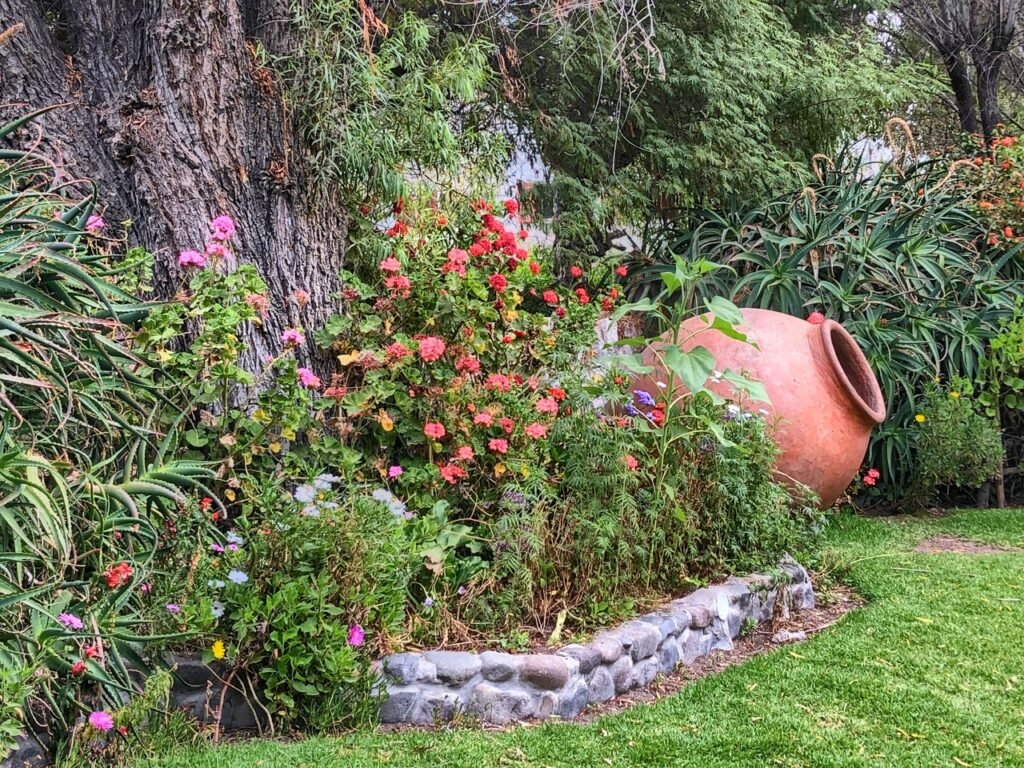
So many gorgeous flowers everywhere.
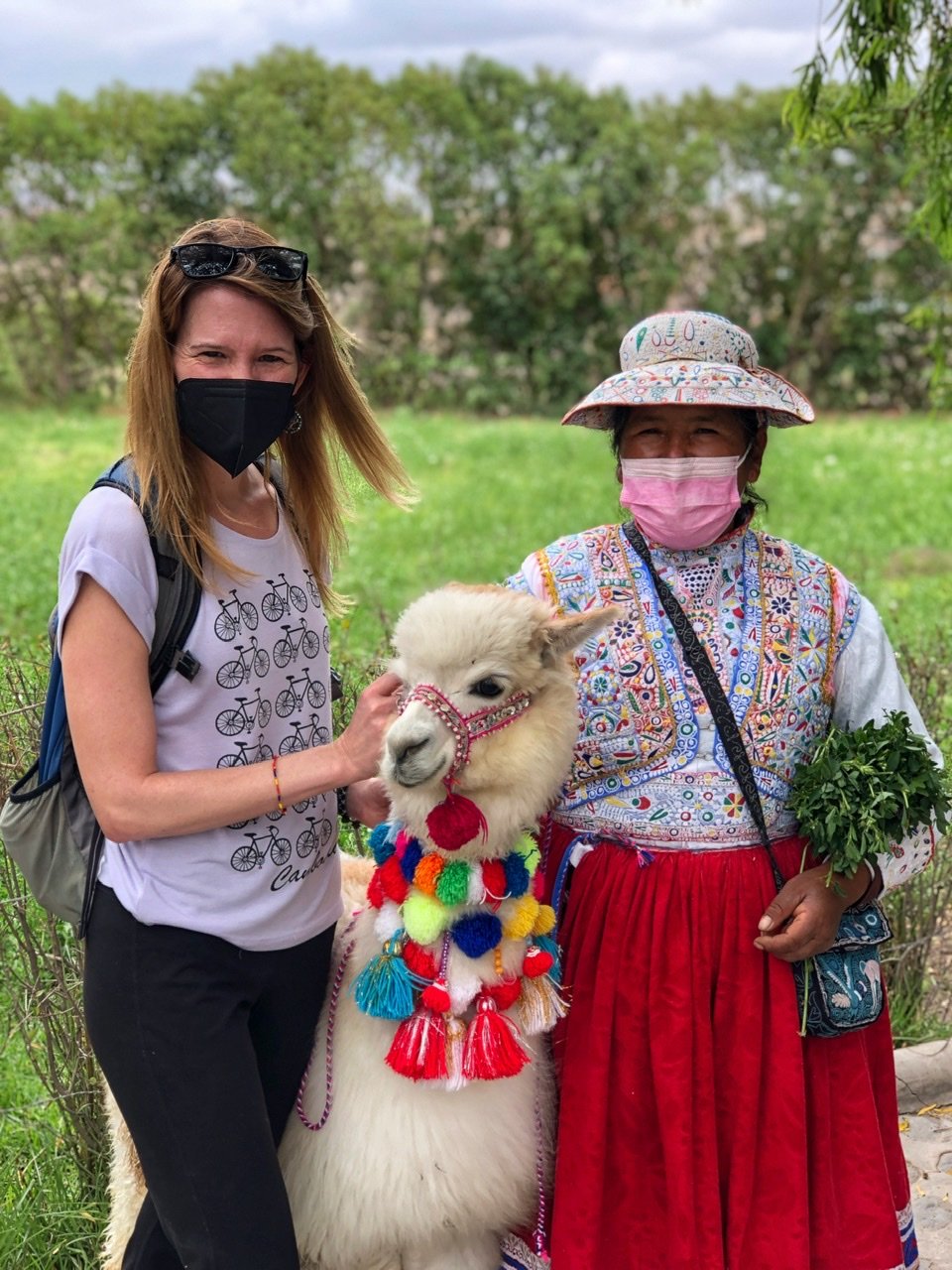
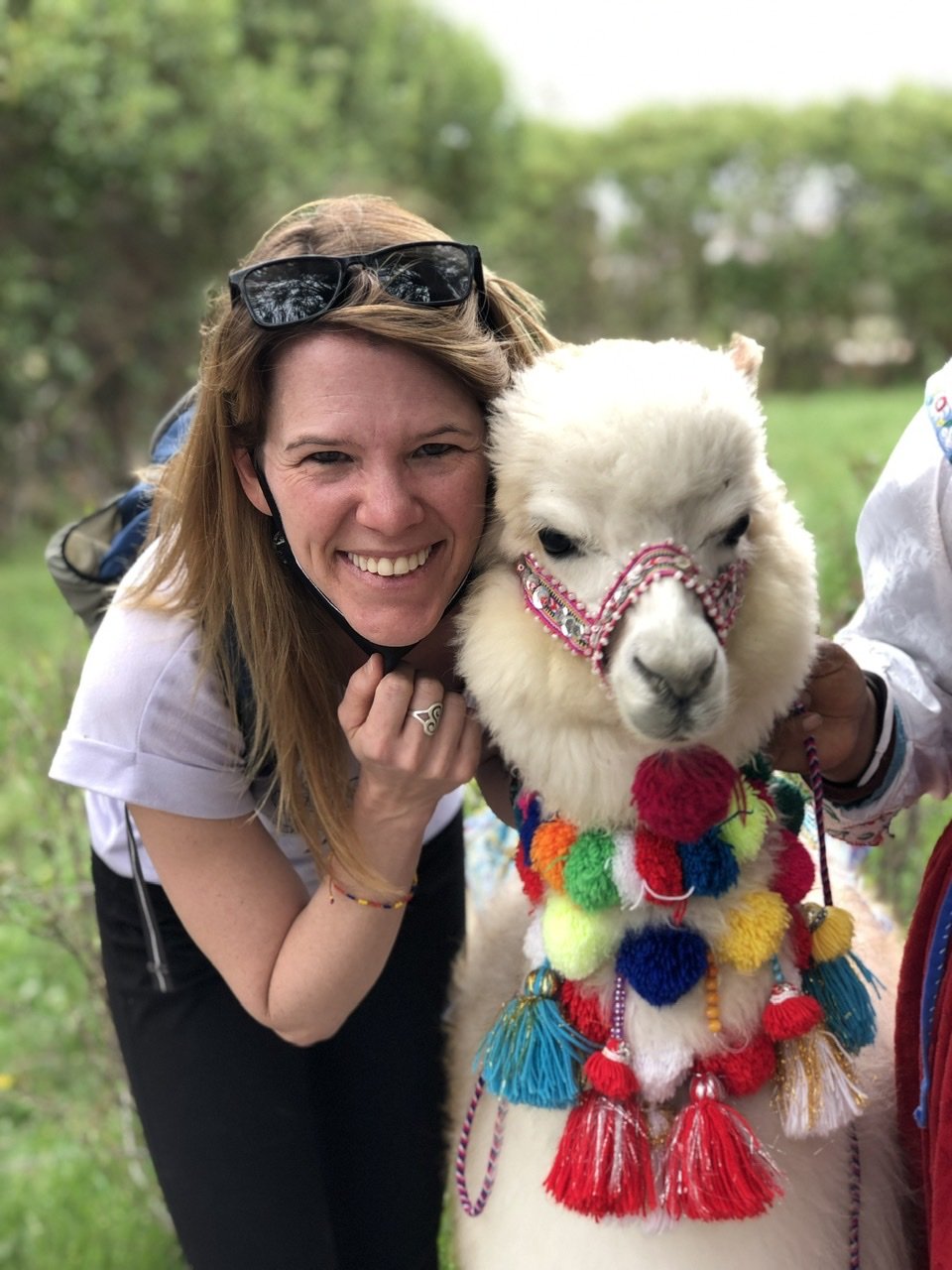
Oh thank goodness. Mandy found another friend. Two in fact. One human called Maria, who she towered over. This is not the norm for this 5,5 woman. This alpaca’s proper name was Lulu. She was 10 months old.
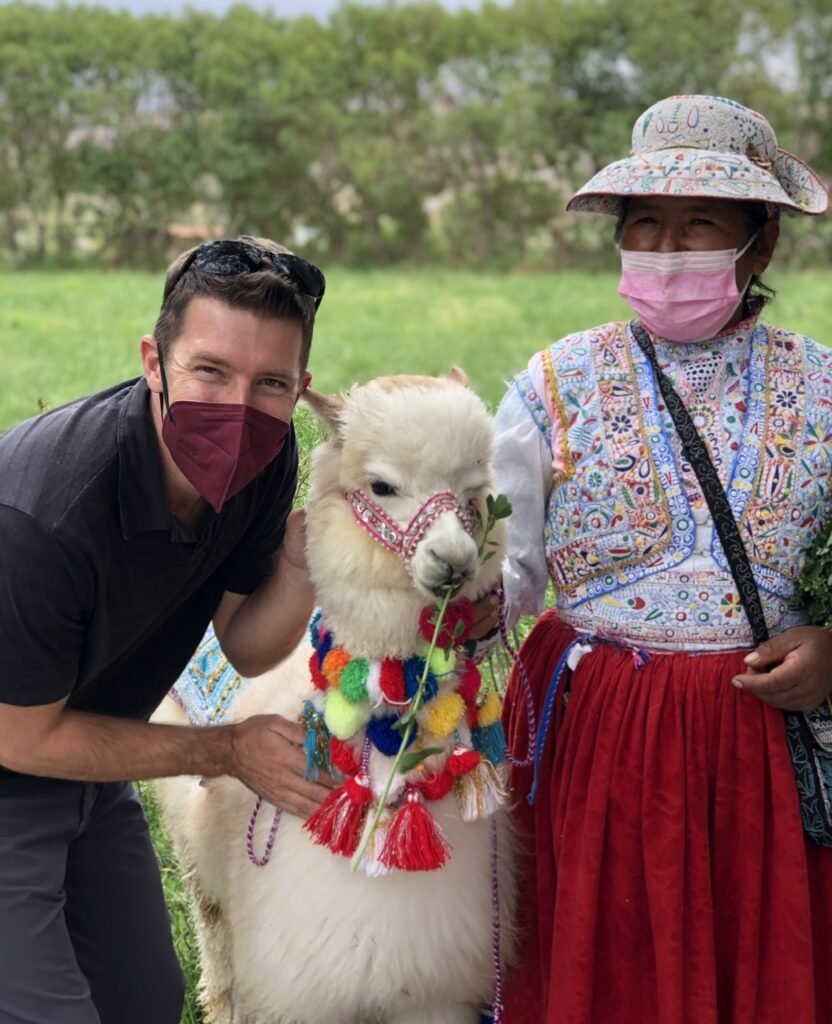
Ahh! So cute!!
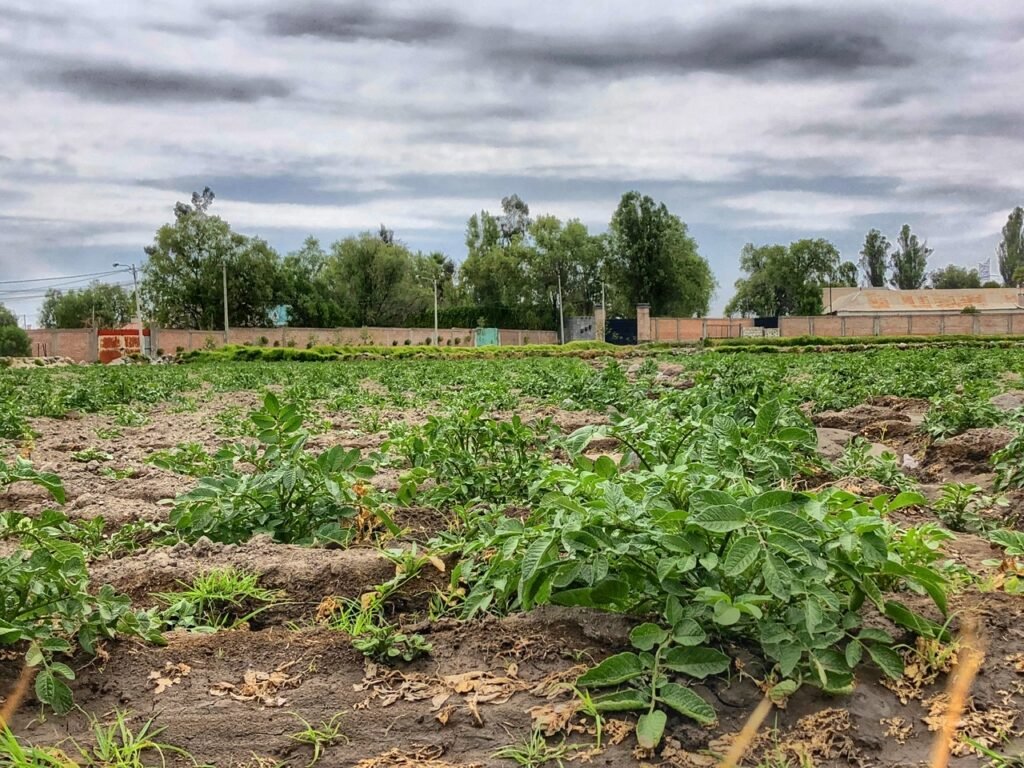
Can’t handle anymore cuteness!? Here’s a photo of a field of Peru’s most original crop. Who knows what it is? That’s right…the humble potato was domesticated in the South American Andes some 8,000 years ago and was only brought to Europe in the mid-1500s, from where it spread west and northwards, back to the Americas, and beyond. https://www.bbc.com/travel/article/20200302-the-true-origins-of-the-humble-potato


